5.1: The Demand Curve and Utility
5.1.1: Defining Utility
Utility is an economic measure of how valuable, or useful, a good or service is to a consumer.
Learning Objective
Define Utility
Key Points
- Utility is measured by comparing multiple options.
- Utility can be positive and negative.
- Ordinal utility ranks a series of preferences without measuring how much more valuable one option is than another. Cardinal utility measures how much more preferable one option is in comparison to another.
- Ordinal utility is generally the preferred method of measuring utility.
Key Terms
- cardinal
-
Describing a “natural” number used to indicate quantity (e.g., one, two, three), as opposed to an ordinal number indicating relative position.
- utility
-
The ability of a commodity to satisfy needs or wants; the satisfaction experienced by the consumer of that commodity.
- ordinal
-
Of a number, indicating position in a sequence.
Utility is a term used by economists to describe the measurement of “useful-ness” that a consumer obtains from any good or service. Utility may measure how much one enjoys a movie or the sense of security one gets from buying a deadbolt. The utility of any object or circumstance can be considered. Some examples include the utility from eating an apple, from living in a certain house, from voting for a specific candidate, or from having a given wireless phone plan. In fact, every decision that an individual makes in their daily life can be viewed as a comparison between the utility gained from pursuing one option or another .
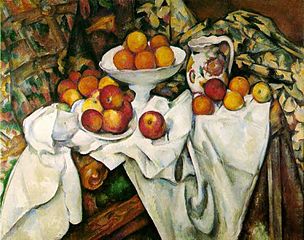
Apples and Oranges
Utility allows you to compare apples and oranges based on which you prefer.
Utility may be positive or negative with no effect on its interpretation. If one option gives
utility and another gives
, selecting the second is not, as it might seem, the “lesser of two evils,” but can only be interpreted as the better option.
Utility can be measured in one of two ways:
- Ordinal utility ranks a series of options in order of preference. This ranking does not show how much more valuable one option is than another, only that one option is preferable over another. An example of a statement reflecting ordinal utility is that “I would rather read than watch television. ” Generally, ordinal utility is the preferred method for gauging utility.
- Cardinal utility also ranks a series of options in order of preference, but it also measures the magnitude of the utility differences. An example of a statement reflecting cardinal utility is “I would enjoy reading three times more than watching television. ” Given how difficult it is to precisely measure preference, cardinal utility is rarely used.
5.1.2: Theory of Utility
The theory of utility states that, all else equal, a rational person will always choose the option that has the highest utility.
Learning Objective
Explain the Theory of Utility
Key Points
- The rationality assumption gives a basis for modeling human behavior and decision making.
- Utility includes every element of a decision.
- Rationality is dependent on a person’s individual preferences. Therefore, what might be a rational decision for one person may not be a rational decision for another.
Key Term
- Rational individual
-
A person who chooses the option that, all else equal, gives the greatest utility.
The theory of utility is based on the assumption of that individuals are rational. Rationality has a different meaning in economics than it does in common parlance. In economics, an individual is “rational” if that individual maximizes utility in their decisions. Whenever an individual is to choose between a group of options, they are rational if they choose the option that, all else equal, gives the greatest utility. Recalling that utility includes every element of a decision, this assumption is not particularly difficult to accept. If, when everything is taken into account, one decision provides the greatest utility, which is equivalent to meaning that it is the most preferred, then we would expect the individual to take that most preferred option. This should not necessarily be taken to mean that individuals who fail to quantify and measure every decision they make are behaving irrationally. Rather, this means that a rational individual is one who always selects that option that they prefer the most .

Consumer making a decision
When making an economically rational purchasing decision, a consumer must consider all of their personal preferences.
It is important to emphasize how rationality relates to a person’s individual preferences. People prioritize different things. For example one person may prioritize flavor while another person may value making healthy choices more. As a result the first person may choose a sugary cereal while the second may choose granola. Based on their preferences, both made the economically rational choice.
The rationality assumption gives a basis for modeling human behavior and decision making. If we could not assume rationality, it would be impossible to say what, when presented with a set of choices, an individual would select. The notion of rationality is therefore central to any understanding of microeconomics.
5.1.3: Marginal Utility
Marginal utility of a good or service is the gain from an increase or loss from a decrease in the consumption of that good or service.
Learning Objective
Define Marginal Utility
Key Points
- Marginal utility is measured on a per unit basis.
- Since an individual’s utility is rarely measured using cardinal means, calculating a product’s marginal value for an individual may be difficult.
- Instead of trying to calculate a product’s marginal value for an individual, economists assign dollar values to products based on their market price. This allows economists to estimate a product’s marginal value based on all the consumer’s preferences.
- The idea of marginal value is an important consideration when making production or purchasing decisions. A person should produce or purchase an additional item when the marginal utility exceeds the marginal cost.
Key Terms
- marginal
-
Of, relating to, or located at or near a margin or edge; also figurative usages of location and margin (edge).
- cardinal
-
Describing a “natural” number used to indicate quantity (e.g., one, two, three), as opposed to an ordinal number indicating relative position.
In economic terms, marginal utility of a good or service is the gain from an increase or loss from a decrease in the consumption of that good or service. The idea of marginal value is an important consideration when making production or purchasing decisions. A person should produce or purchase an additional item when the marginal utility exceeds the marginal cost .

Marginal Utility of Housing
The marginal utility of owning a second house is likely less than the marginal utility of owning the first house.
Marginal utility is measured on a per unit basis. When evaluating the marginal utility of any item, it is important to know in what unit utility is measured. The unit is based on the type of activity that you are trying to measure. If you are a consumer of potato chips, you might measure utility based on whether to buy another bag or have another hand full with your lunch. If you are a producer of potato chips, your marginal value might be defined by a pallet of potato chips. In general, marginal value should be measured based on the smallest unit of consumption or production related to the product in question.
It is also important to remember that utility is difficult to quantify since preferences vary based on the individual. Utility is rarely measured in terms of magnitude; utility is normally just about determining which option is the best choice. Since utility is rarely measured using cardinal means, it may seem difficult to determine a product’s marginal value. Economists get around this by substituting dollar values. While this may fail to capture a specific individual’s preferences and utility, it offers a good approximation based on everyone’s collective preferences as defined by the market.
5.1.4: Principle of Diminishing Marginal Utility
The principle of diminishing marginal utility states that as more of a good or service is consumed, the marginal benefit of the next unit decreases.
Learning Objective
Explain diminishing marginal utility
Key Points
- If you consume too much, the marginal utility of a good or service can become negative.
- In some circumstances, the marginal utility of producing or consuming an additional unit will increase for a short period of time. Generally there will be a “tipping point” at which marginal utility will then decrease.
- Generally these exceptions occur when what is being consumed is a component of a larger whole.
Key Terms
- utility
-
The ability of a commodity to satisfy needs or wants; the satisfaction experienced by the consumer of that commodity.
- marginal benefit
-
The extra benefit received from a small increase in the consumption of a good or service. It is calculated as the increase in total benefit divided by the increase in consumption.
The principle of diminishing marginal utility states that as an individual consumes more of a good, the marginal benefit of each additional unit of that good decreases.
The concept of diminishing marginal utility is easy to understand since there are numerous examples of it in everyday life. Imagine it is a hot summer day and you are hungry, so you get some ice cream. The first bite is great and so is the second. But with each spoonful, your hunger decreases and you become cooler. So while the last bite might still be good, it is probably not as satisfying as the first. This is a simple illustration of diminishing marginal utility .
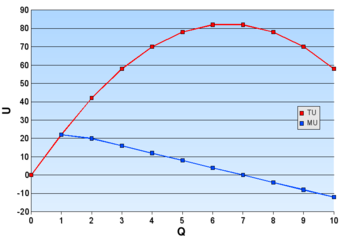
Total and marginal utility
As you can see in the chart, the more of a good you consume, the further its marginal utility decreases.
Negative Marginal Utility
While there are some circumstances where there will always be some marginal utility to producing or consuming more of a good, there are also circumstances where marginal utility can become negative. For example, while some antibiotics may be useful in curing diseases. However, if you take too much you can become sick or resistant to the drugs which could lead to future illnesses being incurable. So it is important to remember that “diminishing” does not necessarily mean to zero; you can have too much of a good thing.
Exceptions to the General Rule
This concept suggests a uniform steady decline of marginal utility, but that may not always be the case. There can be situations in which one might gain more utility from consuming a later unit of a good than from earlier consumption. If you are going on a date, for example, getting one ticket to a concert will have some utility but the second arguably has more because it enhances the value of the first.
Generally these exceptions occur when what is being consumed is a component of a larger whole. While utility may increase for a period, there is usually a “tipping point” where afterwards marginal utility decreases. Getting a third ticket for your date will have low marginal utility than the second.
5.2: Theory of Consumer Choice
5.2.1: Introducing the Budget Constraint
Budget constraints represent the plausible combinations of products and services a buyer can purchase with the available capital on hand.
Learning Objective
Discuss the role of the budget set and indifference curve in determining the choice that gives a consumer maximum satisfaction
Key Points
- Consumers analyze the optimal way in which to leverage their purchasing power to maximize their utility and minimize opportunity costs through employing trade-offs.
- The way economists demonstrate this arithmetically and visually is through generating budget curves and indifference curves.
- Budget curves indicate the relationship between two goods relative to opportunity costs, which defines the value of each good relative to one another.
- Indifference curves underline the way in which a given consumer interprets the value of each good relative to one another, demonstrating how much of ‘good
‘ is equivalent in utility to a certain quantity of ‘good
‘ (and vice versa). - Through utilizing these economic tools, economists can predict consumer behavior and consumers can maximize their overall utility based upon their budget constraints.
Key Terms
- Trade-offs
-
Any situation in which the quality or quantity of one thing must be decreased for another to be increased.
- utility
-
The ability of a commodity to satisfy needs or wants; the satisfaction experienced by the consumer of that commodity.
Example
- Pretend you have $100 to spend on food for the month. You have a wide variety of options, but some will provide you with higher opportunity costs than others. You could purchase enough bread, rice, milk and eggs to feed yourself for the full month or you could buy premium cut steak and store-prepared dinners by the pound (which would last about one week). The opportunity cost of the former is the high quality foods which have the convenience factor of already being prepared for you while the opportunity cost of the latter is having enough food to feed yourself for the entire month. In this circumstance the decision is easy, and the trade off will be sacrificing convenience and high quality food for the ability to have enough food on the table over the course of the whole month.
The concept of budget constraints in the field of economics revolves around the idea that a given consumer is limited in consumption relative to the amount of capital they possess. As a result, consumers analyze the optimal way in which to leverage their purchasing power to maximize their utility and minimize opportunity costs. This is achieved through using budget constraints, which represent the plausible combinations of products and/or services a buyer is capable of purchasing with their capital on hand.
Trade-offs
To expand upon this definition further, the business concept of opportunity cost via trade-offs is a central building block in understanding budget constraints. An opportunity cost is defined as the foregone value of the next best alternative in a given action. To apply this to a real-life situation, pretend you have $100 to spend on food for the month. You have a wide variety of options, but some will provide you with higher opportunity costs than others. You could purchase enough bread, rice, milk and eggs to feed yourself for the full month or you could buy premium cut steak and store-prepared dinners by the pound (which would last about one week). The opportunity cost of the former is the high quality foods which have the convenience factor of already being prepared for you while the opportunity cost of the latter is having enough food to feed yourself for the entire month. In this circumstance the decision is easy, and the trade off will be sacrificing convenience and high quality food for the ability to have enough food on the table over the course of the whole month.
Budget Curves and Indifference Curves
Understanding these trade-offs underlines the true function of budget constraints in economics, which is identifying which consumer behaviors will maximize utility. Consumers are inherently equipped with an infinite demand and a finite pool of resources, and therefore must make budgetary decisions based on their preferences. The way economists demonstrate this arithmetically and visually is through generating budget curves and indifference curves.
Budget curves: This indicates the relationship between two goods relative to opportunity costs, which defines the value of each good relative to one another. For example, on the figure provided a quantity of 5 for ‘good
‘ is identical in price (economic value) as a quantity of 7 for ‘good
‘. This demonstrates the trade-off ratio between the two available products or services. It is important to keep in mind that prices and valuations of goods are constantly changing, and that the ratio between any two goods is not fixed over the long-term for most products/services.

Budget Curve
A budget curve demonstrates the relationship between two goods relative to opportunity costs, essentially deriving the relative value of each good based on quantity and utility. Keep in mind that moving from one point on the in to another is trading off ‘
‘ amount of one good for ‘
‘ amount of another.
Indifference curves: Indifference curves underline the way in which a given consumer interprets the value of each good relative to one another, demonstrating how much of ‘good
‘ is equivalent in utility to a certain quantity of ‘good
‘ (and vice versa). Any point along the indifference curve will represent indifference to the consumer, or simply put equivalent preference for one combination of goods or the other. In the figure it is clear that the budget curve has been included in conjunction with the indifference curves, which allows insight as to the ideal actual quantity of each good is optimal for this specific consumer.

Indifference Curves
Indifference curves are designed to represent an equal perception of overall value in a given basket of goods relative to a specific consumer. That is to say that each point along the curve is considered by the consumer of equivalent value despite alterations in the quantity of each good, as these trade-offs are consider of equal value and thus indifferent.
Through utilizing these economic tools, economists can predict consumer behavior and consumers can maximize their overall utility based upon their budget constraints.
5.2.2: Mapping Preferences with Indifference Curves
Economists mapping consumer preferences use indifference curves to illustrate a series of goods that represent equivalent utility.
Learning Objective
Describe the indifference curves for goods that are perfect substitutes and complements
Key Points
- Indifference curves illustrate bundles of goods that provide the same utility.
- An economist can derive conclusions based upon the properties of the illustration. In framing these implications it is useful to identify the two potential extremes of substitute goods and complementary goods.
- The comparison between the goods demonstrates the relative utility one has compared to another, and the way in which consumers will act when posed with a decision between various products and services.
- The comparison between the goods demonstrates the relative utility one has compared to another, and the way in which consumers will act when posed with a decision between various products and services.
Key Terms
- substitute
-
A good with a positive cross elasticity of demand, meaning the good’s demand is increased when the price of another is increased.
- Complement
-
A good with a negative cross elasticity of demand, meaning the good’s demand is increased when the price of another good is decreased.
A critical input to understanding consumer purchasing behaviors and the general demand present in a given market or economy for specific goods and services is the identification of consumer preferences. Consumer preference varies substantially from individual to individual and market to market, requiring comprehensive economic observation of consumer choices and behaviors. One of the primary tools leveraged by economists mapping consumer preferences is the indifference curve, which illustrates a series of bundled goods in which a consumer is indifferent. A consumer would be just as happy with any combination of Good X and Good Y on the curve . This could synonymous to saying baskets of goods that provide the same utility.

Indifference Curve
A consumer will be just as happy with any combination of Good X and Y on indifference curve I1, though s/he will prefer any bundle on indifference curve I2 or I3.
These indifference curves, when mapped graphically alongside other curves, is called an indifference map. A key consideration in creating any indifference map is what relative preferences should be isolated. While it is possible to create a complex array of preference maps to compare more than two products/services, each specific standard indifference map will be about creating a benchmark between two. For example one could compare relatively similar goods/services (i.e. apples vs. oranges) or dramatically different goods/services (i.e. university training vs. automobile purchasing). These two items being compared represent the x and y axis of a indifference map. A consumer will always prefer to be on the indifference curve farthest from the origin.
Implications of Indifference Maps
After constructing the required inputs to generate a comprehensive indifference map, an economist can derive conclusions based upon the properties of the illustration. In framing these implications it is useful to identify the two potential extremes that can be outlined via with indifference curves:
- Perfect Substitutes: To understand what a indifference curves will look like when products are perfect substitutes, please see . These lines are essentially perfectly straight, and that demonstrates that the relative utility of ‘Good X’ compared to that of ‘Good Y’ is equivalent regardless of the amount in question. It is reasonable to assume in this scenario that purchasing all of one or all of the other will not decrease the overall satisfaction of the consumer. Perfect substitutes are often homogeneous goods. A consumer with no preference between Burger King and McDonald’s, for example, might consider them perfect substitutes and be indifferent to spending all of their fast food money on one or the other.
- Perfect Complements: The opposite of a perfect substitute is a perfect complement (see ), which is illustrated graphically through curves with perfect right angles at the center. These right angles, and the subsequent straight horizontal and vertical lines, demonstrate that ‘Good X’ and ‘Good Y’ are inherently tied to one another and that the consumption of one is dependent upon the consumption of the other. An example of complementary goods might be university tuition and academic textbook purchases, an automobile and automobile insurance, or a cable and a television.
Combining an understanding of these inputs with the extremes demonstrated an indifference map, economists are able to draw meaningful conclusions regarding consumer choices and purchasing behaviors in the context of two goods. The comparison between the goods demonstrates the relative utility one has compared to another, and the way in which consumers will act when posed with a decision between various products and services.

Perfect Substitute Indifference Curve
In this particular series of indifference curves it is clear that ‘Good X’ and ‘Good Y’ are perfect substitutes for one another. That is to say that the utility of one is identical to the utility of the other across all quantities represented on the map.

Perfect Complement Indifference Curve
The perfect right angle in this series of indifference curves implies that the utility of ‘Good X’ and ‘Good Y’ are entirely interdependent. This is to say that in order to enjoy one good it is necessary to also have the other.
5.2.3: Properties of Indifference Curves
Almost all indifference curves will be negatively sloped, convex, and will not intersect.
Learning Objective
Analyze the properties that are common to many indifference curves
Key Points
- The concept of an indifference curve is predicated on the idea that a given consumer has rational preferences in regard to the purchase of groupings of goods, with a series of key properties that define the process of mapping these curves.
- Indifference curves only reside in the non-negative quadrant of a two-dimensional graphical illustration (or the upper right).
- Indifference curves are always negatively sloped. Essentially this assumes that the marginal rate of substitution is always positive.
- All curves projected on the indifference map must not intersect in order to ensure transitivity.
- Nearly all indifference lines will be convex, or curving inwards at the center (towards the bottom left).
Key Terms
- Transitive
-
Having the property that if an element
$x$ is related to$y$ and$y$ is related to$z$ , then$x$ is necessarily related to$z$ . - utility
-
The ability of a commodity to satisfy needs or wants; the satisfaction experienced by the consumer of that commodity.
Indifference curves trace the combination of goods that would give a consumer a certain level of utility. The indifference curve itself represents a series of combinations of quantities of goods (generally two) that a consumer would be indifferent between, or would value each of them equally in regards to overall utility. Indifference curves allow economists to predict consumer purchasing behaviors based upon utility maximization for a bundle of goods within the context of a given consumer’s budget constraints and preferences.
Properties of Indifference Curves
The concept of an indifference curve is predicated on the idea that a given consumer has rational preferences in regard to the purchase of groupings of goods, with a series of key properties that define the process of mapping these curves:
- Indifference curves only reside in the non-negative quadrant of a two-dimensional graphical illustration (or the upper right). This assumes that negative quantities are meaningless – one can’t consume a negative amount of a good.
- Indifference curves are always negatively sloped. This is based on the assumption that a consumer is always better off consuming more of a good, so as quantity consumed of one good increases, total satisfaction would increase if not offset by a decrease in the quantity consumed of another good. This also assumes that the marginal rate of substitution is always positive.
- All curves projected on the indifference map must also be transitive to ensure that if
is preferred to
and
is preferred to
,
is not also preferred to
. This is manifested in indifference curves that never intersect. - Nearly all indifference lines will be convex, or curving inwards at the center (towards the bottom left). This demonstrates that increasingly high quantities of one good over another have a cost in respect to their overall utility per unit (diminishing returns). It is technically possible for indifference curves to be perfectly straight as well, which would imply that the two goods are identical (perfect substitutes).
Combining these various properties, one can highlight a number of critical implications of consumer purchasing behavior and the concept of utility. Consumers naturally desire a bundle of goods that is varied (hence the convex curves for most comparisons) in order to maximize their utility. Similarly, all indifference curves will naturally identify diminishing rates of substitution as the quantity increases for a certain good compared to another, and can create demand projections of prospective supply.
5.2.4: Impact of Income on Consumer Choices
One of the central considerations for a consumer’s consumption choice is income or wage levels, and thus their budgetary constraints.
Learning Objective
Break down changes in consumption into the income effect and the wealth effect
Key Points
- The basic premise behind the income effect is that varying income levels will determine different quantities and balanced baskets along the provided indifference curves for any two goods being compared.
- These differences in quantity reflect the increase or decrease an a given individual’s purchasing power, thus the income effect could be summarized as the increase in relative utility captured by a consumer with more monetary power.
- Income effects on consumer choice grow more complex as the type of good changes, as different product and services demonstrate different properties relative to both other products/services and a consumers preferences and utility.
- The four key types of goods to consider are normal goods, inferior goods, complements and substitutes.
Key Terms
- Inferior goods
-
A good that decreases in demand when consumer income rises; having a negative income elasticity of demand.
- Income Effect
-
The change in consumption choices due to changes in the amount of money available for an individual to spend.
- Wealth Effect
-
The change in an individual’s consumption choices due to changes in perception of how rich s/he is.
Consumer choices are predicated on various economic circumstances, and recognizing the relationship between these circumstances and an individual’s purchasing behavior allows economists to recognize and predict consumer choice trends. One of the central considerations for a consumer in deciding upon their purchasing behaviors is their overall income or wage levels, and thus their budgetary constraints. These budgetary constraints, when applied to a series of products and services, can be optimized to capture the most utility for the consumer based on their purchasing power.
Income from a Consumer Theory Perspective
The simplest way to demonstrate the effects of income on overall consumer choice, from the viewpoint of Consumer Theory, is via an income-consumption curve for a normal good(see ). The basic premise behind this curve is that the varying income levels (as illustrated by the green income line curving upwards) will determine different quantities and balanced baskets along the provided indifference curves for the two goods being compared in this graph. These differences in quantity reflect the increase or decrease an a given individual’s purchasing power, thus the income effect could be summarized as the increase in relative utility captured by a consumer with more monetary power.

Income-Consumption Curve
Simply put, increases or decreases in income will alter the optimal quantity (and thus relative utility) of a given basket of goods for a specific consumer.
The wealth effect differs slightly from the income effect. The wealth effect reflects changes in consumer choice based on perceived wealth, not actual income. For example, if a person owns a stock that appreciates in price, they perceive that they are wealthier and may spend more, even though they have not realized those gains so their income has not increased.
Effects of Income on Different Goods
Income effects on consumer choice grow more complex as the type of good changes, as different product and services demonstrate different properties relative to both other products/services and a consumers preferences and utility. As a result, it is useful to outline the differences in income effects on normal, inferior, complementary and substitute goods:
- Normal:A normal good is a good with incremental increases or decreases in utility as quantity changes, demonstrating a predictable and simple linear relationship as income increases or decreases. demonstrates a graphical representation of the effects of income changes upon preference map.
- Inferior:Inferior goods, or goods that are less preferable, will demonstrate inverse relationships with income compared to normal goods. That is to say that an increase in income will not necessarily result in an increase in quantity for the inferior good, as the consumer derives minimal utility in purchasing the inferior good compared to other goods. Inferior goods are often sacrificed as income rises and consumers gain more choice/options. This can be represented in .
- Complementary: Complementary goods are goods that are interdependent in consumption, or essentially goods that require simultaneous consumption by the consumer. An example of this would be like purchasing an automobile and car insurance, the consumption of one requires the consumption of the other. As income increases, these will increase relative to one another (as a ratio). demonstrates this concept in graphical form.
- Substitutes: Perfect substitutes are essentially interchangeable goods, where the consumption of one compared to another has no meaningful impact on the consumer’s utility derived. Substitutes are goods that a consumer cannot differentiate between in terms of the need being filled and the satisfaction obtained. Income increases will thus affect the consumption of these goods interchangeably, resulting in increase in the quantity of either or both.
In merging Consumer Theory and consumer choices with income level, the primary takeaway is that an increase in income will increase the prospective utility that consumer can acquire in the market. Understanding how this applies in a general fashion, alongside the specific circumstances dictating specific types of goods, it becomes fairly straight-forward to predict consumer purchasing behaviors at differing income levels.

Income Levels and Inferior Goods
This graph demonstrates the inverse relationship between income and the consumption of inferior goods. As income rises, the quantity consumed of ‘X1’ decreases. This illustrates increased variance in consumer choice as income rises.

Income Effect on Complementary Goods
In this graphical depiction of income increases, the consumption of these two goods are complementary and thus interdependent.
5.2.5: Impact of Price on Consumer Choices
The demand curve shows how consumer choices respond to changes in price.
Learning Objective
Construct the demand curve using changes in consumption due to price changes
Key Points
- For normal goods or services, demand is illustrated with a downward sloping curve, where the quantity on the x-axis will generally increase as the price on the y-axis decreases (and vice versa).
- As the demand curve implies, price is the central driving force behind a decision to purchase a given product or service.
- A critical consideration of product/service pricing is the price elasticity of a given good, which indicates how responsive demand is to a change in price.
- Using demand curves, economists can project the impact of a price change on the consumer choices in a given market.
- The quantity demanded may change in response to both to shifts in demand (and the creation of a new demand curve, as demonstrated in and movements along the established demand curve.
Key Term
- elasticity
-
The sensitivity of changes in a quantity with respect to changes in another quantity.
In almost all cases, consumer choices are driven by prices. As price goes up, the quantity that consumers demand goes down. This correlation between the price of goods and the willingness to make purchases is represented clearly by the generation of a demand curve (with price as the y-axis and quantity as the x-axis). The construction of demand, which shows exactly how much of a good consumers will purchase at a given price, is defining of consumer choice theory.
Deriving Overall Demand
The generation of a demand curve is done by calculating what price consumers are willing to pay for a given quantity of a good or service. For normal goods or services, demand is illustrated with a downward sloping curve, where the quantity on the x-axis will generally increase as the price on the y-axis decreases (and vice versa). The quantity demanded may change in response to both to shifts in demand (and the creation of a new demand curve, as demonstrated in ) and movements along the established demand curve. A demand shift usually takes place when an external factor increases or decreases demand across the board, while a movement upwards or downwards on the curve is indicative of a change in the good’s price.

Demand Shifts
This graph demonstrates a shift in overall demand in the market, where the generation of a new parallel demand curve is required to accurately represent consumer choices.
As the demand curve implies, price is often the central driving force behind a decision to purchase a given product or service. Consumers must weigh the overall utility they can capture by making a purchase and benchmark that against their overall monetary resources to optimize their purchasing decisions. This practice regulates the price companies can set for their products and services, as the income effects and the prospective substitutions (substitution effect) will drive consumer purchase towards purchases that create the most value for themselves.
Price Elasticity
A critical consideration of product/service pricing is the price elasticity of a given good, which indicates how responsive demand is to a change in price. Price elasticity is essentially a measurement of how much any deviations in price will drive the overall quantity purchased up or down, underlining to what extent consumer purchasing decisions will be dictated by pricing. The figure pertaining to price elasticity shows how the slope of the demand curve will change depending on the degree of price sensitivity in the marketplace for a good. A highly elastic good will see consumers much less likely to purchase when prices are high and much more likely to purchase when prices are low, while a good with low elasticity will see consumers purchasing the same quantity regardless of small price changes.
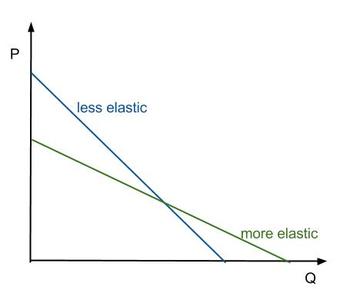
Price Elasticity
As this graph demonstrates, the slope of the demand curve will vary as a direct result of how elastic consumer purchasing behaviors will be compared to price changes.
Using demand curves, economists can project the impact of a price change on the consumer choices in a given market.
5.2.6: Deriving the Demand Curve
The law of demand pursues the derivation of a demand curve for a given product that benchmarks the relative prices and quantities desired.
Learning Objective
Explain how Giffen goods violate the law of demand
Key Points
- The derivation of demand is a useful tool in this pursuit, often combined with a supply curve in order to determine equilibrium prices and understand the relationship between consumer needs and what is readily available in the market.
- The inherent relationship between the price of a good and the relative amount of that good consumers will demand is the fulcrum of recognizing demand curves in the broader context of consumer choice and purchasing behavior.
- Generally speaking, normal goods will demonstrate a higher demand as a result of lower prices and vice versa.
- Giffen goods are a situation where the income effect supersedes the substitution effect, creating an increase in demand despite a rise in price.
- Neutral goods, unlike Giffen goods, demonstrate complete ambivalence to price. That is to say that consumer swill pay any price to get a fixed quantity.
Key Terms
- Derivation
-
The operation of deducing one function from another according to some fixed law, called the law of derivation, as the of differentiation or of integration.
- Giffen good
-
A good which people consume more of as only the price rises; Having a positive price elasticity of demand.
The law of demand in economics pertains to the derivation and recognition of a consumer’s relative desire for a product or service coupled with a willingness and ability to pay for or purchase that good. Consumer purchasing behavior is a complicated process weighing varying products/services against a constantly evolving economic backdrop. The derivation of demand is a useful tool in this pursuit, often combined with a supply curve in order to determine equilibrium prices and understand the relationship between consumer needs and what is readily available in the market.
Deriving Demand Curves
Despite a wide array of prospective goods and services in a constantly altering economic environment, the law of demand pursues the derivation of a demand curve for a given product that benchmarks the relative prices and quantities desired by consumers in a given marketplace. The inherent relationship between the price of a good and the relative amount of that good consumers will demand is the fulcrum of recognizing demand curves in the broader context of consumer choice and purchasing behavior.
Generally speaking, normal goods will demonstrate a higher demand as a result of lower prices and vice versa. The derivation of demand curves for normal goods is therefore relatively predictable in respect to the direction of the slope on a graph (see ). The downward slope represented in this figure underline the critical principle that a given price point will reflect a given quantity demanded by a given marketplace, allowing suppliers and economists to measure the value of a product/service based on a price/quantity analysis of consumer purchasing behaviors.
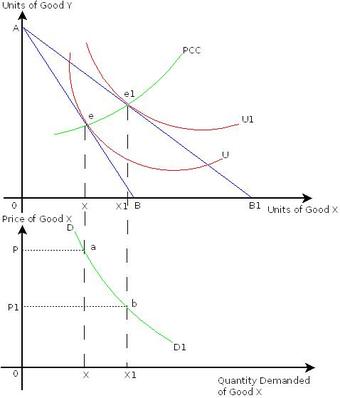
Deriving the Demand Curve (Normal Goods)
This illustration demonstrates the way in which economists can identify a series of prices and quantities for goods demanded, which ultimately represents the overall demand curve for a given product/service.
One important consideration in demand curve derivation is the differentiation between demand curve shifts and movement along the curve itself. Movement along the curve itself is the identification of what quantity will be purchased at different price points. This means that the factors that underlie consumer desire for the product remains constant and consistent, but the quantity or price alters to a new point along the established curve. Alternatively, sometimes external factors can shift the actual demand for a given good, pushing the demand curve outwards to the right and up or inwards down and left. This represents a substantial change in the actual demand for that product, as opposed to a quantity or price shift at a fixed demand level.
Exceptions: Giffen Goods and Neutral Goods
With the concept of general demand curves in mind, it is important to recognize that some goods do not conform to the traditional assumption that higher prices will always demonstrate lower demand. Giffen goods and neutral goods break this rule, with the former demonstrating an increase in demand as a result of a price rise (see ) and the latter demonstrating indifference to price in regards to the quantity demanded (illustrated as a completely vertical demand curve):
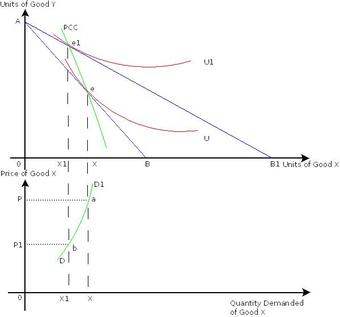
Demand Curve for Giffen Goods
Giffen goods are essentially goods that demonstrate an increase in demand as a result of an increase in price, generally considered counter-intuitive in traditional economic models. This graph illustrates the derivation of a demand curve for these goods.
- Giffen Goods – Giffen goods are a situation where the income effect supersedes the substitution effect, creating an increase in demand despite a rise in price. Goods such as high-end luxury items like expensive fashion often demonstrate this type of counter-intuitive trend, where the high price of an item is attractive to the consumer for the sake of displaying wealth.
- Neutral Goods – Neutral goods, unlike Giffen goods, demonstrate complete ambivalence to price. That is to say that consumers will pay any price to get a fixed quantity. These goods are often necessities, defying the standard law of demand due to the fact that they must be purchased regardless of price/situation. A good example of this is water or healthcare, where not getting what is required will have dramatic consequences.
5.2.7: Applications of Principles on Consumer Choices
The income effect and substitution effect combine to create a labor supply curve to represent the consumer trade-off of leisure and work.
Learning Objective
Explain the labor-leisure tradeoff in terms of income and substitution effects
Key Points
- Economics assumes a population of rational consumers, subjected to the complexities of modern economics while they attempt to maximize the utility obtainable within their income range.
- The income effect says that a consumers overall income level will have an effect on the quantities of goods that consumer will purchase.
- The substitution effect, similar to the income effect, identifies ways in which consumer purchasing power will alter the relative quantities of goods/services purchased by consumers at varying income levels and budgetary constraints.
- Combining the substitution effect and the income effect, one can derive an overall labor-leisure trade-off based on a given consumers purchasing power (income) relative to the price of necessary bundles of goods (substitution effect).
- A rational consumer will begin to work less hours after meeting their consumption requirements in order to capture the value of leisure (and enjoy their income in a meaningful way).
Key Terms
- substitution effect
-
The change in demand for one good that is due to the relative prices and availability of substitute goods.
- purchasing power
-
The amount of goods and services that can be bought with a unit of currency or by consumers.
- Income Effect
-
The change in consumption resulting from a change in real income.
Economics assumes a population of rational consumers, subjected to the complexities of modern economics while they attempt to maximize the utility obtainable within their income range. Central principles to analyzing consumer actions and choices are income effect and the substitution effect, which ultimately generate a labor supply to illustrate the labor-leisure trade-off for consumers.
Income Effect
The income effect needs two simple inputs: the average price of goods and the consumer’s income level. This creates a relative buying power, which will play a substantial role in the quantity of goods purchased. Predicting consumer choice requires inputs on consumer purchasing power and the goods in which they are deciding between. In we are comparing ‘Good X’ and ‘Good Y’ to identify how a change in income will alter the overall amount of each good would likely be purchased along a series of indifference curves (see Boundless atom on ‘Indifference Curves’). This graphical representation of a consumer’s income (I) and budget constraints (BC) underlines the variance in quantity of ‘Good X’ and ‘Good Y’ that will be demanded dependent upon income circumstance. Naturally, a higher income will result in a shift towards increase in quantity for many consumable goods/services.

Income Effects on Consumption and Budget Constraints
This graphical representation of a consumers income(I) and budget constraints (BC) underlines the variance in quantity of ‘Good X’ and ‘Good Y’ that will be demanded dependent upon income circumstance. Naturally, a higher income will result in a shift towards increase in quantity for many consumable goods/services.
Substitution Effect
The substitution effect is closely related to that of the income effect, where the price of goods and a consumers income will play a role in the decision-making process. In the substitution effect, a lower purchasing power will generally result in a shift towards more affordable goods (substituting cheaper in place of more expensive goods) while a higher purchasing power often results in substituting more expensive goods for cheaper ones. This shows the relationship between two graphs, pointing out how the substitution effect identifies the relationship between the price of a given good and the quantity purchased by a given consumer. As the bottom half of the figure implies, a higher price will dictate a lower quantity consumer for ‘Good Y’, while a lower price will create a higher quantity. This translates to the graph above as the consumer makes choices to maximize utility when comparing the price of different goods to a given income level, substituting cheaper goods and more expensive goods dependent upon purchasing power.

Substitution Effect
This two-part graphical representation of the substitution effect identifies the relationship between the price of a given good and the quantity purchased by a given consumer. As the bottom half effectively highlights, a higher price will dictate a lower quantity consumer for ‘Good Y’, while a lower price will create a higher quantity. This translates to the graph above as the consumer makes choices to maximize utility when comparing the price of different goods to a given income level.
Types of Goods
One additional important component of consumer choice is the way in which different goods demonstrate different reactions to income alterations and price changes:
- Income Changes: When income changes rises or falls, consumption of certain types of goods will have a positive or negative correlation with these changes. With normal goods, an increase of income will correlate with a higher quantity of consumption while a decrease in income will see a decrease in consumption. Inferior goods, on the other hand, will demonstrate an inverse relationship. A rise in income will cause a decrease in their consumption and vice versa.
- Price Changes: When price rises or falls, consumption of certain types of good will either demonstrate positive or negative correlations to these shifts in regard to quantity consumed. Ordinary goods will demonstrate the intuitive situation, where a rise in price will result in a decrease in quantity consumer. Inversely, Giffen goods demonstrate a positive relationship, where the price rises will result in higher demand for the good and high consumption.
Labor Supply Curve
These concepts of income versus required monetary inputs (prices) for goods/services generates a relationship between how much an individual will choose to work and how much an individual can take in terms of leisure time. Simply put, desired labor and leisure time are dependent upon income and prices for goods. The relationship between the number of hours worked and the overall wage levels results in something of a boomerang effect, with hours worked as the x-axis and wages as the y-axis.
Graphically represented, the labor supply curve looks like a backwards-bending curve , where an increase in wages from W1 to W2 will result in more hours being worked and an increase from W2 to W3 will result in less. This is primarily due to the fact that there is a certain amount of capital attained by consumers where they will be satisfied with their monetary utility, at which point working more has diminishing returns on their satisfaction. A rational consumer will begin to work less hours after meeting their consumption requirements in order to capture the value of leisure (and enjoy their income in a meaningful way).

Labor Supply Curve
The concept of labor supply economics is most efficiently communicated via the following graphical representation. This graph demonstrates the relationship between hours work and overall wage rates, demonstrating the shift in utility as wages increase.
To apply this to the concept of different types of goods above, one can view wage rates and leisure time as consumer goods. Depending on which point on the backwards-bending curve we are on, the trade-offs and thus the consumer decision will change. If a worker choose to work more when the wage rate rises, leisure is an ordinary good.
Chapter 4: Economic Surplus
4.1: Consumer Surplus
4.1.1: Willingness to Pay and the Demand Curve
In general as the price of a good increases, the quantity demanded of that good decreases.
Learning Objective
Explain the relationship between price and quantity demanded
Key Points
- Demand is the willingness and ability of a consumer to purchase a good under certain circumstances.
- Demand curves are used to estimate behaviors in competitive markets and are often used with supply curves to estimate the market equilibrium price, or the price at which sellers are willing to sell the same amount of a product as the market’s buyers are willing purchase.
- An individual’s demand is defined by her utility, purchasing power, and ability to make a purchasing decision.
Key Terms
- utility
-
The ability of a commodity to satisfy needs or wants; the satisfaction experienced by the consumer of that commodity.
- demand curve
-
The graph depicting the relationship between the price of a certain commodity and the amount of it that consumers are willing and able to purchase at that given price.
A demand curve is the graphical depiction of the relationship between the price of a certain commodity and the amount of it that consumers are willing and able to purchase at that price. Demand curves are used to estimate behaviors in competitive markets and are often used with supply curves to estimate the market equilibrium price, or the price at which sellers are willing to sell the same amount of a product as the market’s buyers are willing purchase. A demand graph can reflect the preferences of a single consumer, a group of consumers or an entire market . For demand graphs that reflect a group, the individual demands at each price are added together.
Demand is the willingness and ability of a consumer to purchase a good under the prevailing circumstances. It is defined by three elements:
- Individual Utility: An item’s utility is based on its ability to satisfy an individual’s needs or wants. Some utility is universal; every human needs water to survive so it has high utility for everyone. Some utility is based on personal preference; some people prefer Coke over Pepsi so for them Coke has the higher utility. The more people that find utility in the good the greater the market demand; the greater the individual utility in the product the greater the individual demand.
- Purchasing Power: Demand is measured based on a person’s willingness to buy under the prevailing circumstances. If an individual lacks the money to purchase the product, she can’t demand it because she cannot afford it.
- Ability to Decide: The individual must be able to choose to make a purchase. Sometimes circumstances may prevent a person from purchasing something they might desire, even if they have the necessary money. For example, an underaged person may not be permitted by law to purchase cigarettes. That person might want the cigarettes and can afford to purchase them, but since it is against the law for him to purchase it, there is no demand.
For the vast majority of goods and services, an increase in price will lead to a decrease in the quantity demanded . There are two exceptions to this general rule.
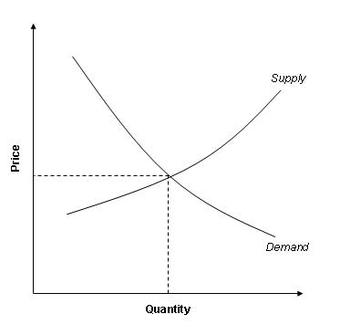
Supply and demand graph
The downward sloping demand curve reflects the fact that as price increases, consumers willing to purchase less of the good or service.
Veblen Goods
Veblen goods are expensive luxury products, such as designer handbags and high-end cars. In these rare circumstances, decreasing the price actually decreases the demand for the good. The reason for this is because part of the value of the good is exclusivity. These items are status symbols and lowering the price diminishes the status.
Giffen Goods
Giffen goods are another example where rising prices can lead to increased demand for a product. Giffen goods are very rare and are defined by three characteristics:
- It is an inferior good, or a good for which demand decreases as consumer income rises,
- There must be a lack of substitute product,
- The good must constitute a substantial percentage of the buyer’s income, but not such a substantial percentage of the buyer’s income that none of the associated normal goods are consumed.
For example, imagine a significant portion of a family’s grocery bill is bread. Bread is a staple and it is the cheapest option out of the food available. If bread prices rise, the family will need to cut back on other groceries to make up the difference. However, since the family still need to eat a certain amount of calories each day and bread is still the cheapest option, they will purchase more bread to make up for the food they aren’t purchasing and consuming. In this instance, bread is a giffen good.
4.1.2: The Demand Curve and Consumer Surplus
Consumer surplus is the difference between the maximum price a consumer is willing to pay and the actual price they do pay.
Learning Objective
Illustrate consumer surplus with the demand schedule and demand curve
Key Points
- On a supply and demand chart, consumer surplus is bound by the y-axis on the left, the demand curve on the right, and a horizontal line where y equals the current market price.
- Another way to define consumer surplus in less quantitative terms is as a measure of a consumer’s well-being.
- An individual’s customer surplus for a product is based on the individual’s utility of that product.
Key Term
- consumer surplus
-
The difference between the maximum price a consumer is willing to pay and the actual price they do pay.
Consumer surplus is the difference between the maximum price a consumer is willing to pay and the actual price they do pay. If a consumer would be willing to pay more than the current asking price, then they are getting more benefit from the purchased product than they spent to buy it. Consumer surplus plus producer surplus equals the total economic surplus in the market.
This chart graphically illustrates consumer surplus in a market without any monopolies, binding price controls, or any other inefficiencies . The price in this chart is set at the pareto optimal. This means that the price could not be increased or decreased without one of the parties being made worse off. The consumer surplus, as marked in red, is bound by the y-axis on the left, the demand curve on the right, and a horizontal line where y equals the equilibrium price. This area represent the amount of goods consumers would have been willing to purchase at a price higher than the pareto optimal price. Generally, the lower the price, the greater the consumer surplus.

Consumer Surplus
Consumer surplus, as shown highlighted in red, represents the benefit consumers get for purchasing goods at a price lower than the maximum they are willing to pay.
Another way to define consumer surplus in less quantitative terms is as a measure of a consumer’s well-being. Some goods, like water, are valuable to everyone because it is a necessity for survival. But the utility, or “usefulness,” of most goods vary depending on a person’s individual preferences. Since the utility a person gets from a good defines her demand for it, utility also defines the consumer surplus an individual might get from purchasing that item. If a person has no use for a good, there is no consumer’s surplus for that person in purchasing the good no matter the price. However, if a person finds a good incredibly useful, consumer surplus will be significant even if the price is high. An individual’s customer surplus for a product is based on the individual’s utility of that product.
4.1.3: Impacts of Price Changes on Consumer Surplus
Consumer surplus decreases when price is set above the equilibrium price, but increases to a certain point when price is below the equilibrium price.
Learning Objective
Explain how shifting a price away from pareto optimal will impact consumer surplus
Key Points
- Consumer surplus will only increase as long as the benefit from the lower price exceeds the costs from the resulting shortage.
- Consumer surplus always decreases when a binding price floor is instituted in a market above the equilibrium price.
- The total economic surplus equals the sum of the consumer and producer surpluses.
- Price helps define consumer surplus, but overall surplus is maximized when the price is pareto optimal, or at equilibrium.
Key Terms
- price floor
-
A mandated minimum price for a product in a market.
- Price ceiling
-
A government-imposed price control or limit on how high a price is charged for a product.
Consumer surplus is defined, in part, by the price of the product. Recall that the consumer surplus is calculating the area between the demand curve and the price line for the quantity of goods sold . Assuming that there is no shift in demand, an increase in price will therefore lead to a reduction in consumer surplus, while a decrease in price will lead to an increase in consumer surplus.
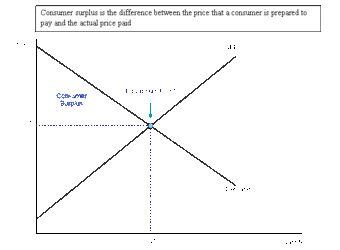
Consumer Surplus
An increase in the price will reduce consumer surplus, while a decrease in the price will increase consumer surplus.
Below are two scenarios that illustrate how changes in price can affect consumers’ surplus. It is important to note that any shift from the good’s pareto optimal price will result in a decrease in the total economic surplus. The total economic surplus equals the sum of the consumer and producer surpluses.
Price Ceiling
A binding price ceiling is one that is lower than the pareto efficient market price. This means that consumers will be able to purchase the product at a lower price than what would normally be available to them. It might appear that this would increase consumer surplus, but that is not necessarily the case.
For consumers to achieve a surplus they have to be able to purchase the product, which means that producers have to make enough to be purchased at a price. If a good’s price drops below the market equilibrium for whatever reason, manufacturing the product will be less profitable for the producers. So while more consumers will want to purchase the product because of its low price, they will not be able to. This means the market will have a shortage for that good. This shortage will create a deadweight loss, or a market wide loss of efficiency and value that neither producer nor consumers obtain.
So any increase in consumer surplus due to the decrease in price may be offset by the fact that consumers that want the good cannot purchase it. At some point the benefit from the drop in price will be outweighed by the decrease in the good’s availability.
Price Floor
When a price floor is set above the equilibrium price, consumers will have to purchase the product at a higher price. Therefore, fewer consumers will purchase the product because some will decide that the utility they get from the good is not worth the price. Necessarily, this reflects a drop in consumer surplus.
4.2: Producer Surplus
4.2.1: Market Power
Market power is a measure of a firm’s economic strength that affects its pricing and supply decisions.
Learning Objective
Summarize the relationship between market power and a firm’s supply decision
Key Points
- Firms with market power are said to be “price makers. ” They can raise prices and change the quantity supplied of goods and services without hurting profits. Market power often exists when there is a monopoly or oligopoly.
- Firms with limited to no market power are said to be “price takers. ” They cannot raise their prices or change the quantity supplied of goods and services without hurting profits. Perfectly competitive firms are examples of price takers with no market power.
- Market power is determined by the number of producers in the market, the size of each firm, barriers to entry in the market, and availability of substitute goods. Firm size and market size alone do not dictate market power.
- Market power is often measured with concentration ratios or the Herfindahl-Hirschman Index, but these are not perfect measures.
Key Terms
- market power
-
The ability of a firm to profitably raise the market price of a good or service over marginal cost. A firm with total market power can raise prices without losing any customers to competitors.
- contestable market
-
An imperfectly competitive industry subject to potential entry if prices or profits increase.
- concentration ratio
-
The proportion of total industry output produced by the largest firms (usually the four largest).
- Herfindahl-Hirschman Index
-
A measure of the size of firms in relation to the industry and an indicator of the amount of competition among them.
Market power is a measure of the economic strength of a firm. It is the ability of a firm to influence the quantity or price of goods and services in a market. A firm is said to have significant market power when price exceeds marginal cost and long run average cost, so the firm makes economic profits. Such firms are often referred to as “price makers. ” In contrast, firms with limited to no market power are referred to as “price takers. “
Determinants of Market Power
A firm usually has market power by virtue of controlling a large portion of the market. However, market size alone is not the only indicator of market power. Other factors that affect a firm’s market power include:
- Number of producers
- Size of firms in the market
The numbers and size of firms determine the extent that firms can withstand pressures and threats to change prices or product flows. However, being a large firm does not necessarily equal market power. For example, while conglomerates may be very large, they may play only small roles in many different markets and have no ability to influence prices in any of them.
- Barriers to entry
Barriers to entry determine how contestable the market is. Even highly concentrated markets may be contestable markets if there are no barriers to entry or exit, which limits a firm’s ability to raise its price above competitive levels.
Common barriers to entry include control of a scarce resource, increasing returns to scale, technological superiority, and government-imposed barriers.
- Availability of substitute goods
Greater availability of substitute goods will weaken a firm’s market power.
Relationship between Market Power and Firm Behavior
A firm’s market power influences its behavior. For example, market power gives firms the ability to engage in unilateral anti-competitive behavior. Some of the behaviors that firms with market power are accused of engaging in include predatory pricing, product tying, and creation of overcapacity or other barriers to entry . If no individual participant in the market has significant market power, then anti-competitive behavior can take place only through collusion, or the exercise of a group of participants’ collective market power.

Google Logo
In 2012, the U.S. Federal Trade Commission opened an antitrust probe against Google’s search practices. Google allegedly used its market dominance to promote its own products over competitors’ products in web searches.
A monopoly, a price maker with market power, can raise prices and retain customers because the monopoly has no competitors. If a customer has no other place to go to obtain the goods or services, they either pay the increased price or do without.
An oligopoly may also be a price maker with market power, as firms may be able to collude and control the market price or quantity demanded.
A perfectly competitive firm, a price taker with no market power, cannot raise its price without losing its customers.
Measurement of Market Power
Measurement of market power is often accomplished with concentration ratios or the Herfindahl-Hirschman Index (HHI).
Concentration Ratios
The concentration ratio is the proportion of total industry output produced by the largest firms (usually the four largest). This measure of market power relates the size of firms to the size of the market. For monopolies, the four firm concentration ratio is 100 percent, while the ratio is zero for perfect competition.
Herfindahl-Hirschman Index (HHI)
The Herfindahl-Hirschman Index (HHI) is a measure of the size of firms in relation to the industry, and an indicator of the amount of competition among them. The HHI is calculated by summing the squares of the percentage market shares of all participants in the market. The HHI for perfect competition is zero; for a monopoly, it is 10,000.
For example, if a market consists of five firms with market shares of 40, 20, 20, 15, and 5 percent each, the HHI is 2650 (
).
Measurement Problems
The use of the concentration ratio or the HHI to measure market power is not perfect. A high concentration ratio or large firm size is not the only way to achieve market power. Many smaller firms acting in unison can achieve the same result. Additionally, the measurements do not convey the extent to which market power may be concentrated in a local market.
4.2.2: Defining Producer Surplus
Producer surplus is the difference between the amount producers get for selling a good and the amount they want to accept for that good.
Learning Objective
Define producer surplus
Key Points
- Producer surplus can be thought of as the extra money, utility, or benefits the producer receives by selling a product at a price that is higher than its minimum acceptable price.
- The minimum acceptable price for producers is represented by the supply curve.
- Graphically, producer surplus is the shaded region just above the supply curve, but below the equilibrium price level.
Key Term
- producer surplus
-
The amount that producers benefit by selling at a market price that is higher than the lowest price at which they would be willing to sell.
Producer surplus is the difference between what price producers are willing and able to supply a good for and what price they actually receive from consumers. It is the extra money, benefit, and/or utility producers get from selling a product at a price that is higher than their minimum accepted price, as shown by the supply curve.

Economic Surplus
Producer surplus is the shaded area directly above the supply curve, up to the equilibrium point. Consumer surplus is the shaded area directly under the demand curve, up to the equilibrium point.
For example, above, the equilibrium price is
. However, at
, the producers are willing to sell one unit of a commodity for a price that is lower than
. The resulting rectangle from
on the
-axis, to its intersection with the supply curve, up to the level of
is the producer surplus at price level
.
Similarly, at
, the producers are willing to sell two units of a commodity at a price that is still lower than
. The rectangle from
on the
-axis, to its intersection with the supply curve, up to the level of
is the new producer surplus at price
. The total producer surplus at
is the first rectangle at the
price, plus the new rectangle from the
price.
This process is repeated for every price level up to the equilibrium price. To find the resulting total producer surplus, all of the rectangles for the individual price levels are added together, and the total area is the total producer surplus. Below, the total producer surplus is made of all three pink rectangles – the surpluses at price levels of
,
, and
– added together.

Producer surplus
In the figure, producer surplus at different prices is represented by the pink rectangles.
4.2.3: Impact of Changing Price on Producer Surplus
Producer surplus is affected by changes in price, the demand and supply curve, and the price elasticity of supply.
Learning Objective
Examine producer surplus in terms of changes in demand, supply, price, and price elasticity
Key Points
- Changes in the equilibrium price are directly related to producer surplus, other things equal. As the equilibrium price increases, the potential producer surplus increases. As the equilibrium price decreases, producer surplus decreases.
- Shifts in the demand curve are directly related to producer surplus. If demand increases, producer surplus increases. If demand decreases, producer surplus decreases.
- Shifts in the supply curve are directly related to producer surplus. If supply increases, producer surplus increases. If supply decreases, producer surplus decreases.
- Price elasticity of supply is inversely related to producer surplus. If supply is completely elastic, it is drawn as a horizontal line, and producer surplus is zero. If supply is completely inelastic, it is shown as a vertical line, and producer surplus is infinite.
Key Terms
- producer surplus
-
The amount that producers benefit by selling at a market price that is higher than the lowest price at which they would be willing to sell.
- price elasticity of supply
-
A numerical measure of the responsiveness of the quantity supplied of a product to a change in the price of the product alone.
Producer surplus is affected by many different factors. Changes in the price level, the demand and supply curves, and price elasticity all influence the total amount of producer surplus, other things held constant.
Changes in Price
Changes in price are directly associated with the amount of surplus a producer will receive. Graphically, the producer surplus is directly above the supply curve, but below the price. Other things equal, as equilibrium price increases, the amount of potential producer surplus and the number of goods supplied increases. Lower prices result in lower potential producer surplus and goods supplied: with a lower equilibrium price, the producer surplus triangle will be smaller.

Economic Surplus
The producer surplus is directly above the supply curve and is shaded in blue.
Demand Curve
Shifts in the demand curve are directly related to the amount of producer surplus. If demand decreases, and the demand curve shifts to the left, producer surplus decreases. Conversely, if demand increases, and the demand curve shifts to the right, producer surplus increases.
At an initial demand represented by the “Demand (1)” curve, producer surplus is the blue triangle made of
,
, and
. When demand increases, represented by the “Demand (2)” curve, producer surplus is the larger gray triangle made of
,
, and
.
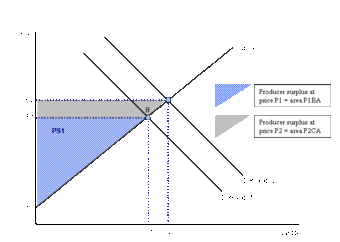
Producer Surplus and the Demand Curve
If the demand curve shifts out, producer surplus increases, as seen by size of the gray triangle.
Supply Curve
Similarly, shifts in the supply curve are also directly related to the amount of potential surplus. Decreases in the supply curve will cause decreases in producer surplus. Increases in the supply curve will cause increases in producer surplus.
At an initial supply represented by the “Supply (1)” curve, producer surplus is the blue triangle made of
,
, and
. If supply increases, represented by the “Supply (2)” curve, producer surplus is the larger gray triangle made of
,
, and
.
Price Elasticity of Supply
Price elasticity of supply is the relationship between price and quantity changes. It measures how quantity supplied is affected by changes in price. When supply is elastic, producers can increase production without much price or cost change. When supply is inelastic, producers cannot change production easily.
When supply is perfectly elastic, it is depicted as a horizontal line. Producer surplus is zero because the price is not flexible. Producers cannot provide a higher price than market price.
When supply is perfectly inelastic, it is depicted as a vertical line. Producer surplus is infinite because the price is completely flexible.
Chapter 3: Introducing Supply and Demand
3.1: Demand
3.1.1: The Law of Demand
In general, the law of demand states that the quantity demanded and the price of a good or service is inversely related, other things remaining constant.
Learning Objective
Explain the concept of demand and discuss the factors that affect it
Key Points
- The demand curve is downward sloping, indicating the negative relationship between the price of a product and the quantity demanded.
- For normal goods, a change in price will be reflected as a move along the demand curve while a non-price change will result in a shift of the demand curve.
- Two exceptions to the law of demand are Giffen goods and Veblen goods.
Key Terms
- Giffen good
-
A good which people consume more of as only the price rises; Having a positive price elasticity of demand.
- Veblen good
-
A good for which people’s preference for buying them increases as a direct function of their price, as greater price confers greater status.
- normal good
-
A good for which demand increases when income increases and falls when income decreases but price remains constant.
In economics, the law of demand states that the quantity demanded and the price of a good or service is inversely related, other things remaining constant. Therefore, the demand curve will generally be downward sloping, indicating the negative relationship between the price of a good or service and the quantity demanded.
Movement along the demand curve
If the income of the consumer, prices of the related goods, and preferences of the consumer remain unchanged, then the change in quantity of good demanded by the consumer will be negatively correlated to the change in the price of the good or service. The change in price will be reflected as a move along the demand curve.
Shift in the demand curve
The demand curve will shift, move either inward or outward as a result of non-price factors. A shift in demand can be related to the following factors (non-exhaustive list):
- Consumer preferences
- Consumer income
- Change in the price of related goods (i.e. compliments)
- Change in the number of buyers
- Consumer expectations

Law of Demand
A demand curve, shown in red and shifting to the right, demonstrating the inverse relationship between price and quantity demanded (the curve slopes downwards from left to right; higher prices reduce the quantity demanded).
Though in general terms and specific to normal goods, demand will exhibit a downward slope, there are exceptions: Giffen goods and Veblen goods
Giffen goods
A Giffen good describes an extreme case for an inferior good. In theory, a Giffen good would display the characteristic that as price increases, demand for the product increases. In the real world application, there has not been a
true
example of a Giffen good, though a popular albeit historically inaccurate example is the purchase of potatoes (an inferior good) as prices continued to increase during the Irish potato famine.
Veblen goods
Some expensive commodities like diamonds, expensive cars, designer clothing and other high-price limited items, are used as status symbols to display wealth. The more expensive these commodities become, the higher their value as a status symbol and the greater the demand for them. The amount demanded of these commodities increase with an increase in their price and decrease with a decrease in their price. These goods are known as a Veblen goods.
3.1.2: Demand Schedules and Demand Curves
A demand curve depicts the price and quantity combinations listed in a demand schedule.
Learning Objective
Describe the relationship between demand curves and demand schedules
Key Points
- Demand curves are a graphical representation of a demand schedule, which is the table view of an economic agents’ price to quantity relationship.
- Demand curves embody preferences, substitution potential and income, as well as other characteristics that influence an economic agent’s ability to assess willingness to pay at a specific point in time for goods and services.
- Demand curves may be linear or curved.
- Aggregate demand is the sum of the quantity demanded for a specific price over a group of economic agents.
Key Term
- equilibrium
-
The condition of a system in which competing influences are balanced, resulting in no net change.
The demand curve is a graphical representation depicting the relationship between a commodity’s different price levels and quantities which consumers are willing to buy. The curve can be derived from a demand schedule, which is essentially a table view of the price and quantity pairings that comprise the demand curve.
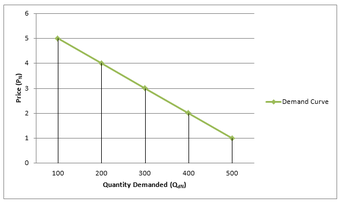
Demand Schedule and Curve
The demand curve is the graphical representation of the economic entity’s willingness to pay for a good or service. It is derived from a demand schedule, which is the table view of the price and quantity pairs that comprise the demand curve.
Given that in most cases, as the price of a good increases, agents will likely decrease consumption and substitute away to another good or service, the demand curve embodies a negative price to quantity relationship. The curve typically slopes downward from left to right; though there are some goods and services that exhibit an upward sloping demand, these goods and services are characterized as abnormal.
The demand curve of an individual agent can be combined with that of other economic agents to depict a market or aggregate demand curve. Using a demand schedule, the quantity demanded per each individual can be summed by price, resulting in an aggregate demand schedule that provides the total demanded specific to a given price level. The plotting of the aggregated quantity to price pairings is what is referred to as an aggregate demand curve. In this manner, the demand curve for all consumers together follows from the demand curve of every individual consumer.
The demand curve in combination with the supply curve provides the market clearing or equilibrium price and quantity relationship. This is found at the intersection or point at which the supply and demand curves cross each other.
3.1.3: Market Demand
Market demand is the summation of the individual quantities that consumers are willing to purchase at a given price.
Learning Objective
Examine the relationship between market demand and individual demand
Key Points
- The graphical representation of a market demand schedule is called the market demand curve.
- Following the law of demand, the demand curve is almost always represented as downward-sloping. This means that as price decreases, consumers will buy more of the good.
- Two different hypothetical types of goods with upward-sloping demand curves are Giffen goods and Veblen goods.
Key Term
- Market demand
-
The summation of the individual quantities that consumers are willing to purchase at a given price.
The demand schedule represents the amount of some good that a buyer is willing and able to purchase at various prices. The relationship between price and quantity demanded reflected in this schedule assumes the following factors remain constant:
- Income levels;
- Population;Tastes and preferences;
- Price of substitute goods; and
- Price of complementary goods
The demand schedule is depicted graphically as the demand curve. The demand curve is shaped by the law of demand. In general, this means that the demand curve is downward-sloping, which means that as the price of a good decreases, consumers will buy more of that good.

Demand Curve
The demand curve is the graphical depiction of the demand schedule. For most goods and services, the demand curve exhibits a negative relationship between price and quantity and is as a result downward sloping.
A market demand schedule is a table that lists the quantity of a good all consumers in a market will buy at every different price. A market demand schedule for a product indicates that there is an inverse relationship between price and quantity demanded. The graphical representation of a market demand schedule is called the market demand curve.
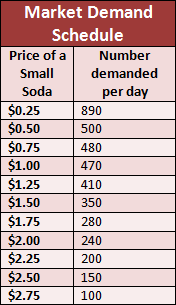
Market Demand Schedule
A market demand schedule is a table that lists the quantity of a good all consumers in a market will buy at every different price.
The determinants of demand are:
- Income
- Tastes and preferences
- Prices of related (AKA complimentary) goods and services
- Prices of substitues
- Number of potential consumers
The market demand is the summation of the individual quantities that consumers are willing to purchase at a given price.
As noted, both individual demand curves and market demand are typically expressed as downward shaping curves. However, special cases exist where the preference for the good or service may be perverse. Two different hypothetical types of goods with upward-sloping demand curves are Giffen goods (an inferior but staple good) and Veblen goods (goods characterized as being more desirable the higher the price; luxury or status items).
3.1.4: Ceteris Paribus
Ceteris paribus is defined as “all else being equal,” or “holding all else constant”.
Learning Objective
Explain the rationale for the assumption of ceteris paribus
Key Points
- When ceteris paribus is employed in economics, all other variables with the exception of the variables under evaluation are held constant.
- An example of the use of ceteris paribus in macroeconomics is: what would happen to the demand for labor by firms if a minimum wage was imposed at a level above the prevailing wage rate, ceteris paribus.
- An example of the use of ceteris paribus in microeconomics is: what would happen for the demand for a normal good when income increases, ceteris paribus.
Key Term
- ceteris paribus
-
all else equal; holding everything else constant
Economics seeks to interpret, analyze and or evaluate situations that occur between individuals, firms and other entities. Due to the potential for multiple agents and other known and unknown external activities to be involved or present but not relevant to an analysis, economics employs the assumption of “all else constant,” which is the English translation of the Latin phrase “ceteris paribus”.
When the ceteris paribus assumption is employed in economics, all other variables – with the exception of the variables under evaluation – are held constant.
A Macroeconomic Example
What would happen to the demand for labor by firms if a minimum wage was imposed at a level above the prevailing wage rate, ceteris paribus? As depicted in below, the supply and demand curve are held constant, as are labor and leisure preferences for workers, and output considerations for firms, in addition to all other variables and characteristics embedded within the shape of the supply and demand curves. Thus, what is being evaluated is the impact of a constraint on market equilibrium.

Macroeconomics: Binding price floor
E is the equilibrium wage level when there is no binding minimum wage. When a minimum wage is imposed, ceteris paribus, suppliers of labor are willing to provide more labor than firms (demand for labor) are willing to purchase at the binding minimum wage rate. There is no shifting of either curve related to behavior influenced by the higher wage rate because ceteris paribus is holding labor-leisure trade-off (of workers) and substitution of labor (by firms) constant, along with other potential influencing variables.
A Microeconomic Example
What would happen for the demand for a normal good when income increases, ceteris paribus? In this case, as depicted in , a consumer’s preferences for the good and his demand for complements and substitutes are being held constant along with other attributes that could potentially impact his demand for a good, such as the good’s price. The supply of the good and the market and firm characteristics implicit in the shape of the supply curve are also held constant. This allows for an analysis of the increase in income, on the consumer’s demand for the single good alone.

Microeconomics: Income and Demand
A consumer is able to purchase a normal good and has a demand curve, D1, which provides the relationship between price and quantity given his preferences, income and other consumption attributes. Assuming an increase in his income, ceteris paribus, his demand curve would shift outward to D2, corresponding to a higher quantity for each purchase price. The consumer would then move his consumption for the good from Q1 to Q2, increasing his purchase of the good.
3.1.5: Changes in Demand and Shifts in the Demand Curve
Demand is the relationship between the willingness to purchase a quantity of a good or service at a specific price.
Learning Objective
Distinguish between shifts in the demand curve and movement along the demand curve
Key Points
- A change in price will result in a movement along a demand curve.
- A change in a non-price variable will result in a shift in the demand curve.
- An outward shift in demand will occur if income increases, in the case of a normal good; however, for an inferior good, the demand curve will shift inward noting that the consumer only purchases the good as a result of an income constraint on the purchase of a preferred good.
Key Terms
- normal good
-
A good for which demand increases when income increases and falls when income decreases but price remains constant.
- inferior good
-
a good that decreases in demand when consumer income rises; having a negative income elasticity of demand.
The demand curve is a graphical representation of an economic agent’s willingness to purchase a given quantity of a good or service at a specific price based on preferences, income, and other prevailing factors at a given point in time. Demand curves in combination with supply curves, which depict the price to quantity relationship of producers, are a representation of the goods and services market. Where the two curves intersect is market equilibrium, the price to quantity relationship where demand and supply are equal.
Movements in demand are specific to either movements along a given demand curve or shifts of the entire demand curve.
Movements along the demand curve are due to a change in the price of a good, holding constant other variables, such as the price of a substitute. If the price of a good or service changes the consumer will adjust the quantity demanded based on the preferences, income and prices of other factors embedded within a given curve for the time period under consideration.
Shifts in the demand curve are related to non-price events that include income, preferences and the price of substitutes and complements. An increase in income will cause an outward shift in demand (to the right) if the good or service assessed is a normal good or a good that is desirable and is therefore positively correlated with income. Alternatively, an increase in income could result in an inward shift of demand (to the left) if the good or service assessed is an inferior good or a good that is not desirable but is acceptable when the consumer is constrained by income .

Demand Curve
A demand curve provides an economic agent’s price to quantity relationship related to a specific good or service. Movements along a demand curve are related to a change in price, resulting in a change in quantity; shifts is demand (D1 to D2) are specific to changes in income, preferences, availability of substitutes and other factors.
A change in preferences could result in an increase (outward shift) or decrease (inward shift) in the quantity level desired for a specific price; while a change in the price of a substitute, could result in an outward shift if the price of the substitute increases and an inward shift if the substitute’s price decreases. The demand curve for a good will shift in parallel with a shift in the demand for a complement.
3.2: Supply
3.2.1: The Law of Supply
The law of supply states that there is a positive relationship between the quantity that suppliers are willing to sell and the price level.
Learning Objective
Explain the Law of Supply
Key Points
- Quantity supplied moves in the same direction as price.
- The supply curve is an upward sloping curve.
- Producers are willing to increase production at higher prices to increase profit.
Key Terms
- surplus
-
That which remains when use or need is satisfied, or when a limit is reached; excess; overplus.
- shortage
-
a lack or deficiency
- equilibrium
-
The condition of a system in which competing influences are balanced, resulting in no net change.
The law of supply is a fundamental principle of economic theory. It states that an increase in price will result in an increase in the quantity supplied, all else held constant.
An upward sloping supply curve, which is also the standard depiction of the supply curve, is the graphical representation of the law of supply. As the price of a good or service increases, the quantity that suppliers are willing to produce increases and this relationship is captured as a movement along the supply curve to a higher price and quantity combination.
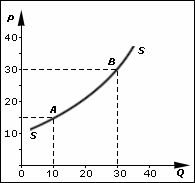
The Law of Supply
Supply has a positive correlation with price. As the market price of a good increases, suppliers of the good will typically seek to increase the quantity supplied to the market.
The rationale for the positive correlation between price and quantity supplied is based on the potential increase in profitability that occurs with an increase in price.
All else held constant, including the costs of production inputs, the supplier will be able to increase his return per unit of a good or service as the price for the item increases. Therefore, the net return to the supplier increases as the spread or difference between the price and the cost of the good or service being sold increases.
The law of supply in conjunction with the law of demand forms the basis for market conditions resulting in a price and quantity relationship at which both the price to quantity relationship of suppliers and demanders (consumers) are equal. This is also referred to as the equilibrium price and quantity and is depicted graphically at the point at which the demand and supply curve intersect or cross one another. It is the point where there is no surplus or shortage in the market .

Law of Supply and Law of Demand: Equilibrium
The law of supply and the law of demand form the foundation for the establishment of an equilibrium–where the price to quantity combination for both suppliers and demanders are the same.
3.2.2: Supply Schedules and Supply Curves
A supply schedule is a tabular depiction of the relationship between price and quantity supplied, represented graphically as a supply curve.
Learning Objective
Explain the price to quantity relationship exhibited in the supply curve
Key Points
- The supply curve plots the quantity that is willingly supplied at any given price.
- The individual supply curves can be summed by quantity provided at a specific price to achieve an aggregate supply curve.
- The supply curve is upward sloping in the short run.
Key Terms
- aggregate
-
A mass, assemblage, or sum of particulars; something consisting of elements but considered as a whole.
- equilibrium
-
The condition of a system in which competing influences are balanced, resulting in no net change.
Supply is the amount of some product that producers are willing and able to sell at a given price, all other factors being held constant. In general, supply depicts a positive relationship between the price of a good or service and the quantity that the producer is willing to supply: if a supplier believes it can sell the product for more, it will want to make more of the product. As a result, as the price of a good or service increases, suppliers increase the quantity available for purchase.
A supply schedule is a table that shows the relationship between the price of a good and the quantity supplied. The supply curve is a graphical depiction of the supply schedule that illustrates that relationship between the price of a good and the quantity supplied .
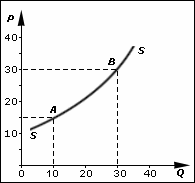
The Supply Schedule and Supply Curve
The supply curve is a graphical depiction of the price to quantity pairings presented in a supply schedule. The supply schedule is a table view of the relationship between the price suppliers are willing to sell a specific quantity of a good or service.
The supply curves of individual suppliers can be summed to determine aggregate supply. One can use the supply schedule to do this: for a given price, find the corresponding quantity supplied for each individual supply schedule and then sum these quantities to provide a group or aggregate supply. Plotting the summation of individual quantities per each price will produce an aggregate supply curve.
In theory, in the long run the aggregate supply curve will not be upward sloping but will instead be vertical, consistent with a fixed supply level. This is due to the underlying assumption that in the long run, supply of a good only depends on the fixed level of capital, technology, and natural resources available.
The supply curve provides one side of the price-to-quantity relationship that ensures a functional market. The other component is demand. When the supply and demand curves are graphed together they will intersect at a point that represents the market equilibrium – the point where supply equals demand and the market clears.
3.2.3: Market Supply
Market supply is the summation of the individual supply curves within a specific market where the market is characterized as being perfectly competitive.
Learning Objective
Identify the market conditions that yield a market supply curve.
Key Points
- A supply curve is the graphical representation of the supplier’s positive correlation between the price and quantity of a good or service.
- The supply curve can only be attributed to a depiction of a perfectly competitive market due to the unique attributes of perfect competition: firms are price takers, no single firm’s actions can influence the market price, and ease of exit and entry.
- The market supply curve is derived by summing the quantity for a given price across all market participants (suppliers). It depicts the price-to-quantity combinations available to consumers of the good or service.
Key Term
- Supply curve
-
A graphical representation of the quantity producers are willing to make when the product can be sold at a given price.
A supply curve is the graphical representation of the supplier’s positive correlation between the price and quantity of a good or service. As a result, the supply curve is upward sloping . Market supply is the summation of the individual supply curves within a specific market.
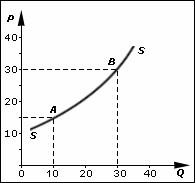
Market Supply
The market supply curve is an upward sloping curve depicting the positive relationship between price and quantity supplied.
The market supply curve is derived by summing the quantity suppliers are willing to produce when the product can be sold for a given price. As a result, it depicts the price to quantity combinations available to consumers of the good or service. In combination with market demand, the market supply curve is requisite for determining the market equilibrium price and quantity.
By its very nature, conceptualizing a supply curve requires the firm to be a perfect competitor, namely requires the firm to have no influence over the market price. This is true because each point on the supply curve is the answer to the question “If this firm is faced with this potential price, how much output will it be able to and willing to sell? ” If a firm has market power, its decision of how much output to provide to the market influences the market price, then the firm is not “faced with” any price, and the question is meaningless.
The attributes of a competitive market signal that the price is set external to any firm. Therefore, production in the market is a sliding scale dependent on price. As price increases, quantity increases due to low barriers to entry, and as the price falls, quantity decreases as some firms may even opt out of the market.
The supply curve can be derived by compiling the price-to-quantity relationship of a seller. A seller could set the price of a good or service equal to zero and then incrementally increase the price; at each price he could calculate the hypothetical quantity he would be willing to supply. Following this process the seller would be able to trace out its complete individual supply function. The market supply curve is simply the sum of every seller’s individual supply curve.
3.2.4: Determinants of Supply
Supply levels are determined by price, which increases or decreases supply along the price curve, and non-price factors, which shifts the entire curve.
Learning Objective
Identify the factors that affect the supply of a good
Key Points
- Supply is the quantity of a good or service that a supplier provides to the market.
- Suppliers will shift production for non-price changes related to the determinants of supply and will slide production levels across the supply curve for price related movements.
- Innumerable factors and circumstances could affect a seller’s willingness or ability to produce and sell a good.
Key Terms
- incentive
-
Something that motivates, rouses, or encourages.
- intervention
-
The action of interfering in some course of events.
Supply is the quantity of a good or service that a supplier provides to the market. Innumerable factors and circumstances could affect a seller’s willingness or ability to produce and sell a good. Some of the more common factors are:
- Good’s own price: An increase in price will induce an increase in the quantity supplied.
- Prices of related goods: For purposes of supply analysis, related goods refer to goods from which inputs are derived to be used in the production of the primary good.
- Conditions of production: The most significant factor here is the state of technology. If there is a technological advancement related to the production of the good, the supply increases.
- Expectations: Sellers’ expectations concerning future market conditions can directly affect supply.
- Price of inputs: If the price of inputs increases the supply curve will shift left as sellers are less willing or able to sell goods at any given price. Inputs include land, labor, energy and raw materials.
- Number of suppliers: As more firms enter the industry the market supply curve will shift out driving down prices. The market supply curve is the horizontal summation of the individual supply curves.
- Government policies and regulations: Government intervention can take many forms including environmental and health regulations, hour and wage laws, taxes, electrical and natural gas rates and zoning and land use regulations. These regulations can affect a good’s supply.
Suppliers will change their production levels along the supply curve in response to a price change, so that their production level is equal to demand. However, some factors unrelated to price can shift the production level. For example, a technological improvement that reduces the input cost of a product will shift the supply curve outward, allowing suppliers to provide a greater supply at the same price level.
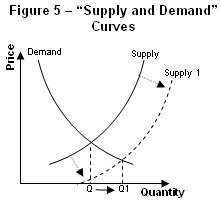
Determinants of Supply
If the price of a good changes, there will be movement along the supply curve. However, the supply curve itself may shift outward or inward in response to non-price related factors that affect the supply of a good, such as technological advances or increased cost of materials.
3.2.5: Changes in Supply and Shifts in the Supply Curve
The supply curve depicts the supplier’s positive relationship between price and quantity.
Learning Objective
Distinguish between shifts in the supply curve and movement along the supply curve
Key Points
- A change in the price of a good or service, holding all else constant, will result in a movement along the supply curve.
- A change in the cost of an input will impact the cost of producing a good and will result in a shift in supply; supply will shift outward if costs decrease and will shift inward if they increase.
- A change in the expected demand for a good or service will result in a shift in supply; supply will shift outward if enthusiasm is expected to increase and will shift inward if there is an expectation for consumers preferences to change in favor of an alternate good or service.
Key Term
- Non-price changes
-
Shocks, either exogenous or endogenous, that affect the positioning of the supply curve.
Price changes and movement along supply curve
If the price of the good or service changes, all else held constant such as price of substitutes, the supplier will adjust the quantity supplied to the level that is consistent with its willingness to accept the prevailing price. The change in price will result in a movement along the supply curve, called a change in quantity supplied, but not a shift in the supply curve. Changes in supply are due to non-price changes.
Non-price changes and shifts of the supply curve
If production costs increase, the supplier will face increasing costs for each quantity level. Holding all else the same, the supply curve would shift inward (to the left), reflecting the increased cost of production. The supplier will supply less at each quantity level.
If production costs declined, the opposite would be true. Lower costs would result in an increase in output, shifting the supply curve outward (to the right) and the supplier will be willing sell a larger quantity at each price level. The supply curve will shift in relation to technological improvements and expectations of market behavior in very much the same way described for production costs.
Technological improvements that result in an increase in production for a set amount of inputs would result in an outward shift in supply.
Supply will shift outward in response to indications of heightened consumer enthusiasm or preference and will respond by shifting inward if there is an assessment of a negative impact to production costs or demand .
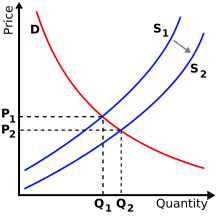
Supply Shifts
A shift in supply from S1 to S2 affects the equilibrium point, and could be caused by shocks such as changes in consumer preferences or technological improvements.
3.3: Market Equilibrium
3.3.1: Clearing the Market at Equilibrium Price and Quantity
When a market achieves perfect equilibrium there is no excess supply or demand, which theoretically results in a market clearing.
Learning Objective
Define market equilibrium
Key Points
- The interdependent relationship between supply and demand in the field of economics is inherently designed to identify the ideal price and quantity of a given product or service in a marketplace.
- A market clearing, by definition, is the economic assumption that the quantity supplied will consistently align with the quantity demanded.
- Market clearing requires a variety of assumptions which simplify the complexities of real markets to coincide with a more theoretical framework, most centrally the assumptions of perfect competition and Say’s Law.
- While this concept of market clearing resonates well in theory, the actual execution of markets is very rarely perfect. The concepts of consolidated markets and ‘sticky’ markets reduces the accuracy of these models.
Key Terms
- Say’s Law
-
The idea that money is perishable.
- Incumbents
-
A holder of a position as supplier to a market or market segment that allows the holder to earn above-normal profits.
- Opportunity cost
-
The cost of an opportunity forgone (and the loss of the benefits that could be received from that opportunity); the most valuable forgone alternative.
Example
- A textbook example of a monopoly was the Da Beers family, who owned the vast majority of diamond mines worldwide. Through effectively controlling the diamond market supply (via owning the mines), and warehousing the diamonds in a way to substantially alter the available supply, it became reasonably easy for Da Beers to charge prices in excess of what a reasonable equilibrium would be.
The interdependent relationship between supply and demand in the field of economics is inherently designed to identify the ideal price and quantity of a given product or service in a marketplace. This equilibrium point is represented by the intersection of a downward sloping demand line and an upward sloping supply line, with price as the y-axis and quantity as the x-axis . At perfect equilibrium there is no excess demand (represented by ‘A’ in the figure) or excess supply (represented by ‘B’ in the figure), which theoretically results in a market clearing.
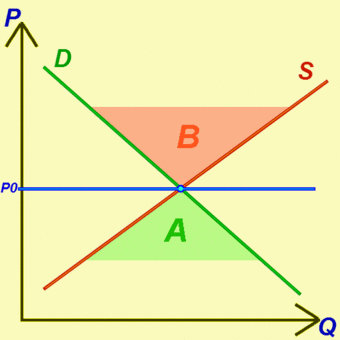
Equilibrium Pricing
This chart effectively highlights the various basic implications of a simple supply and demand chart. The equilibrium point is where market clearing will theoretically occur.
Market Clearing Assumptions
A market clearing, by definition, is the economic assumption that the quantity supplied will consistently align with the quantity demanded. This definition requires a variety of assumptions which simplify the complexities of real markets to coincide with a more theoretical framework, most centrally the assumptions of perfect competition and Say’s Law:
- Perfect competition is a market where the price determined for a given good or service is not affected by external forces or competition in a way that allows incumbents (companies) to attain market influence.
- Say’s Law hinges on the concept that capital loses value over time, or that money is essentially perishable. The simplest way to view this law is interest rates. When you invest or owe money, that capital accrues interest due to the fact that there is an opportunity cost in not investing that money elsewhere. This opportunity cost creates the assumption that money will not go unused.
Combining these two assumptions, in a perfectly competitive market the amount of a product or service that is supplied at a given price will equate to the amount demanded, clearing the market of all goods/services at a given equilibrium point.
Theory and Practice
While this concept of market clearing resonates well in theory, the actual execution of markets is very rarely perfect. Markets demonstrate consistent shifts of supply and shifts of demand based on a wide spectrum of externalities. Even in static markets there is competitive consolidation that allows companies to charge differing price points than that of the equilibrium. The concept of monopolies provides a good example for this experience, as monopolies (see example) can control price and quantity simultaneously.
Another classic criticism of market clearing is the way in which the labor market functions. In the 1930’s, during the worst depression recorded in the United States, the labor market did not clear the way economic theories of market clearing would assume it would. Instead, there seemed to be what John Maynard-Keynes (father of Keynesian Economics) called ‘stickiness,’ which preventing the market from normalizing. The importance of raising these concerns is the understanding that while the concept of market clearing, equilibrium and supply/demand charts are highly useful in understanding the basic functioning of markets, reality does not always conform with these models.
3.3.2: Impacts of Surpluses and Shortages on Market Equilibrium
The existence of surpluses or shortages in supply will result in disequilibrium, or a lack of balance between supply and demand levels.
Learning Objective
Infer the outcomes of departures from equilibrium using the model of supply and demand
Key Points
- Surpluses, or excess supply, essentially indicates that the quantity of a good or service exceeds the demand for that particular good at the price in which the producers would wish to sell (equilibrium level).
- In a perfectly competitive market, excess supply is equivalent to the quantity available in the market beyond the equilibrium point of intersection between supply and demand. This will result in a shift in market equilibrium towards lower price points.
- Shortage is a term used to indicate that the supply produced is below that of the quantity being demanded by the consumers. This disparity implies that the current market equilibrium at a given price is unfit for the current supply and demand relationship.
- In a perfectly competitive market, a shortage in supply will ultimately result in a shift in the equilibrium point, transitioning towards a higher price point due to the limited supply availability.
Key Terms
- Disequilibrium
-
The loss of equilibrium or stability, especially due to an imbalance of forces.
- surplus
-
That which remains when use or need is satisfied, or when a limit is reached.
- shortage
-
Not enough or not sufficient for a given demand.
In the analysis of market equilibrium, specifically for pricing and volume determinations, a thorough understanding of the supply and demand inputs is critical to economics. Surpluses and shortages on the supply end can have substantial impacts on both the pricing of a specific product or service, alongside the overall quantity sold over time. Shifts such as these in the supply availability results in disequilibrium, or essentially a lack of balance between current supply and demand levels. Surpluses and shortages often result in market inefficiencies due to a shifting market equilibrium.
Surpluses
Surpluses, or excess supply, indicate that the quantity of a good or service exceeds the demand for that particular good at the price in which the producers would wish to sell (equilibrium level). This inefficiency is heavily correlated in circumstances where the price of a good is set too high, resulting in a diminished demand while the quantity available gains excess. There are substantial business risks inherently built into the concept of surpluses, as the general outcome will be either selling off inventory at sub-par prices or leftover unsold inventory. In both scenarios businesses will be forced to minimize margins or incorporate losses on that particular good. Governmental intervention can often create surplus as well, particularly through the utilization of a price floor if it is set at a price above the market equilibrium .
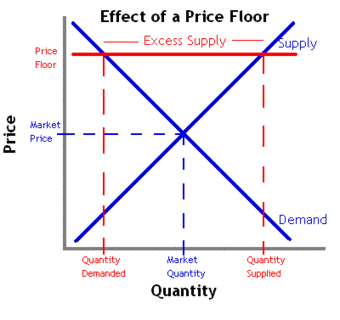
Price Floor
A price floor ensures a minimum price is charged for a specific good, often higher than that what the previous market equilibrium determined. This can result in a surplus.
In a perfectly competitive market, particularly pertaining to goods that are not perishable, excess supply is equivalent to the quantity available in the market beyond the equilibrium point of intersection between supply and demand. In this theoretical scenario the equilibrium point will transition towards a lower price point due to the increased supply, which will in turn motivate consumers to purchase a higher quantity as a result. This allows the economic model of the market to correct itself.
Shortages
Inversely, shortage is a term used to indicate that the supply produced is below that of the quantity being demanded by the consumers. This disparity implies that the current market equilibrium at a given price is unfit for the current supply and demand relationship, noting that the price is set too low. It could also indicate that the desired good has a low level of affordability by the general public, and can be a dangerous societal risk for necessary commodities. Indeed, Garrett Hardin emphasized that a shortage of supply could also be perceived as a ‘longage’ of demand, as the two are inversely related. From this vantage point shortages can be attributed to population growth as much as resource scarcity.
In a perfectly competitive market, a shortage in supply will ultimately result in a shift in the equilibrium point, transitioning towards a higher price point due to the limited supply availability. This will prioritize who receives the good or service based upon their willingness and ability to pay a premium for the specific item in demand, leveraging those along the demand curve who are at higher levels with higher ability and willingness to pay.
3.3.3: Changes in Demand and Supply and Impacts on Equilibrium
Alterations to overall supply or demand dictate the cross-section or equilibrium, ascertaining price and volume for a product or service.
Learning Objective
Illustrate how changes in supply or demand impact the market equilibrium
Key Points
- The interdependent relationship between the supply of a given product or service and the overall demand exercised by interested parties generates a theoretical equilibrium point, dictating the average market price and purchase volume relative to that price.
- Markets are in constant flux as demands and supplies are subjected to varying driving forces and influences. These shifts play a critical role, altering market equilibrium price points and volumes for products and services.
- Demand shifts can be caused by a wide variety of factors, but largely revolve around drivers of consumer behavior and circumstances.
- Supply shifts, similar to demand shifts, can ultimately be a result of a wide variety of externalities. Scarcity, or the lack of availability for a particular material, is a core driving force for overall supply.
- Due to a demand curve’s sloping downward and a supply curve’s sloping upwards, the curves will eventually cross at some point on any supply/demand chart. This point of equilibrium serves as a price and quantity tracking point.
Key Terms
- equilibrium
-
A condition in which competing forces are in balance.
- scarcity
-
An insufficiency or lack of availability; a shortage.
The interdependent relationship between the supply of a given product or service and the overall demand exercised by interested parties generates a theoretical equilibrium point, dictating the average market price and purchased volume relative to that price. In a static market it would be reasonable to assume that prices and volumes would remain fairly predictable and consistent relative to the population, but realistic markets are not static. Instead, markets are in constant flux as demands and supplies are subjected to varying driving forces and influences. These shifts play a critical role in altering market equilibrium price points and volumes for products and services, requiring constant vigilance and adaptation by providers and consumers. To better understand market variations, it is useful to examine how changes in supply and demand may occur, as well as the impacts and implications of these changes.
Demand Shifts
Demand shifts are defined by more or less of a given product or service being required at a fixed price, resulting in a shift of both price and quantity. As would be assumed, an increase in demand will shift price upwards and volume to the right, increasing the overall value of both metrics relative to the prior equilibrium point . Alternately, a decrease in demand will shift price downwards and volume to the left, decreasing both measurements to realign equilibrium with a reduced demand.

Demand Shifts
In this graph, the demand curve (red) has been affected by an increase in demand. This consequently increases price at a given volume.
Demand shifts can be caused by a wide variety of factors, but largely revolve around drivers of consumer behavior and circumstances. Demand shifts can therefore often be affected by economic factors such as average spending power per person in a given economy or overall average income. Demand can also be affected by cultural changes, demographic shifts, availability of substitutes, environmental factors and concerns (e.g. climate change), politics, and advances in science (e.g. declining demand for unhealthy foods). Demand is particularly malleable in respect to goods that are not necessities, thus are desired or not based upon sociological norms.
Supply Shifts
Supply shifts are defined by more or less of a particular product/service being available to fulfill a given demand, affecting the equilibrium point by shifting the supply curve upwards or downwards. A supply shift to the right, indicating more availability of the specified product or service, will create a lower price point and a higher volume assuming a fixed demand. Alternately, a decrease in supply with a consistent given demand will see an increase in price and a decrease in quantity. This is an intuitive theory underlining the fact that scarcity is relevant to the willingness to pay.
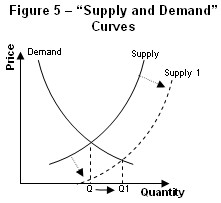
Supply Shifts
In this supply and demand chart we see an increase in the supply provided, shifting quantity to the right and price down. More of a given product, assuming the same demand, will result in lower price points at the equilibrium.
Supply shifts, similar to demand shifts, can ultimately be a result of a wide variety of external factors. As discussed above, scarcity plays a critical role in pricing and thus controlling supply is often even considered a strategic play by companies in specific industries (most notably industries like precious stones, rare earth metals, etc.). Supply shifts can also be a result of technological advances, over-utilization or consumption, globalization, supply-chain efficiency, and economics. For example, the discovery of a new gold deposit, acts as a shock to the supply of gold, shifting the curve right.
Equilibrium
In combining these two potential shifts, equilibrium is constantly subjected to both factors resulting in supply shifts and factors resulting in demand shifts. Due to the demand curve sloping downward and the supply curve sloping upwards, they inadvertently will cross at some given point on any supply/demand chart. This cross-section, or equilibrium, serves as a price and quantity tracking point based upon the consistent inputs of overall demand and supply availability. Any change in either factor will result in immediate impact on equilibrium, balancing the new demand or supply with a corresponding volume and appropriate average price point.
3.4: Government Intervention and Disequilibrium
3.4.1: Why Governments Intervene In Markets
Governments intervene in markets when they inefficiently allocate resources.
Learning Objective
Identify reasons why the government might choose to intervene in markets.
Key Points
- The government tries to combat market inequities through regulation, taxation, and subsidies.
- Governments may also intervene in markets to promote general economic fairness.
- Maximizing social welfare is one of the most common and best understood reasons for government intervention. Examples of this include breaking up monopolies and regulating negative externalities like pollution.
- Governments may sometimes intervene in markets to promote other goals, such as national unity and advancement.
Key Term
- inefficient market
-
An economy where social optimality is not acheived; an economy where resources are not optimally allocated
Governments intervene in markets to address inefficiency. In an optimally efficient market, resources are perfectly allocated to those that need them in the amounts they need. In inefficient markets that is not the case; some may have too much of a resource while others do not have enough. Inefficiency can take many different forms. The government tries to combat these inequities through regulation, taxation, and subsidies. Most governments have any combination of four different objectives when they intervene in the market.
Maximizing Social Welfare
In an unregulated inefficient market, cartels and other types of organizations can wield monopolistic power, raising entry costs and limiting the development of infrastructure. Without regulation, businesses can produce negative externalities without consequence. This all leads to diminished resources, stifled innovation, and minimized trade and its corresponding benefits. Government intervention through regulation can directly address these issues.
Another example of intervention to promote social welfare involves public goods. Certain depletable goods, like public parks, aren’t owned by an individual. This means that no price is assigned to the use of that good and everyone can use it. As a result, it is very easy for these assets to be depleted. Governments intervene to ensure those resources are not depleted.
Macro-Economic Factors
Governments also intervene to minimize the damage caused by naturally occurring economic events. Recessions and inflation are part of the natural business cycle but can have a devastating effect on citizens. In these cases, governments intervene through subsidies and manipulation of the money supply to minimize the harsh impact of economic forces on its constituents.
Socio-Economic Factors
Governments may also intervene in markets to promote general economic fairness . Government often try, through taxation and welfare programs, to reallocate financial resources from the wealthy to those that are most in need. Other examples of market intervention for socio-economic reasons include employment laws to protect certain segments of the population and the regulation of the manufacture of certain products to ensure the health and well-being of consumers.

Former President Bill Clinton signing welfare reform
Former President signing a welfare reform bill. Welfare programs are one way governments intervene in markets.
Other Objectives
Governments can sometimes intervene in markets to promote other goals, such as national unity and advancement. Most people agree that governments should provide a military for the protection of its citizens, and this can be seen as a type of intervention. Growing a large and impressive military not only increases a country’s security, but may also be a source of pride. Intervening in a way that promotes national unity and pride can be an extremely valuable goal for government officials.
3.4.2: Price Ceilings
A price ceiling is a price control that limits how high a price can be charged for a good or service.
Learning Objective
Define price ceilings.
Key Points
- For a price ceiling to be effective, it must be less than the free-market equilibrium price.
- The purpose of a price ceiling is to protect consumers of a certain good or service. By establishing a maximum price, a government wants to ensure the good is affordable for as many consumers as possible.
- Rent control is an example of a price ceiling.
Key Terms
- free-market equilibrium price
-
The price established through competition such that the amount of goods or services sought by buyers is equal to the amount of goods or services produced by sellers
- Price ceiling
-
An artificially set maximum price in a market.
A price ceiling is a price control that limits the maximum price that can be charged for a product or service. Generally ceilings are set by governments, although groups that manage exchanges can set ceilings as well. The purpose of a price ceiling is to protect consumers of a certain good or service. By establishing a minimum price, a government wants to ensure the good is affordable for as many consumers as possible .

US Poster for Price Ceilings
Governments often impose price ceilings in times of war to ensure goods are available to as many people as possible.
An example of a price ceiling is rent control. These regulations require a more gradual increase in rent prices than what the market may demand. This regulation is meant to protect current tenants. Without rent control, there could be situations where the demand for housing in an area could cause rent prices to make a substantial jump. Unable to afford the new, significantly higher rent, a majority of the neighborhood’s tenants may be forced to move out of the neighborhood. Rent controls limit the possibility of tenant displacement by minimizing the amount by which rent can be increased.
By definition, however, price ceilings disrupt the market. By setting a maximum price, any market in which the equilibrium price is above the price ceiling is inefficient. There will be excess demand because the price cannot increase enough to clear the excess.
For a price ceiling to be effective, it must be less than the free-market equilibrium price. This is the price established through competition such that the amount of goods or services sought by buyers is equal to the amount of goods or services produced by sellers. It is also the price that the market will naturally set for a given good or service. If the price ceiling is higher than what the market would already charge, the regulation would not be effective. As a result, a government will do significant research into the current market conditions for a good before setting a price ceiling.
3.4.3: Price Ceiling Impact on Market Outcome
A binding price ceiling will create a surplus of supply and will lead to a decrease in economic surplus.
Learning Objective
Explain how price controls lead to economic inefficiency
Key Points
- A price ceiling has an economic impact only if it is less than the free-market equilibrium price.
- An effective price ceiling will lower the price of a good, which decreases the producer surplus. The effective price ceiling will also decrease the price for consumers, but any benefit gained from that will be minimized by the decreased sales due to the drop in supply caused by the lower price.
- If a ceiling is to be imposed for a long period of time, a government may need to ration the good to ensure availability for the greatest number of consumers.
- Prolonged shortages caused by price ceilings can create black markets for that good.
Key Terms
- Price ceiling
-
An artificially set maximum price in a market.
- black market
-
trade that is in violation of restrictions, rationing or price controls
A price ceiling will only impact the market if the ceiling is set below the free-market equilibrium price. This is because a price ceiling above the equilibrium price will lead to the product being sold at the equilibrium price.If the ceiling is less than the economic price, the immediate result will be a supply shortage. As you can see from the chart below, a lower base price means less of a good will be produced. The quantity demanded will increase because more people will be willing to pay the lower price to get the good while producers will be willing to supply less, leading to a shortage.

Price Ceiling Chart
If a price ceiling is set below the free-market equilibrium price (as shown where the supply and demand curves intersect), the result will be a shortage of the good in the market. The dead weight loss, represented in yellow, is the minimum dead weight loss in such a scenario. If individuals who value the good most are not capable of purchasing it, there is a potential for a higher amount of dead weight loss.
A price ceiling will also lead to a more inefficient market and a decreased total economic surplus. Economic surplus, or total welfare, is the sum of consumer and producer surplus. Consumer surplus is the monetary gain obtained by consumers because they are able to purchase a product for a price that is less than the highest that they are willing pay. Producer surplus is the amount that producers benefit by selling at a market price that is higher than the least they would be willing to sell for. An effective price ceiling will lower the price of a good, which means that the the producer surplus will decrease. While the effective price ceiling will also decrease the price for consumers, any benefit gained from that will be minimized by decreased sales caused by decreased available supply for sale from producers due to the decrease in price. This translates into a net decrease total economic surplus, otherwise known as deadweight loss. This loss is signified in the attached chart as the yellow triangle.
Rationing
If a ceiling is to be imposed for a long period of time, a government may need to ration the good to ensure availability for the greatest number of consumers. One way the government may ration the good is to issue ticket to consumers. A government will only allow as much of good to be out in the marketplace as there are available tickets. To obtain the good, the consumer must present the ticket and the money to the vendor when making the purchase. This is generally considered a fair way to minimize the impact of a shortage caused by a ceiling, but is generally reserved for times of war or severe economic distress.
Black Market
Prolonged shortages caused by price ceilings can create black markets for that good. A black market is an underground network of producers that will sell consumers as much of a controlled good as they want, but at a price higher than the price ceiling. Black markets are generally illegal. However these markets provide higher profits for producers and more of a good for a consumers, so many are willing to take the risk of fines or imprisonment.
3.4.4: Price Floors
A binding price floor is a price control that limits how low a price can be charged for a product or service.
Learning Objective
Define Price Floors.
Key Points
- For a price floor to be affect the market, it must be greater than the free-market equilibrium price.
- Price floors above the equilibrium price will induce a surplus.
- The federal minimum wage is an example of a price floor.
Key Terms
- free-market equilibrium price
-
The price established through competition such that the amount of goods or services sought by buyers is equal to the amount of goods or services produced by sellers
- price floor
-
A mandated minimum price for a product in a market.
A price floor is a price control that limits how low a price can be charged for a product or service. Generally floors are set by governments, although groups that manage exchanges can set price floors as well. The purpose of a price floor is to protect producers of a certain good or service. By establishing a minimum price, a government seeks to promote the production of the good or service and ensure that the producers have sufficient resources to go about their work.
For a price floor to be effective, it must be greater than the free-market equilibrium price. This is the price established through competition such that the amount of goods or services sought by buyers is equal to the amount of goods or services produced by sellers. It is also the price that the market will naturally set for a given good or service. If the price floor is lower than what the market would already charge, the regulation would serve no purpose. Since the price is set artificially high, there will be a surplus: there will be a higher quantity supplied and a lower quantity demanded than in a free market . As a result, a government will generally do significant research into the current market conditions for a good or service before setting a price floor.
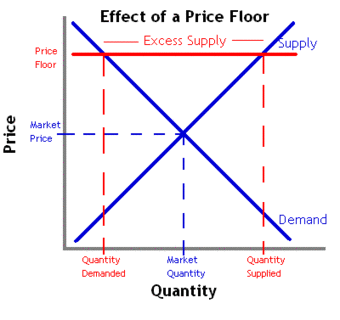
Price Floor
If a price floor is set above the equilibrium price, consumers will demand less and producers will supply more.
An example of a price floor is the federal minimum wage. In this case the suppliers are employees and employers are the consumers. The federal government has established a price that all employers must pay their workers. Obviously employers can pay more than that amount, but they cannot pay less. The purpose of setting this floor is to ensure that all employees make enough money from their jobs to provide for their basic needs.

History of the Federal Minimum Wage
History of the federal minimum wage in real and nominal dollars. The federal minimum wage is one example of a price floor.
3.4.5: Price Floor Impact on Market Outcome
Binding price floors typically cause excess supply and decreased total economic surplus.
Learning Objective
Show how price floors contribute to market inefficiency
Key Points
- A price floor is economically consequential if it is greater than the free-market equilibrium price.
- Price floors lead to a surplus of the product.
- Supply surplusses created by price floors are generally added to producer’s inventory or are purchased by governments.
- Consumer surplus is the gain obtained by consumers because they can obtain a product for a lower price than they would be willing to pay.
- Producer surplus is the benefit producers get by selling at a price higher than the lowest price they would sell for.
Key Terms
- free-market equilibrium price
-
The price established through competition such that the amount of goods or services sought by buyers is equal to the amount of goods or services produced by sellers
- price floor
-
A mandated minimum price for a product in a market.
A price floor will only impact the market if it is greater than the free-market equilibrium price. If the floor is greater than the economic price, the immediate result will be a supply surplus. As you can see from , a higher base price will lead to a higher quantity supplied. However, quantity demand will decrease because fewer people will be willing to pay the higher price. This will lead to a surplus of supply.

Surplus from a price floor
If a price floor is set above the free-market equilibrium price (as shown where the supply and demand curves intersect), the result will be a surplus of the good in the market.
A price floor will also lead to a more inefficient market and a decreased total economic surplus. Economic surplus, or total welfare, is the sum of consumer and producer surplus. Consumer surplus is the monetary gain obtained by consumers because they are able to purchase a product for a price that is less than the highest that they are willing pay. Producer surplus is the amount that producers benefit by selling at a market price that is higher than the least they would be willing to sell for. An effective price floor will raise the price of a good, which means that the the consumer surplus will decrease. While the effective price floor will also increase the price for producers, any benefit gained from that will be minimized by decreased sales caused by decreased demand from consumers due to the increase in price. This translates into a net decrease total economic surplus, otherwise known as deadweight loss.
Since well designed price floors create surpluses, the big issue is what to do with the excess supply. The first option is to let inventories grow and have the private producers bear the cost of storing it. The other option is for the government that set the price floor to purchase the excess supply and store it on its own. The government could then sell the surplus off at a loss in times of a food shortage.
3.4.6: Introduction to Deadweight Loss
Deadweight loss is the decrease in economic efficiency that occurs when a good or service is not priced at its pareto optimal level.
Learning Objective
Define deadweight loss
Key Points
- Deadweight loss can be caused by monopolies, binding price controls, taxes, subsidies, and externalities.
- When deadweight loss occurs, it comes at the expense of consumer surplus and/or producer surplus.
- Deadweight loss can be visually represented on supply and demand graphs as a figure known as Harberger’s triangle.
Key Terms
- Pareto optimal
-
Describing a situation in which the profit of one party cannot be increased without reducing the profit of another.
- deadweight loss
-
A loss of economic efficiency that can occur when an equilibrium is not Pareto optimal.
Deadweight loss is the decrease in economic efficiency that occurs when a good or service is not priced and produced at its pareto optimal level. When output is at its pareto optimal point, the price, production, and consumption of a good cannot be altered for one person’s benefit without making at least one other worse off. In a perfectly competitive market, products are priced at the pareto optimal point.
When deadweight loss occurs, it comes at the expense of either the consumer economic surplus or the producer’s economic surplus. Consumer surplus is the gain that consumers receive when they are able to purchase a product for less than the price they are willing to pay; producer surplus is the benefit producers receive when the sell a product for more than they are willing to sell for. While price controls, subsidies and other forms of market intervention might increase consumer or producer surplus, economic theory states that any gain would be outweighed by the losses sustained by the other side. This net harm is what causes deadweight loss.
Deadweight loss can be visually represented on supply and demand graphs . Known as Harberger’s triangle, the deadweight loss equals the area within the following three points:

Deadweight loss
This chart illustrates the deadweight loss created when a price floor is instituted on the market for a good. The amount of deadweight loss is shown by the triangle highlighted in yellow. This area is known as Harberger’s triangle.
- where the supply and demand curve intersect, otherwise known as the free market equilibrium;
- the point on the supply curve where the y-coordinate equals the non-pareto optimal price;
- the point on the demand curve where the y-coordinate equals the non-pareto optimal price.
Example – Price Ceilings and Deadweight Loss
The chart above shows what happens when a market has a binding price ceiling below the free market price. Without the price ceiling, the producer surplus on the chart would be everything to the left of the supply curve and below the horizontal line where y equals the free market equilibrium price. The consumer surplus would equal everything to the left of the demand curve and above the free market equilibrium price line.
With the price ceiling, instead of the producer’s surplus going all the way to the pareto optimal price line, it only goes as high as the price ceiling.The consumer surplus extends down to the price ceiling, but it is limited on the right by Harberger’s triangle. In this case, the reason for that limitation is due to quantity produced. The consumer would purchaser more of the product at the ceiling price, but the producers are unwilling to supply enough to meet that demand because it is not profitable. As a result all of the goods that might have been produced and consumed if the good was priced optimally are not, representing a net loss for society.
3.4.7: Arguments for and Against Government Price Controls
Many argue that price controls ensure resource availability, but most economists agree that these controls should be used sparingly.
Learning Objective
Justify the use of price controls when certain conditions are met
Key Points
- The main appeal of governmental imposed price controls is that they can ensure that citizens can purchase what they need in times of national economic hardship.
- Well designed price controls can ensure that basic staples are affordable, minimize the possibility of shortages, and prevent price gouging when shortages occur.
- By keeping prices artificially low through price ceilings, economists argue that demand is increased to a point where supply cannot keep up, leading to a shortage in the controlled product.
- Price floors often lead to surpluses, which can be just as detrimental as a shortage.
Key Terms
- Price control
-
A law that sets the maximum or minimum amount for which a good may be sold.
- staple
-
A basic or essential supply.
When unemployment is especially high or when there is a shortage of goods, it can be difficult for people to get what they need at an affordable price. The main appeal of government imposed price controls is that they can ensure that citizens can purchase what they need in times of national economic hardship .
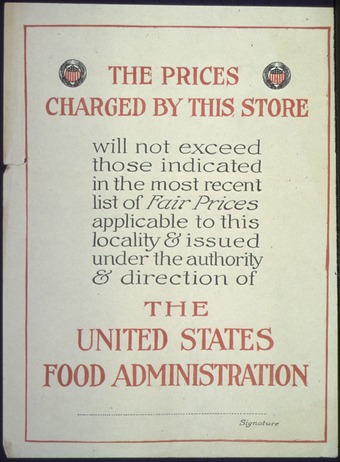
USFA Depression Price Fixing Poster
During the depression the US government fixed prices on basic staples, such as food, to ensure people would be able to obtain their basic necessities.
Well designed price controls can do three things. First, these regulations can ensure that a basic staple, such as food, remains affordable to most of a country’s citizens. Second, regulation can protect the producers of a good and ensure that they get sufficient revenue. This in turn limits the possibility of shortages, which benefits consumer. Finally, when shortages occur, price controls can prevent producers from gouging their customers on price.
Generally price controls are used in combination with other forms of government economic intervention, such as wage controls and other regulatory elements.
While price controls may appear to be a sound decision in theory, most economists believe these controls should be used sparingly. By keeping prices artificially low through price ceilings, consumers demand a higher quantity than producers are willing to supply, leading to a shortage in the controlled product. As Nobel Prize winner Milton Friedman said, “We economists do not know much, but we do know how to create a shortage. If you want to create a shortage of tomatoes, for example, just pass a law that retailers can’t sell tomatoes for more than two cents per pound. Instantly you’ll have a tomato shortage. “
Price floors often lead to surpluses, which can be just as detrimental as a shortage. One of the best known price floors in the minimum wage, which establishes a base line per hour wage that must be paid for work. As a result, employers hire fewer employees than they would if they could pay workers lower than the minimum wage. As a result the supply of workers is greater than the amount of work, which creates higher unemployment.
3.4.8: Taxes
Governments use its tax systems to raise funds for its programs and influence its citizens’ economic actions.
Learning Objective
Categorize types of taxes into ad valorem taxes and excise taxes
Key Points
- A good tax system should be efficient, understandable and equitable. It should also allocate the costs of public services to those who use it, although that principle is hard to execute in practice.
- A direct tax is assessed on a person’s income. Indirect taxes are assessed on an individual’s participation in certain activities, such as making a purchase.
- The three types of tax systems are proportional, progressive, and regressive.
- Ad valorem and excise taxes are two types of indirect taxes.
Key Terms
- progressive
-
Increasing in rate as the taxable amount increases
- regressive
-
Whose rate decreases as the amount increases.
Taxes are the primary means for governments to raise funds for its programs and to pay off its debts. It can also be used to influence its citizens’ financial behavior. . Choosing the right set of rules that have all of the elements of a good tax system can be a challenge for any government.
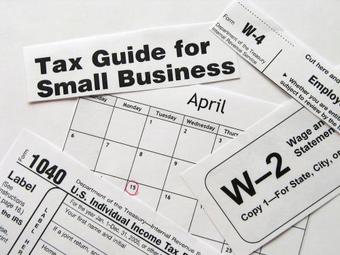
tax
Taxes are a tool used by governments to raise money and influence their citizens’ economic choices.
Elements of a Good Tax System
- Efficient: A tax system should raise the necessary revenues without unduly burdening the taxpayer.
- Understandable: A tax system should be easily understandable by the average citizen who has to pay the tax.
- Equitable:The tax burden should be distributed equitably among a nation’s citizens. Generally, this means that those that are wealthier should pay more.
- Benefit Principle: Generally, the people who use public services should pay for them with higher taxes. However this principle is difficult to enforce in practice.
Two Types of Tax Systems
- Direct Taxation: A direct tax is assessed on the income of the taxpayer and is generally collected before the taxpayer collects his wages.
- Indirect Taxation: An indirect tax is an avoidable tax assessed on certain activities, such as purchasing goods or services. Examples of an indirect tax include sales tax and VAT (value added tax).
Types of Tax Structures
- Proportional Tax: Otherwise known as a flat tax, a flat tax rate is applied to all earned income regardless of how much the taxpayer earns. So a person making $20,000 would pay the same rate as a person making $120,000, but would pay significantly less in real dollars.
- Progressive Tax: The more a person earns, the higher the tax rate. Generally in a progressive tax system, income is divided into “brackets. ” For example, assume a tax system divides earners into people two groups. Those who earn less than $100,000 pay 10% and people who earn $100,000 or more pay 20%. A person earning $20,000 would have to pay 10%, or $2,000, while a person who earns $120,000 would have to pay 20%, or $24,000.
- Regressive Tax:In a regressive tax system, poorer families pay a higher tax rate. Although a regressive tax system is never explicitly used, some claim a sales tax is a type of regressive tax. Since high income earners spend a lower proportion of their income on goods and services in comparison to low income earners, the rich tend to pay proportionally less sales tax.
Ad Valorem vs Excise Tax
Ad Valorem (or Value Added) and Excise Taxes are types of indirect taxes. Both are generally assessed on the sale of goods. These two taxes differ in three ways:
- An excise tax typically applies to a narrower range of products, such as gasoline, tobacco, and alcohol.
- An excise tax is typically heavier than an ad valorem, accounting for a higher fraction of a product’s retail price.
- Excise taxes are typically a fixed fee per unit, meaning that the government earns its revenue based on volume sold. Ad valorem taxes are proportional to the price of the good, so the government earns revenue based on the value of the good or service being sold.
3.4.9: Taxation Impact on Economic Output
Tax incidence falls mostly upon the group that responds least to price, or has the most inelastic price-quantity curve.
Learning Objective
Analyze how changes in taxes affect the price of a good for sellers and buyers
Key Points
- When supply is inelastic and demand is elastic, the tax incidence falls on the producer.
- When supply is elastic and demand is inelastic, the tax incidence falls on the consumer.
- Tax incidence is the analysis of the effect a particular tax has on the two parties of a transaction; the producer that makes the good and the consumer that buys it.
- A marginal tax is an increase in a tax on a good that shifts the supply curve to the left, increases the consumer price, and decreases the price for the sellers.
Key Terms
- elastic
-
Sensitive to changes in price.
- Tax incidence
-
The effect a particular tax has on the two parties of a transaction.
Tax incidence is the effect a particular tax has on the two parties of a transaction; the producer that makes the good and the consumer that buys it. The burden of the tax is not dependent on whether the state collects the revenue from the producer or consumer, but on the price elasticity of supply and the price elasticity of demand. To understand how elasticities influence tax incidence, its important to consider the two extreme scenarios and how the tax burden is distributed between the two parties.
Inelastic supply, elastic demand
Because supply is inelastic, the firm will produce the same quantity no matter what the price. Because demand is elastic, the consumer is very sensitive to price. A small increase in price leads to a large drop in the quantity demanded. The imposition of the tax causes the market price to increase and the quantity demanded to decrease. Because consumption is elastic, the price consumers pay doesn’t change very much. Because production is inelastic, the amount sold changes significantly. The producer is unable to pass the tax onto the consumer and the tax incidence falls on the producer .

Tax Incidence of Producer
When supply is inelastic but demand is elastic, the majority of the tax is paid for by the consumer. Since quantity demanded drops significantly in this scenario, the producer is forced to sell less.
Elastic supply, inelastic demand
Consumption is inelastic, so the consumer will consume the same quantity no matter the price. The producer will be able to produce the same amount of the good, but will be able to increase the price by the amount of the tax. As a result, the entirety of the tax will be borne by the consumer.
Similarly elastic supply and demand
Generally consumers and producers are neither perfectly elastic or inelastic, so the tax burden is shared between the two parties in varying proportions. If one party is comparatively more inelastic than the other, they will pay the majority of the tax.
Increasing tax
If the government increases the tax on a good, that shifts the supply curve to the left, the consumer price increases, and sellers’ price decreases. A tax increase does not affect the demand curve, nor does it make supply or demand more or less elastic. This potential increase in tax could be called marginal, because it is a tax in addition to existing levies.
Chapter 2: The Market System
2.1: Introducing the Market System
2.1.1: Defining a Market System
A market system is a way to match buyers and sellers.
Learning Objective
Identify the characteristics of a market system
Key Points
- Publishing current prices is a key component with a market system.
- Competition is the primary regulatory mechanism in a market system.
- Economists recognize a number of different structures of market systems based on characteristics such as the level of competition.
Key Term
- price
-
The quantity of payment or compensation given by one party to another in return for goods or services.
In an economy, a market system is any systematic process that enables many market players to bid and ask. In other words, a market system is a place (virtual or physical) that facilitates the matching of buyers and sellers. Many markets exist, and each can be defined based on a number of characteristics, such as what is being exchanged in the market, the regulations, who is allowed to participate, and how transactions occur.
One defining component of markets is the medium of exchange, or the price. In most American markets, the medium of exchange is dollars. Both buyers and sellers look at the price to determine whether or not they want to trade. A seller has a certain minimum price at which s/he is willing to sell, though s/he would happily accept more. Likewise, a buyer has a certain maximum price at which s/he is willing to buy, though s/he would happily pay less. If the minimum the seller would accept is less than the maximum a buyer would pay, a transaction can occur. Markets help such buyers and sellers meet to trade.
In market systems, prices are discoverable; both buyers and sellers are capable of finding out the current price at which a transaction could occur. Publishing current prices is a key component with a market system. The chosen prices impact the immediate group of buyers and sellers, but also may impact long term supply and demand decisions within the market.
There are many examples of market systems. Perhaps the most famous is the stock market in which buyers and sellers trade stocks . The prices at which those sales occur is recorded, and is the basis for the stock price you may have seen in the newspaper or on TV. There are markets for many types of products other than stocks: the global oil market, your local farmers’ market, and eBay are all forms of markets with their own defining characteristics.

NASDAQ Stock Market Display
The NASDAQ is a stock market where buyers and sellers of stocks can meet and trade.
Another important component of market systems is that there is competition, which serves as the main regulatory mechanism. Based on the level of competition in a market system, economists have identified a number of different types of structures, such as monopoly, oligopoly, and perfect competition. We will go into more detail on different market structures later in the book.
2.1.2: Gains from Markets
Gains in a market are referred to as total welfare or economic surplus.
Learning Objective
Explain how to calculate total welfare
Key Points
- Within total welfare, economists look at consumer surplus and producer surplus.
- Consumer surplus is the monetary gain that consumers receive when they purchase a good for less than the highest price they are willing to pay.
- Producer surplus is the amount that producers benefit by selling a good at a market price that is higher than the least that they would be willing to sell it for.
- In order to calculate the total welfare, the supply and demand of the good must be used to determine the economic gain.
- When the supply of a good increases, the price falls which increases consumer surplus. When the demand for a good increases, the price increases and the supply decreases resulting in producer surplus.
Key Term
- welfare
-
Health, safety, happiness and prosperity; well-being in any respect.
Gains within a market are referred to as total welfare or economic surplus. Within total welfare, economists look at consumer surplus and producer surplus . A surplus is defined as the excess of a good or service when the quantity supplied exceeds the quantity demanded; this occurs when the price is above the equilibrium price.

Economic Surpluses
The total welfare (or economic surplus) is the sum of the consumer surplus and the producer surplus.
Consumer surplus is the monetary gain that consumers receive when they purchase a good for less than the highest price they are willing to pay. For example, a customer is willing to pay $50 for a new pair of running shoes. They are able to purchase the pair for $35 and consumer surplus is $15.
Producer surplus is the amount that producers benefit by selling a good at a market price that is higher than the least that they would be willing to sell it for. An example would be a manufacturer that makes jeans. The lowest price the producer is willing to sell a pair of jeans for is $40, but the jeans actually sell for $50. The producer surplus is $10.
In order to calculate the total welfare, the supply and demand of the good must be used to determine the economic gain. On a demand and supply curve graph, the consumer surplus is located under the demand curve and above a horizontal line that shows the actual price of a good (equilibrium price).
When the supply of a good increases, the price falls which increases consumer surplus. When the demand for a good increases, the price increases and the supply decreases resulting in producer surplus. When a good is in high demand, consumers are willing to pay more in order to obtain the good.
2.1.3: Production Possibility Frontier
A production-possibility frontier (PPF) graphs the combinations for the production of two commodities with which the same amounts are used.
Learning Objective
Explain the benefits of trade and exchange using the production possibilities frontier (PPF)
Key Points
- A PPF graph shows the maximum production level for one commodity for any production level of the other commodity.
- If a point on the graph is above the curve it indicates efficiency, while a point below the curve signifies inefficiency.
- The PPF graph shows how resources must be shared among goods during the production process.
- Within an economy, if the capacity to produce both goods increases which results in economic growth.
Key Terms
- commodity
-
Raw materials, agricultural and other primary products as objects of large-scale trading in specialized exchanges.
- marginal
-
Of, relating to, or located at or near a margin or edge; also figurative usages of location and margin (edge).
Within a market system, economists use the production possibility frontier (PPF) to graph the combinations of the amounts of two commodities that can be produced using the same amount of each factor of production. A PPF graph chooses specific input quantities. As a result, it shows the maximum production level for one commodity for any production level of the other commodity . PPF is used to define production efficiency.

A common PPF
A common PPF where there is an increase in opportunity cost.
Within a PPF graph, the use of a curve or line acts as a benchmark for measuring efficiency. If a point on the graph is above the curve it indicates efficiency, while a point below the curve signifies inefficiency. For further analysis, additional information is always supplied with a PPF including the period of time taken for the observation, production technologies, and the amounts of inputs that were available.
Economists can use a PPF to illustrate a number of economic concepts including scarcity, opportunity cost, productive efficiency, allocative efficiency, and economies of scale.
When an economy is operating on the PPF curve it is efficient. It is not possible to produce more of one good without decreasing the amount produced for the other good. Likewise, if the economy is operating below the PPF curve, it is inefficient. In this case, the economy can reallocate resources and produce more of both the goods.
The PPF graph shows how resources must be shared among goods during the production process. The points of the graph show the trade-off that takes place between two goods. For example, if more of Good A needs to be produced, the amount of resources in use by Good B must be reduced and transferred to Good A. The sacrifice in production of Good B is called opportunity cost. When graphing PPF there are three types: the common, the straight line, and the inverted PPF . All three of the PPF graphs are directly influenced by the opportunity cost.

An inverted PPF
An inverted PPF where the opportunity cost is decreasing.

A straight line PPF
A straight line PPF where the opportunity cost is constant.
The slope of the PPF shows the rate at which the production of one good can be transferred to another. The slope is called the marginal rate of transformation (MRT).
Within an economy, if the capacity to produce both goods increases, the result is economic growth. Factors that influence economic capacity include technology, an increase in the supply of factors of production, and production interactions such as trade and exchange. When any of these factors are used it allows for an increase in capacity so that the production of neither good has to be sacrificed.
PPF graphs help economists study the current state of production as well as possible production scenarios. The output of the economy is impacted by many factors. When production can be graphed and monitored it allows adjustments to be made to work towards attaining economic growth and stability.
2.1.4: The Circular Flow Model
In economics, a circular flow model is a diagram that is used to represent the monetary transactions in an economy.
Learning Objective
State the function of the circular flow diagram and the production possibilities frontier
Key Points
- There are two flows present within the model including flows of physical things (goods or labor) and flows of money (what pays for physical things).
- The circular flow of income follows a specific pattern: Production → Income → Expenditure → Production.
- The production possibility frontier can be used to illustrate the circular flow model.
- Economists use data, statistics, and natural experiments in order to make economic “laws” that explain general patterns.
Key Terms
- expenditure
-
Act of expending or paying out.
- Factors of production
-
In economics, factors of production are inputs. They may also refer specifically to the primary factors, which are stocks including land, labor, and capital goods applied to production.
In economics, a circular flow model is a diagram that is used to represent the monetary transactions in an economy. There are two flows present within the model including flows of physical things (goods or labor) and flows of money (what pays for physical things). A circular flow model depicts the inner workings of a market system and specific portions of the economy.
The basic circular flow model consists of two sectors that determine income, expenditure, and output. A state of equilibrium is reached when there is no tendency for the levels of income (
), expenditure (
), and output (
) to change (
). This equation means that the expenditure of buyers (households) becomes income for sellers (firms). The firms spend the income on factors of production, which “transfers” the income to the factor owners. The factor owners spend the income on goods which leads to the circular flow of payments .
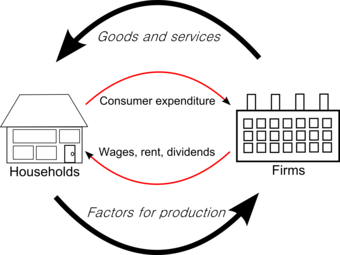
Circular flow of goods income
The circular flow model shows the flow of payments between households and firms.
The circular flow of payments is important within an economy because it 1) measures the national income, 2) provides knowledge of interdependence, 3) illustrates the unending nature of economic activities, and 4) shows injections and leakages.
The circular flow of income follows a specific pattern: Production → Income → Expenditure → Production. This circular flow is ongoing between households and firms.
The circular flow of income can also be analyzed using the production possibility frontier (PPF). The PPF is a graph that shows the various combinations of amounts of two commodities that could be produced using the same fixed total amount of each of the factors of production. The graph shows the maximum possible production level of one commodity for any production level of the other, based on the state of technology. The PPF defines production efficiency. A point of the frontier line indicates the efficient use of available inputs, while a point beneath the curve shows inefficiency. A PPF graphs shows opportunity cost, actual output, potential output, and economic growth.

Production Possibilities Frontier Curve
The graph illustrates a typical production possibilities frontier curve. When a market is operating on the PPF it is said to be efficient.
Chapter 1: Principles of Economics
1.1: The Study of Economics
1.1.1: The Magic of the Economy
The study of economics makes individuals cognizant of their environment and better decision makers.
Learning Objective
Explain how the study of economics provides knowledge to understand the system and policies that guide life.
Key Points
- Economics also allows individual agents to balance expectations.
- Economics provides distilled frameworks to analyze complex societal interactions, as in the case of consumer and firm behavior.
- Being knowledgable about economics foundations allows an individual to be an active and aware participant rather than a passive economic agent.
Key Terms
- circular flow
-
A model of market economy that shows the flow of dollars between households and firms.
- externality
-
An impact, positive or negative, on any party not involved in a given economic transaction or act.
Economics is a social science. This means that economics has two important attributes. Economics studies human activities and constructions in environments with scarce resources, and uses the scientific method and empirical evidence to build its base of knowledge.
The evaluation of human interactions as it relates to preferences, decision making, and constraints is a significant foundation of economic theory. The complexity of the dynamics of human motivation and systems has led to the establishment of assumptions that form the basis of the theory of consumer and firm behavior, both of which are used to model circular flow interactions within the economy .
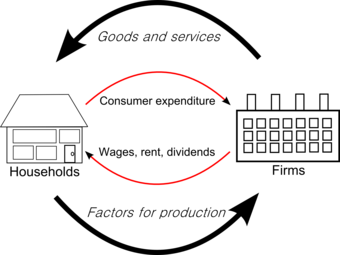
Circular Flow of the Economy
Economics provides an accessible foundation for understanding the complexity of the interactions in the world. For example, the circular flow diagram displays the economic framework related to the dynamic interconnectedness of economic agents. In the graph above the display is limited to households and firms but other depictions of circular flow incorporate the government and international trading partners.
Economics provides distilled frameworks to analyze complex societal interactions, as in the case of consumer and firm behavior. An understanding of how wages and consumption flow between consumers and producers provides agents with an ability to understand the symbiosis of the relationship rather than fixating on the contentious components that surface from time to time.
Economics also allows individual agents to balance expectations. An understanding of the ebb and flow of the economy through the boom and bust of the business cycles, creates the potential for emotional balance by reminding agents to limit desperation in downturns and exuberance in expansions.
By developing an understanding of the foundations of economics, individuals can become better decision makers with respect to their own lives and maintain a balance with respect to an externality that has the potential to supplement or deter their plans. Since economic theories are a basis of decision making and regulatory policy, being knowledgable about economics foundations allows an individual to be an active and aware participant rather than a passive economic agent.
1.1.2: Is Economics a Science?
Economics is a social science that has diverse applications.
Learning Objective
Explain how economic theory and analysis can be applied throughout society
Key Points
- Economics incorporates both qualitative and quantitative assessment.
- Economics is divided into two broad areas: microeconomics and macroeconomics.
- Economics can be applied throughout society from business to individual behavior with further application in the study of crime, family and other social institutions and interactions.
Key Term
- social science
-
A branch of science that studies the society and human behavior in it, including anthropology, communication studies, criminology, economics, geography, history, political science, psychology, social studies, and sociology.
Example
- Market interaction between buyers and sellers is an evaluation of social behavior in an activity where each agent is seeking to maximize return and minimize cost. This is a classic scenario of economics, involving social interaction (qualitative) with optimization (quantitative).
Economics is a social science that assesses the relationship between the consumption and production of goods and services in an environment of finite resources. A focus of the subject is how economic agents behave or interact both individually (microeconomics) and in aggregate (macroeconomics).
Microeconomics examines the behavior individual consumers and firms within the market, including assessment of the role of preferences and constraints. Macroeconomics analyzes the entire economy and the issues affecting it. Primary focus areas are unemployment, inflation, economic growth, and monetary and fiscal policy.
The discipline of economics evolved in the mid-19th century through the combination of political economy, social science and philosophy and gained entrenchment with the increased scrutiny of the asymmetric financial and welfare distribution attributed to sovereign rule. Early writings are attributable to Jeremy Bentham, David Ricardo, John Stuart Mill and his son John Mill and are focused on human welfare and benefits rather than capitalism and free markets .
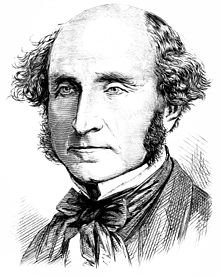
Founders of Economics
John Stuart Mill, along with David Ricardo, Jeremy Bentham and other political and social philosophers of the mid-nineteenth century are credited with the founding of the social-political theory that has evolved to be the discipline of economics.
As in other social sciences, economics does incorporate mathematics in the theoretical and analytics framework of the discipline. Formal economic modeling began in the 19th century with the use of differential calculus to represent and explain economic behavior, such as utility maximization, an early economic application of mathematical optimization in microeconomics. Economics utilizes mathematics to assess the relationships between economic actors in environments in which resources are finite.
The use of mathematics in economics increased the quantitative analysis inherent in the discipline; however, given the discipline’s essentially social science roots, many economists from John Maynard Keynes to Robert Heilbroner and others criticized the broad use of mathematical models for human behavior, arguing that some human choices can not be modeled or evaluated in a mathematical equation.
Economic theory and analysis may be applied throughout society, including business, finance, health care, and government. The underlying components of economic theory can also be applied to variety of other subjects, such as crime, education, the family, law, politics, religion, social institutions, war, and science.
1.2: Individual Decision Making
1.2.1: Scarcity Leads to Tradeoffs and Choice
When scarce resources are used, actors are forced to make choices that have an opportunity cost.
Learning Objective
Give examples of economic trade-offs.
Key Points
- Scarce resources diminish as they are used and almost all resources are scarce.
- In order to use a scarce resource, you are inherently using the resource for one purpose and not an alternative.
- The cost of using a resource is called the opportunity cost: the value of the next best alternative that you could be using the resource for instead.
Key Terms
- Scarce
-
Insufficient to meet demand.
- Opportunity cost
-
The value of the best alternative forgone.
A fundamental concept in economics is that of scarcity. In contrast to its colloquial usage, scarcity in economics connotes not that something is nearly impossible to find, but simply that it is not unlimited. For example, the number of available hours in a day is a scarce resource: there is a finite amount of time available to you to do work, hang out with friends, and relax. Most resources are scarce in most situations.
Since resources tend to be scarce, anyone that uses the resource has to make a decision about how to use it. Suppose, for example, that you are a drink manufacturer. To produce a beverage, you have to use some scarce resources: the plastic for the bottle, the workers’ time, a machine to fill the bottles, etc. If you choose to make one bottle of water, you have chosen to not make a bottle of soda . Your scarce resources force you to make a choice and a trade-off producing one product or another.
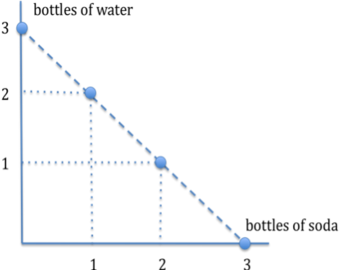
Tradeoffs
Since resources are scarce for a drink manufacturer, it must make a tradeoff between producing bottles of water and bottles of soda.
Like producers, consumers also have to make choices. Often, consumer must choose between current consumption (“I want to buy an ice cream”) and future consumption (“I should rather save my money so I can buy an ice cream tomorrow”). Since consumers’ resources such as time, attention, and money are limited, they must choose how to best allocate them by making tradeoffs.
The concept of trade-offs due to scarcity is formalized by the concept of opportunity cost. The opportunity cost of a choice is the value of the best alternative forgone. In other words, if you can only produce bottles of soda and water, the opportunity cost of producing a bottle of water is the value of producing a bottle of soda. Similarly, there is an opportunity cost in everything: the opportunity cost of you reading this is what you could be doing with your time instead (say, watching a movie). When scarce resources are used (and just about everything is a scarce resource), people and firms are forced to make choices that have an opportunity cost.
1.2.2: Individuals Face Opportunity Costs
Individuals face opportunity costs when they choose one course of action over another.
Learning Objective
Distinguish between explicit costs and opportunity costs
Key Points
- The opportunity cost is the value of the next best alternative foregone.
- Every decision necessarily means giving up other options, which all have a value.
- The opportunity cost is the value one could have derived from using the same resources another way, though this is not always easily quantifiable.
Key Term
- Opportunity Costs
-
The value of the best alternative forgone, in a situation in which a choice needs to be made between several mutually exclusive alternatives given limited resources.
When individuals make decisions, they are necessarily deciding between taking one course of action over another. In doing so, they are choosing both what to do and, by extension, what not to do. The value of the next best choice forgone is called the opportunity cost. In other words, the opportunity cost of a course of action is the value the of the option that the individual chose not to take.
Individuals face opportunity costs in both economic and non-economic decisions. One of the easiest way to imagine an individual’s opportunity costs is to imagine a student who decides to study. By choosing to study, the student is implicitly choosing to not go to a party, hang out with friends, or catch up on some much-needed sleep . In this example, the opportunity cost is not easily expressed in dollars and cents, but is just as real.

Opportunity Cost
By choosing to go to spend time and money on things like classes and computers, you are necessarily choosing not to spend it on something else, like going on vacation. This is an opportunity cost.
Rational individuals will try to minimize their opportunity costs. By doing so, individuals are maximizing the amount that they can get out of their resources (time, money, effort, etc.). This makes sense: individuals should seek to get the most and give up the least.
As economic actors, individuals face opportunity costs as well. For example, suppose you decide to purchase a new computer. You could have chosen to spend your money on books or rent or a spring break trip; whichever one of those options is most valuable to you (beside purchasing a new computer) is the opportunity cost.
Such logic applies for every economic decision: purchasing one good means that an individual has chosen to spend resources one way instead of another. Opportunity costs are an important consideration for economists and business people, but are faced by individuals even when they are not making classically economic decisions.
1.2.3: Individuals Make Decisions at the Margins
Individuals will choose the option that yields the greatest net marginal benefit.
Learning Objective
Apply the concepts of marginal analysis and utility to decision-making
Key Points
- The marginal cost or benefit is the amount that a decision will change the total cost or benefit from where it is currently.
- Individuals will make choice that maximizes the net marginal benefit (marginal benefit – marginal cost).
- While total or average cost and benefit are important, provided enough resources, individuals will look only at the net marginal benefit.
Key Terms
- marginal cost
-
The additional cost from taking a course of action.
- marginal benefit
-
The additional benefit from taking a course of action.
When individuals make decisions, they do so by looking at the additional cost and benefit of the decision. The cost or benefit of the single decision is called the marginal cost or the marginal benefit. This is different from the total or average: net marginal benefit (marginal benefit minus marginal cost) is the amount that total benefit will change due to the single decision. For example, if the cost of making 9 pieces of pizza is $90 and the cost of making 10 pieces is $110, the marginal cost of producing the tenth piece of pizza is $20. In theory, individuals will only choose an option if marginal benefit exceeds marginal cost.

Marginal and Total Utility
Marginal utility is the amount that a certain action will change total utility. Individuals use net marginal utility to make decisions.
Let’s take an example. Suppose you are buying a car and have three choices:
- Car A, which costs $10,000
- Car B, which costs $12,000
- Car C, which costs $15,000
The prices represent the marginal costs of each car; purchasing the car will add the cost of the car to your total costs. Also suppose Car A provides you $15,000 worth of utility, Car B provides $15,000, and Car C provides $25,000. Those utilities, in dollar terms, are the marginal benefit of each car.
In order to make the decision, you look at the marginal cost and marginal benefit of each car. By subtracting the cost from the benefit, Car A offers $5,000 of marginal benefit, Car B offers $3,000, and Car C offers $10,000. Obviously, Car C is the best choice because, at the margins, it offers the most benefit to you.
Note that you are concerned not with your total or average cost and benefit (assuming no resource or other external restrictions), but with the marginal cost and benefit. As a decision maker, you want to know how much the decision will change your current state, so you look at the margins, not the overall picture. That is not to say that things like the total cost are unimportant, but that, assuming there are enough resources, individuals will look at the marginal change each option will provide to his/her life or to the firm and chose the one with the greatest net marginal benefit.
Marginal Benefits and Costs for Pollution
The tools of marginal analysis can illustrate the marginal costs and the marginal benefits of reducing pollution. When the quantity of environmental protection is low (quantity
) and pollution is extensive, there are cheap and easy ways to reduce pollution, and the marginal benefits of doing so are quite high. At
, it makes sense to allocate more resources to fight pollution.
However, as environmental protection increases, the cheap and easy ways of reducing pollution decrease, and pollution can only be reduced with costly methods. In other words, the largest marginal benefits are achieved first, followed by decreasing marginal benefits. As the quantity of environmental protection increases to
, the gap between marginal benefits and marginal costs decreases. At point , the marginal costs will exceed the marginal benefits. At this level of environmental protection, society is not allocating resources efficiently, because too many resources are being given up to reduce pollution.
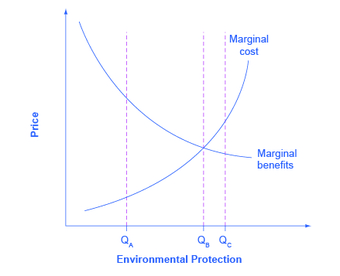
Marginal Costs and Marginal Benefits of Environmental Protection
Reducing pollution is costly—resources must be sacrificed. The marginal costs of reducing pollution are generally increasing, because the least expensive and easiest reductions can be made first, leaving the more expensive methods for later. The marginal benefits of reducing pollution are generally declining, because the steps that provide the greatest benefit can be taken first, and steps that provide less benefit can wait until later.
1.2.4: Individuals Respond to Incentives
Incentives are ways to encourage or discourage certain behaviors or choices.
Learning Objective
Predict how pay incentives will influence a person’s work performance
Key Points
- Price is one of the main incentives studied in economics. Price incentivizes producers to supply a certain amount, and consumers to purchase a certain amount.
- Economics is mainly concerned with studying remunerative incentives (those that concern material reward).
- Individuals, firms, and governments all change incentives in hopes of encouraging desired outcomes.
Key Terms
- Incentive Structure
-
The cumulative set of promised rewards and/or punishments that encourage actors to make a set of decisions.
- incentive
-
Something that motivates an individual to perform an action.
An incentive is something that motivates an individual to perform an action. The study of incentive structures is central to the study of all economic activities (both in terms of individual decision-making and in terms of cooperation and competition within a larger institutional structure).
Perhaps the most notable incentive in economics is price. Price acts as a signal to suppliers to produce and to consumers to buy. For example, a sale is nothing more than a store providing an incentive to potential customers to buy. The lowering of the price makes the purchase a better idea for some customers; the sale seeks to persuade individuals to change their actions (namely, to buy the product).

Sales are Incentives
Sales are incentives for consumers to buy, because firms know consumers generally respond to lower prices by purchasing more.
Similarly, the increase in price acts as an incentive to suppliers to produce more of a good. If suppliers think they can sell their products for more, they will be inclined to produce more. The price acts, therefore, as an incentive to customers to buy and suppliers to produce.
Types of Incentives
Incentives come in many other forms, however. Broadly, most incentives can be grouped into one of four categories:
- Remunerative incentives: The incentive comes in the form of some sort of material reward – especially money – in exchange for acting in a particular way. Wages, prices, and bribery are all examples of remunerative incentives. This is the type of incentive that is typically associated with economics.
- Moral incentives: This occurs when a certain choice is widely regarded as the right thing to do, or as particularly admirable, or where the failure to act in a certain way is condemned as indecent. Societies and cultures are two main sources of moral incentives.
- Coercive incentives: The incentive is a promise of some sort of punishment if the wrong decision is made. For example, the promise of imprisonment is a coercive incentive for people to not steal.
- Natural Incentives: Things such as curiosity, mental or physical exercise, admiration, fear, anger, pain, joy, the pursuit of truth, and a sense of control of people or oneself can cause individuals to make certain decisions.
Economics is mainly concerned with remunerative incentives, though when discussing government regulations, coercive incentives often come into play. By manipulating incentives, individuals (as well as businesses and governments) hope to encourage some behaviors and discourage others.
Incentives and Performance
Companies leverage incentives-based strategies to drive performance and optimize employee decision-making and behaviors through meaningful reward systems. While there are both advantages and drawbacks to this type of approach, remunerative (financial) incentives are highly attractive options for employers in a variety of industries and businesses. Providing incentives such as variable income, where an individual can obtain more personal rewards for successfully creating a product or making a sale, often drives up production for highly motivated employees.
An example of this would be a manufacturing facility making widgets. The floor manager shifts the wage system from an hourly wage perspective to a straight piece rate system. The more widgets a worker creates, the higher his or her prospective income will be. Under this incentive system less productive workers may stay the same, but highly productive workers will respond by increasing their production.
1.3: Interaction of Individuals, Firms, and Societies
1.3.1: Introducing the Firm
Firms allow an economy to operate more efficiently and reduce the transaction costs of coordinating production.
Learning Objective
Explain the importance of private companies and firms in the economy
Key Points
- Firms generally appear and become prevalent as an alternative to individual trade when it is more efficient to produce in a non-market environment.
- Limited liability separates the management of a firm from its ownership, allowing companies to raise money easily because owners do not need to risk everything in the case of bankruptcy.
- Most industries experience increasing returns to scale up to a point, which means that more goods can be produced using fewer resources.
- According to Ronald Coase, the main reason to establish a firm is to avoid some of the transaction costs of using the price mechanism.
Key Terms
- increasing returns to scale
-
The characteristic of production in which output increases by more than the proportional increase in inputs.
- firm
-
A business enterprise, however organized.
“Firm” is simply another word for company or business. The basic economic marketplace consists of transactions between households and firms. Firms use factors of production – land, labor, and capital – to produce goods that are consumed by households. They may be organized in many different ways – corporations, partnerships, sole proprietorships, and collectives are all examples of firms. Economists who study the theory of the firm attempt to describe, explain, and predict the nature of a firm, including its existence, behavior, structure, and relationship to the market.
The Evolution of the Firm
Not all markets and societies involve firms. In many medieval cities, most production was done by individual craftsmen who were loosely organized into guilds, or by tenant farmers who rented family-sized plots of land. Transactions took place primarily between individuals.
Firms generally appear and become prevalent as an alternative to individual trade when it is more efficient to produce in a non-market environment. For example, in a labor market, it might be too difficult or costly for firms or organizations to engage in production when they have to hire and fire their workers depending on demand/supply conditions. While the advantages of consolidation for efficiency are potentially many and varied, the underlying concept is that integrating operational paradigms enables potential synergy via the construct of a firm.
Firms also allow economic growth, not only for the firm but for the broader society in which it resides. Through separating the business from the individual(s) who starts it, the funding, insurance and liability of a firm can function independently of a person. The separation of a firm from the individual also allows more specifically applicable regulations and laws, broader accumulation of investment capital and more complex strategic alliances. While the detailed implications of a firm and it’s relationship with individuals and society are complex, the important takeaway is that firms play an integral role in economic structure.

The Firm
Organizing production under firms reduces the transaction costs of coordinating production in the market.
The Transaction Theory of the Firm
According to Ronald Coase, people begin to organize their production in firms when the transaction cost of coordinating production through the market exchange is greater than within the firm. He notes that a firm’s interactions with the market may not be under its control (for instance because of sales taxes), but its internal allocation of resources are: “Within a firm, … market transactions are eliminated and in place of the complicated market structure with exchange transactions is substituted the entrepreneur … who directs production.” He asks why alternative methods of production (such as the price mechanism and economic planning), could not either achieve all production, so that either firms use internal prices for all their production, or one big firm runs the entire economy.
For Coase the main reason to establish a firm is to avoid some of the transaction costs of using the price mechanism. These include discovering relevant prices (which can be reduced but not eliminated by purchasing this information through specialists), as well as the costs of negotiating and writing enforceable contracts for each transaction (which can be large if there is uncertainty). Moreover, contracts in an uncertain world will necessarily be incomplete and have to be frequently re-negotiated. The costs of haggling about division of surplus, particularly if there is asymmetric information and asset specificity, may be considerable. Organization into a firm can considerably reduce these costs.
1.3.2: Trade Leads to Gains
Producers and consumers trade because the exchange makes both parties better off.
Learning Objective
Explain why parties trade.
Key Points
- The benefit of exchange to producers is measured by the profit the producer makes. The benefit of exchange to a consumer is measured by net utility gained.
- Consumer surplus is the monetary gain obtained by consumers because they are able to purchase a product for a price that is less than the highest price that they would be willing to pay.
- Producer surplus is the amount that producers benefit by selling at a market price that is higher than the least that they would be willing to sell for.
- An allocation of resources is Pareto efficient when it is impossible to make any one individual better off without making at least one individual worse off.
Key Terms
- utility
-
The ability of a commodity to satisfy needs or wants; the satisfaction experienced by the consumer of that commodity.
- consumer surplus
-
The difference between the maximum price a consumer is willing to pay and the actual price they do pay.
- producer surplus
-
The amount that producers benefit by selling at a market price that is higher than the lowest price at which they would be willing to sell.
Producers and consumers trade because the exchange makes both parties better off. The benefit of exchange to producers is measured by the amount of profit – that is, the difference between the average cost of producing an item and the price received for that item. The benefit of exchange to a consumer is measured by net utility gained. This is measured by taking the difference between the maximum price a consumer is willing to pay and the actual price they do pay. To understand this, imagine purchasing a car. You would be willing to pay up to $15,000 for a car in good condition, but you are able to buy one for only $12,000. Since you value the car at $3,000 more than you paid for it, $3,000 is the benefit that you gained from the transaction.
Economists refer to these benefits from exchange as producer and consumer surplus. Consumer surplus is the monetary gain obtained by consumers because they are able to purchase a product for a price that is less than the highest price that they would be willing to pay. Producer surplus is the amount that producers benefit by selling at a market price that is higher than the least that they would be willing to sell for.
The amount of consumer and producer surplus that is gained from a transaction can be seen on a standard supply and demand graph. Consumer surplus is the area (triangular if the supply and demand curves are linear) above the equilibrium price of the good and below the demand curve. This reflects the fact that consumers would have been willing to buy a single unit of the good at a price higher than the equilibrium price, a second unit at a price below that but still above the equilibrium price, etc., yet they in fact pay just the equilibrium price for each unit they buy.
Likewise, in the supply-demand diagram, producer surplus is the area below the equilibrium price but above the supply curve. This reflects the fact that producers would have been willing to supply the first unit at a price lower than the equilibrium price, the second unit at a price above that but still below the equilibrium price, etc., yet they in fact receive the equilibrium price for all the units they sell. The sum of consumer and producer surplus is called economic, or social, surplus, and reflects the total amount of benefit received by society when consumers and producers trade.

Consumer and Producer Surplus
Consumer surplus is the area between the demand line and the equilibrium price, and producer surplus is the area between the supply line and the equilibrium price.
Exchange and Pareto Optimality
An allocation of resources is Pareto efficient when it is impossible to make any one individual better off without making at least one individual worse off. For example, imagine that two individuals prefer peanut butter and jelly sandwiches to a sandwich with only peanut butter or only jelly. A distribution in which Individual A has all of the peanut butter and individual B has all of the jelly is not Pareto efficient, because both parties would be better off if they shared their resources.
Similarly, an action that makes at least one party better off without making any individual worse off is called a Pareto improvement. Any transaction in a free market always produces a Pareto improvement because it makes consumers and/or producers better off without making either party worse off (if this were not the case, the consumer and/or the producer would refuse to participate in the transaction in the first place). It is commonly assumed that outcomes that are not Pareto efficient are to be avoided, and if a Pareto improvement is possible it should always be implemented.
One way to look at whether a transaction is a Pareto improvement is to ask whether it increases consumer or producer surplus without decreasing either party’s surplus. Lowering an item’s price without changing the quantity sold, for example, may increase consumer surplus, but is not a Pareto improvement because producers suffer negative consequences.
1.3.3: Thinking about Efficiency
An efficient market maximizes total consumer and producer surplus.
Learning Objective
Define economic efficiency.
Key Points
- Economists assume that firms seek to maximize their profits – defined as the difference between total revenue and total cost – while consumers seek to maximize their utility – which is roughly defined as the total satisfaction gained from goods, services, or actions.
- An efficient allocation of resources maximizes total consumer and producer surplus.
- Because they produce efficient outcomes, the seemingly haphazard workings of the marketplace can promote the common good.
- Efficiency is but one of many vying goals in an economic system, and different notions of efficiency may be complementary or may be at odds.
Key Terms
- producer surplus
-
The amount that producers benefit by selling at a market price that is higher than the lowest price at which they would be willing to sell.
- consumer surplus
-
The difference between the maximum price a consumer is willing to pay and the actual price they do pay.
Every economic transaction has a buyer and a seller who will only participate is she is receiving at least a minimum benefit. These benefits are represented as consumer surplus and producer surplus, respectively. In , both types of surpluses are displayed graphically. An efficient market maximizes total consumer and producer surplus.

Consumer and Producer Surplus
Consumer and producer surplus are maximized at the market equilibrium – that is, where supply and demand intersect.
The market shown in is one without any distortions such as regulations, taxes, or an inability for buyers to meet sellers. It is subject to what Adam Smith described as the invisible hand: if the price is anything except the equilibrium price, market forces will eventually return the market price to equilibrium .
Not all markets are efficient. There are a number of reasons why a market may be inefficient. Perhaps most well known is inefficiency caused by government intervention. Governments can institute any number of policies that prevent markets from achieving the free market equilibrium price and quantity: taxes raise prices, quotas limit the quantity sold, and regulations affect the supply and demand curves. Market inefficiency can also be caused by things such as irrational market actors and barriers to transactions, such as an inability for buyers and sellers to find one another.
Economists often seek to maximize efficiency, but it is important to contextualize such aims. Efficiency is but one of many vying goals in an economic system, and different notions of efficiency may be complementary or may be at odds. Most commonly, efficiency is contrasted or paired with morality, particularly liberty, and justice. Some economic policies may be seen as increasing efficiency at a cost to other goals or values, though this is certainly not a universal tradeoff. For example, taxation will always cause some inefficiency in markets, but many individuals believe that the benefits of programs such as Social Security and public schooling are worth the loss in efficiency.
1.3.4: The Function and Nature of Markets
In a free market, the price and quantity of an item are determined by the supply and demand for that item.
Learning Objective
Summarize the defining characteristics of a free market economy
Key Points
- A market is defined as a system or institution whereby parties engage in exchange. A market economy is an economy in which decisions regarding investment, production, and distribution are based on supply and demand, and prices of goods and services are determined in a free price system.
- In a perfectly competitive market there are many buyers and sellers so no individual actor may affect a good’s price; there are no barriers to exit or entry; products are homogeneous; and all actors in the economy have perfect information.
- Changes to the market supply and market demand will cause changes in the equilibrium price and quantity of the good produced.
- When markets are perfectly competitive, the equilibrium outcome of trade in the market is economically efficient. This means that the market is producing the largest net gain possible for society, given consumers’ utility functions and producers’ production functions.
Key Terms
- equilibrium
-
The condition of a system in which competing influences are balanced, resulting in no net change.
- market economy
-
An economy in which goods and services are exchanged in a free market, as opposed to a state-controlled or socialist economy; a capitalistic economy.
In economics, a market is defined as a system or institution whereby parties engage in exchange. A market economy is an economy in which decisions regarding investment, production, and distribution are based on supply and demand, and prices of goods and services are determined in a free price system. The major defining characteristic of a market economy is that decisions on investment and the allocation of producer goods are mainly made through markets. This is the opposite of a planned economy, where investment and production decisions are embodied in a plan of production.
A free market is a market structure that is not controlled by a designated authority. Free markets may have different structures: perfect competition, oligopolies, monopolistic competition, and monopolies are all types of markets that may exist in a capitalist economy. The most basic models in economics assume that markets are free and experience perfect competition – there are many buyers and sellers so no individual actor may affect a good’s price; there are no barriers to exit or entry; products are homogeneous; and all actors in the economy have perfect information.
Market Equilibrium
In a free market, the price and quantity of an item is determined by the supply and demand for that item. The market demand function describes the amount of a good that all consumers will purchase at a given price, while the market supply function expresses the amount that producers will supply at a given price. Consider the market for computers. At a price of $1,200, the market may demand 8,000 computers, while producers are willing to supply 15,000 computers. This is not the equilibrium price because at $1,200, supply exceeds demand. In order to reach equilibrium, the price must drop, causing demand to rise and supply to fall until the two are equal. This can be expressed graphically by drawing the market supply function and the market demand function and finding the point where the two curves intersect .

Market Supply and Demand
The market equilibrium exists where the market demand curve and the market supply curve intersect.
Changes to the market supply and market demand will cause changes in the equilibrium price and quantity of the good produced. For example, if a new technology is invented that allows producers to manufacture cars more efficiently, supply will rise and the market supply curve will shift to the right. The new market equilibrium will have a higher number of cars sold at a lower price. When markets are perfectly competitive, the equilibrium outcome of trade in the market is economically efficient. This means that the market is producing the largest net gain possible for society, given consumers’ utility functions and producers’ production functions.
1.3.5: Markets are Typically Efficient
A perfectly competitive market with full property rights is typically efficient.
Learning Objective
Define efficient markets.
Key Points
- A market has productive efficiency when units of goods are being supplied at the lowest possible average cost.
- A market has allocative efficiency if the price of a product that the market is supplying is equal to the value consumers place on it.
- It is important to note that achieving economic efficiency is not always the most important goal for a society. A market can be perfectly efficient but highly unequal.
- A smoothly functioning market requires that producers possess property rights to the goods and services they produce and that consumers possess property rights to the goods and services they buy.
Key Term
- Pareto efficiency
-
The state in which no one can be made better off by making another worse off.
An efficient market maximizes total consumer and producer surplus; there is no deadweight loss . An economic system is said to be more efficient than another (in relative terms) if it can provide more goods and services for society without using more resources. In absolute terms, a situation can be called economically efficient if:

Economic Inefficiency
A sign of economic inefficiency in a market is the presence of deadweight loss.
- No one can be made better off without making someone else worse off (commonly referred to as Pareto efficiency),
- No additional output can be obtained without increasing the amount of inputs, and
- Production proceeds at the lowest possible per-unit cost.
Economists refer to two types of market efficiency. A market has productive efficiency when units of goods are being supplied at the lowest possible average cost. This condition is satisfied if the equilibrium quantity is at the minimum point of the average total cost curve. For example, if a farm can produce 10,000 bushels of corn with 20 employees, but is currently producing 10,000 bushels with 25 employees, it is not achieving productive efficiency.
A market has allocative efficiency if the price of a product that the market is supplying is equal to the value consumers place on it. This is equivalent to saying that the marginal cost of an item is equal to its price. If a market is not allocatively efficient, then it is creating too much of something that consumers value less than other goods, or not enough of something that consumers value more. A market that produces 500 loaves of bread but only one gallon of milk is probably not allocatively efficient.
As you study economics further, it is usually safe to assume that markets are efficient unless you’re dealing with a distortion (e.g. regulations, imperfect information sharing).
It is important to note that achieving economic efficiency is not always the most important goal for a society. A market can be perfectly efficient but highly unequal, for example. If 1% of the population controls virtually all the income, then the market will efficiently allocate virtually all of its production to those same people. While this is economically efficient, many would argue that it is not desirable. Efficient markets may have negative effects on those that exist outside of the market; for example, the energy market may cause environmental harm that is not captured in the economic notion of efficiency.
1.3.6: Government Intervention May Fix Inefficient Markets
Governments can intervene to make a market more efficient when a market failure, such as externalities or asymmetric information, exists.
Learning Objective
Discuss the role of government in addressing common market failures
Key Points
- Economic efficiency occurs under the following conditions: competitive markets with accurate exchange of information and mobile resources, in which individuals bear the full costs and benefits of their transactions.
- The criteria for economic efficiency are rarely fully met.
- If a transaction affects individuals not involved in the transaction (either positively or negatively), that transaction is said to have an externality.
- Governments can intervene by taxing negative externalities or subsidizing positive externalities.
- Free markets will generally produce less than the optimal amount when a good is nonexcludable and nonrivalrous, which means that a government can make the market more efficient by producing the public good itself.
Key Terms
- public good
-
A good that is both non-excludable and non-rivalrous in that individuals cannot be effectively excluded from use and where use by one individual does not reduce availability to others.
- externality
-
An impact, positive or negative, on any party not involved in a given economic transaction or act.
- free rider
-
One who obtains benefit from a public good without paying for it directly.
In an efficient market, firms can produce goods at the lowest possible cost while individuals can access the goods and services they desire, all while utilizing the least resources possible. A market can be said to be economically efficient if it has certain qualities:
- perfectly competitive
- mobile resources
- accurate and freely available information
- individuals directly receive the costs and benefits of their transactions
Market failure is the name for when a market is not efficient; that is, when it deviates from one or more of the above conditions. However, in reality no market is perfectly efficient. In general, minor inefficiencies do not dramatically affect society. But when society is adversely affected by economic inefficiency, such as when a monopoly firm raises prices to a point where people cannot afford a basic good, the government will sometimes intervene.
Consider the problem of externalities, the phenomenon of when a transaction occurs that affects people who were not directly involved. For example, when a coal plant producing electricity causes pollution, there is a transaction between the company and the resident who purchases the product. But if you live near the coal plant and suffer from asthma due to the smog it produces, you are encountering a negative externality. You had no choice in the transaction, but are experiencing its effects.
Externalities are an example of economic inefficiency, since those involved in the economic transaction do not bear the full costs of the transaction. In this case, governments can intervene by taxing the transaction and using the money to negate the harmful effects or to compensate those affected by the negative externality. Similarly, when a transaction produces positive externalities, efficiency is achieved when the government subsidizes the transaction. Education is an example of a transaction that has a positive effect on society.
Another case in which markets do not operate efficiently on their own is the market for public goods. Public goods are nonrival, which means that more than one (and sometimes many!) individual can use the good at one time. They are also nonexcludable, which means that their use cannot be prevented. For example, consider a beautiful fountain in a public park. The company that built the fountain cannot force people to pay money in order to enjoy it, since its in a public area; and since one person looking at the fountain doesn’t prevent others from looking at it, it is a nonrival good.
Free markets will generally produce less than the optimal amount when a good is nonexcludable and nonrivalrous, which means that a government can make the market more efficient by producing the public good itself. By using tax revenue, governments can avoid the problem of free riders and produce an efficient quantity of public goods even when the free market cannot.

National Defense as a Public Good
National defense is a classic example of a good that is nonexcludable and nonrivalrous. It will be under-produced unless the government provides it.
1.3.7: Full Economy Interactions
Variables that describe the full economy, such as GDP and unemployment, are determined by the decisions of individual economic actors.
Learning Objective
Explain how the macroeconomy is the sum of many individual economic actors’ decisions.
Key Points
- Macroeconomists combine the demand of all consumers in a market (aggregate demand) and the supply from all producers in a market (aggregate supply) to look at the way these groups interact on a large scale.
- Just as the choices made by individual consumers and producers can be aggregated to describe an entire industry, their combined effects can also influence a nation’s overall economic activity.
- GDP is measured by adding together all the production undertaken by a nation’s firms. Individual firms affect GDP every time they choose to produce more or less. Consumers affect GDP whenever they increase or decrease demand for goods.
Key Terms
- inflation
-
An increase in the general level of prices or in the cost of living.
- aggregate
-
A mass, assemblage, or sum of particulars; something consisting of elements but considered as a whole.
In the most basic economic model, the economy consists of interactions between households, which provide labor and purchase goods, and firms, which employ labor and produce goods . Macroeconomics studies the aggregate effects of the actions of many individual households and firms. While microeconomists might study how a market with one producer and one consumer reaches equilibrium, macroeconomists combine the demand of all consumers in a market (aggregate demand) and the supply from all producers in a market (aggregate supply) to look at the way these groups interact on a large scale.
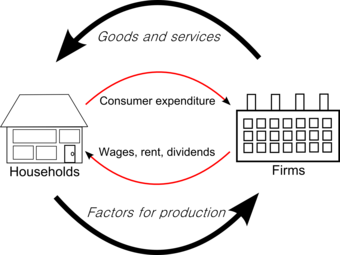
Circular Flow
The economy consists of interactions between firms and households.
Consider the market for CDs. Each individual consumer has a demand function for CDs that determines how many he will buy at a particular price – for example, one consumer may only buy a single album if they cost $15 each, but would buy two if the price dropped to $10 each. Likewise, each producer has a production function that determines how many CDs it will produce at a given price; it may produce 10,000 CDs if they can be sold for $10, but will increase production to 12,000 if the price rises to $15. In order to understand the entire market for CDs, economists add the demand of all consumers at each possible price, creating an aggregate demand curve, and the total quantity supplied by producers at each possible price, creating an aggregate supply curve. The point at which these two curves intersect shows the market equilibrium for CDs.
The Macroeconomy
Just as the choices made by individual consumers and producers can be aggregated to describe an entire industry, their combined effects can also influence a nation’s overall economic activity. Macroeconomists study a variety of these effects, but three are central to macroeconomic research:
- Gross domestic product (GDP) – the size of an entire economy’s output – is measured by adding together all the production undertaken by a nation’s firms. Individual firms affect GDP every time they choose to produce more or less. Consumers affect GDP whenever they increase or decrease demand for goods.
- Inflation occurs when many individual consumers increase demand for a good, raising the equilibrium price for the economy as a whole.
- Unemployment rises when firms choose to produce less or when consumers decrease their demand at a given price.
1.4: Basic Economic Questions
1.4.1: Production Outputs
A firm’s production outputs are what it creates using its resources: goods or services.
Learning Objective
Identify how suppliers determine what and how much to supply
Key Points
- The profit-maximizing amount of output occurs when the marginal cost of producing another unit equals the marginal revenue received from selling that unit.
- Output are the quantity of goods or services produced in a given time period, by a firm, industry or country.
- There are four types of market scenario that a firm may encounter when making a production decision: economic profit, normal profit, loss-minimizing condition, and shutdown. The firm should always produce unless it encounters a shutdown scenario.
Key Terms
- fixed costs
-
A cost of business which does not vary with output or sales; overheads.
- average total cost
-
Average cost or unit cost is equal to total cost divided by the number of goods produced (the output quantity, Q). It is also equal to the sum of average variable costs (total variable costs divided by Q) plus average fixed costs (total fixed costs divided by Q).
- variable cost
-
A cost that changes with the change in volume of activity of an organization.
- marginal cost
-
The increase in cost that accompanies a unit increase in output; the partial derivative of the cost function with respect to output. Additional cost associated with producing one more unit of output.
Production outputs are the goods and services created in a given time period, by a firm, industry or country. These goods can either be consumed or used for further production. Production outputs can be anything from crops to technological devices to accounting services. Producing these outputs incur costs which must be considered when determining how much of a good should be produced.
Determining what to produce and how much to produce can be difficult. Microeconomics assumes that firms and businesses are profit-seeking. This means that above all else they will produce goods and services to the degree that maximizes their profits. In economic theory, the profit-maximizing amount of output in occurs when the marginal cost of producing another unit equals the marginal revenue received from selling that unit . When the product’s marginal costs exceeds marginal revenue, the firm should stop production.

Production Conditions
A firm will seek to produce such that its marginal cost (MC) is equal to marginal revenue (MR, which is equal to the price and demand). It is not produced based on average total cost (ATC).
Once a firm has established what its profit-maximizing output is, the next step it must consider is whether to produce the good given the current market price. There are several key terms to be familiar with prior to addressing this question.
- Fixed costs are those expenses that remain constant regardless of the amount of good that is produced. For example, no matter how much of a good you produce, you will still have to pay the same amount of rent for your factory or storage units.
- Variable costs are only those expenses that are directly tied to the production of more units; fixed costs are not included.
- Opportunity costs are the cost of an opportunity forgone (and the loss of the benefits that could be received from that opportunity); the cost equals the most valuable forgone alternative.
- Average total cost is the all expenses incurred to produce the product, including fixed costs and opportunity costs, divided by the number of the units of the good produced.
There are four different types of conditions that generally describe a firm’s profit as described in :
- Economic Profit: The firm’s average total cost is less than the price of each additional product at the profit-maximizing output. The economic profit is equal to the quantity output multiplied by the difference between the average total cost and the price.
- Normal Profit: The average total cost equals the price at the profit-maximizing output. In this case, the economic profit equals zero. In this scenario, the firm should produce of the product.
- Loss-minimizing condition: The firm’s product price is between the average total cost and the average variable cost. The firm should still continue to produce because additional sales would offset a portion of fixed costs. If the manufacturer stopped production, it would sustain all the fixed costs as a loss.
- Shutdown: The price is below average variable cost at the profit-maximizing output. Production should be shutdown because every unit produced increases loss. The revenue gained from sales of these products do not offset variable and fixed costs. If it does not produce goods, the firm suffers a loss due to fixed costs, but it does not incur any variable costs.
1.4.2: Production Inputs and Process
Labor, capital, and land are the three necessary inputs for any production process.
Learning Objective
Explain the use of capital and labor in production
Key Points
- Capital, otherwise known as capital assets, are manufactured goods that are used in production of goods or services.
- Cash is not included in capital in terms of a production input. Homes and personal automobiles are also not included in capital because these items are not directly tied to the production of goods or services.
- Labor is a measure of the work done by human beings to create a manufactured output.
Key Terms
- labor
-
The workers used to manufacture the output.
- capital
-
Already-produced durable goods available for use as a factor of production, such as steam shovels (equipment) and office buildings (structures).
- input
-
Something fed into a process with the intention of it shaping or affecting the outputs of that process.
The process of production generates output, otherwise referred to as good and services. Production processes require three inputs: land, capital and labor. Land is simply the place where you produce your product, whether it is a factory or a farm, and may included capital if the output being created is a service. In most scenarios, the inputs in the production process are primarily capital and labor.
Capital
Capital, otherwise known as capital assets, are manufactured goods that are used in production of goods or services. Control of these assets are the primary means of creating wealth. Included in capital is anything that has been manufactured that can be used to enhance a person’s ability to perform economically useful work. For a caveman, a stick or a stone would have been considered capital. For a post-industrial worker, a laptop, computer, and cellphone would be considered capital .
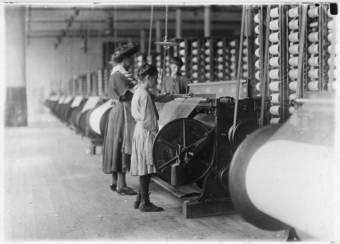
Girls running warping machines in Loray Mill, Gastonia, N.C. by Lewis Hine, 1908.
Any tool or machine that could be used to improve someone’s ability to work would be included in capital.
In regards to production, it also is important to know what capital is not. While capital may refer to funds invested in a business in other disciplines such as accounting, cash is not included in capital in terms of a production input in economics. Homes and personal automobiles are also not included in capital because these items are not directly tied to the production of goods or services.
Labor
Labor is a measure of the work done by human beings to create a manufactured output. Producers demand labor because it aids in producing output which can then be sold. In production, a worker will only be hired when the marginal revenue s/he brings in exceeds or equals the marginal cost of hiring that worker. The cost of one worker is the wage.
The value of labor varies based on the skills and talents that the individual worker brings to that job. If the job involves designing and building a computer, an engineer’s labor is more valuable than a tailor. If the job requires the manufacture of a suit, an employer would prefer the tailor. Other elements that influence the perception of the value of a specific type of labor in production include the amount of training necessary to execute the task and the barriers to conducting that type of work.
1.4.3: Production Recipients
The process of producing and distributing a good or service is called a supply chain, and it is composed of many economic actors.
Learning Objective
Identify the market actors involved in taking a product from the original producer to the consumer
Key Points
- Supply chains vary based on industry, the resources of the manufacturer, and market conditions.
- The purpose of a supply chain is to act as an integrating function that links major business functions and processes into a cohesive business model.
- Typical steps in a supply chain include: extraction of raw materials; acquisition of components; production; inventory; transportation; wholesaler; and retailer.
Key Term
- supply chain
-
A system of organizations, people, technology, activities, information and resources involved in moving a product or service from supplier to customer.
A supply chain is a system of organizations, people, activities, information and resources involved in moving a product or service from supplier to customer. The company’s supply chain illustrates the total process of transforming raw materials into a finished product, and then selling that finished product to consumers .
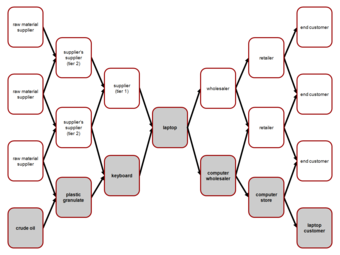
Supply Chain
This represents the typical supply chain for a computer. The right half of the chart represents the steps it takes from producing the final product to the consumers.
The purpose of a supply chain is to act as an integrating function that links major business functions and processes into a cohesive business model. When designed well, a supply chain is able to respond to shifts in demand and changes in the marketplace. Based on these shifts, the supply chain is able to alter production levels accordingly so that supply can meet demand so that the firm is able to maximize its profit.
Supply chains vary based on industry, the resources of the manufacturer, and market conditions. Some typical elements and actors in a supply chain include:
- Extraction/Acquisition of Raw Materials or Components. Before the production of a good can be initiated, you need to have all of the necessary elements. These elements could be unrefined raw materials that the company transforms into components or pre-assembled parts. A firm may have subsidiaries or divisions that obtain raw materials or it might acquire those elements from a third party.
- Production. This is the process that transforms the elements acquired from the prior step into the finished good. Economic actors involved in this step include product designers, assembly-line workers, and floor management.
- Inventory. Once the good is completed, it is generally placed into a centralized inventory location while decisions are made by inventory managers and a firm’s sales division.
- Transportation. Finished goods must be transported to stores and other locations where consumers can obtain the good. Depending on the type of business, goods may be transferred to smaller regional inventory depots, merchants, or directly to a consumer.
- Wholesaler. A wholesaler is someone who sells a good to smaller stores, who in turn sells the good to consumers.
- Retailer. The retailer buys the product in bulk and sells individual or smaller groups of units to the end consumer.
1.4.4: Differences Between Centrally Planned and Market Economies
The key difference between centrally planned and market economies is the degree of individual autonomy.
Learning Objective
Compare the characteristics of capitalist and socialist economic systems
Key Points
- A pure planned economy has one person or group who controls what is produced; all businesses work together to produce goods and services that are planned and distributed by the government.
- Planned economies have several advantages. Ideally, there is no unemployment, and needs never go unfulfilled; because the government knows how much food, medicine, and other goods is needed, it can produce enough for all.
- Realistically, these systems tend to suffer from large inefficiencies and are overall not as successful as other types of economic systems.
- A pure market economy is one perfectly free of external control. Individuals are left up to themselves to decide what to produce, who to work for, and how to get the things they need.
- Because there is no regulation ensuring equality and fairness, market economies are burdened with unemployment, and even those with jobs can never be certain that they will make enough to provide for all of their needs.
- Because they do not need to wait for word from the government before changing their output, companies under market economies can quickly keep up with fluctuations in the economy, tending to be more efficient than regulated markets.
Key Terms
- Centrally planned economy
-
When the government is responsible for setting the amount produced.
- autonomy
-
Self-government; freedom to act or function independently.
- market economy
-
An economy in which goods and services are exchanged in a free market, as opposed to a state-controlled or socialist economy; a capitalistic economy.
While there are many different variations of national economies, the two dominant economic coordination mechanisms are centrally planned and market based. Before you can analyze any national economy, you need to understand these two opposing viewpoints on how to run an economy. The key difference between the two is the amount of individual autonomy within the two systems.
Centrally Planned Economy
A pure planned economy has one person or group who controls what is produced; all businesses work together to produce goods and services that are planned and distributed by the government. These economies are also called command economies because everyone must follow specific guidelines set up by the controlling authority. The reason behind this type of planning is to make sure that everything needed is produced and that everyone’s needs are fulfilled. Since most peoples’ needs are provided for in a centrally planned economy, compensation is primarily morally based. Most assets are owned by the state.
Planned economies have several advantages. Ideally, there is no unemployment and needs never go unfulfilled. Because the government knows how much food, medicine, and other goods is needed, it can produce enough for all. But achieving these outcomes depends on the group that organizes production and distribution to accurately identify what the consumers will need, determine what it would take to meet those goals, and anticipate all possible situations. This means there are a lot of opportunities to make a mistake. Realistically, these systems tend to suffer from large inefficiencies and are overall not as successful as other types of economic systems.

V.I. Lenin
The Soviet Union, as established by V.I. Lenin, is an example of a country that tried to establish a pure centrally planned economy.
Market Based Economy
A pure market economy, or capitalist system, is one perfectly free from external control. Individuals may decide what to produce, who to work for, and how to get the things they need. They are compensated with material goods for their work, and most assets are privately owned. This type of economy, though it may be chaotic at times, allows people to change along with the shifting market conditions to maximize their profits. Although they avoid many of the inadequacies of planned economies, market economies are not free of their own problems and downfalls. Perhaps the greatest problem is that business firms may refuse to produce goods that unprofitable for them. For instance, in 2000 there was a shortage of tetanus vaccine in the United States. Because it was expensive to make, most companies were unwilling to start production themselves, leaving only one firm struggling to keep up with demand. In a planned economy, this shortage would not happen because the government would boost production of the vaccine if it were needed.
Because there is no regulation to ensure equality and fairness, market economies may be burdened with unemployment and even those with jobs can never be certain that they will make enough to provide for all of their needs. Despite these and other problems, market economies come with many advantages, chief among which is speed. Because they do not need to wait for word from the government before changing their output, companies under market economies can quickly keep up with fluctuations in the economy, tending to be more efficient than regulated markets. Also, individuals have more freedom and opportunities to do the jobs they want and to profit by them.
1.4.5: Mixed Economies
A mixed economy is a system that embraces elements of centrally planned and free market systems.
Learning Objective
Explain the characteristics of a mixed economy
Key Points
- Most of the means of production in a mixed economy are privately owned in a mixed economy.
- The government strongly influences the economy through direct intervention in a mixed economy, such as through subsidies and regulation of the markets.
- Most government intervention in mixed economy is limited to minimizing the negative consequences of economic events, such as unemployment in recessions, to promote social welfare.
Key Terms
- mixed economy
-
A system in which both the state and private sector direct the economy, reflecting characteristics of both market economies and planned economies.
- monopoly
-
A market where one company is the sole supplier.
A mixed economy is a system that embraces elements of centrally planned and free market systems. While there is no single definition of a mixed economy, it generally involves a degree of economic freedom mixed with government regulation of markets. Most modern economies are mixed, including the United States and Cuba. Countries hope that by embracing elements of both systems they can gain the benefits of both while minimizing the systems disadvantages.
In general, most of the means of production in a mixed economy are privately owned. There are some exceptions to this general rule, such as some hospitals and businesses. The mostly private ownership of all means of production allows the market to quickly respond to changing circumstances and economic factors. As a result, the market is generally the dominant form of economic coordination. However, to mitigate the negative influence that a pure market economy has on fairness and distribution, the government strongly influences the economy through direct intervention in a mixed economy. Different ways a government directly intervenes in an economy include:
- granting a business a monopoly,
- granting a subsidy to a sector,
- creating and enforcing regulation,
- direct participation in the market , or
- providing money and other resources segments of its populations, such as through a welfare program.
Most government intervention in mixed economy is limited to minimizing the negative consequences of economic events, such as unemployment in recessions, to promote social welfare.
While mixed economies vary based on their degree of government intervention, some elements are consistent. Generally, individuals in mixed economies are able to:
- participate in managerial decisions,
- travel,
- buy and sell items privately,
- hire and fire employees,
- organize organizations,
- communicate, and
- protest peacefully.
However, the government in mixed economies generally subsidizes public goods, such as roads and libraries, and provide welfare services such as social security. These governments also regulate labor and protect intellectual property.
1.5: Economic Models
1.5.1: Math Review
Mathematical economics uses mathematical methods, such as algebra and calculus, to represent theories and analyze problems in economics.
Learning Objective
Review basic algebra and calculus’ concepts relevant in introductory economics
Key Points
- Using mathematics allows economists to form meaningful, testable propositions about complex subjects that would be hard to express informally.
- Algebra is the study of operations and their application to solving equations. It provides structure and a definite direction for economists when they are analyzing complex data.
- Concepts in algebra that are used in economics include variables and algebraic expressions.
- Calculus is the mathematical study of change. Economists use calculus in order to study economic change whether it involves the world or human behavior.
- In economics, calculus is used to study and record complex information – commonly on graphs and curves.
Key Terms
- variable
-
something whose value may be dictated or discovered.
- quantitative
-
Of a measurement based on some number rather than on some quality.
As a social science, economics analyzes the production, distribution, and consumption of goods and services. The study of economics requires the use of mathematics in order to analyze and synthesize complex information.
Mathematical Economics
Mathematical economics is the application of mathematical methods to represent theories and analyze problems in economics. Using mathematics allows economists to form meaningful, testable propositions about complex subjects that would be hard to express informally. Math enables economists to make specific and positive claims that are supported through formulas, models, and graphs. Mathematical disciplines, such as algebra and calculus, allow economists to study complex information and clarify assumptions.
Algebra
Algebra is the study of operations and their application to solving equations. It provides structure and a definite direction for economists when they are analyzing complex data. Math deals with specified numbers, while algebra introduces quantities without fixed numbers (known as variables). Using variables to denote quantities allows general relationships between quantities to be expressed concisely. Quantitative results in science, economics included, are expressed using algebraic equations.
Concepts in algebra that are used in economics include variables and algebraic expressions. Variables are letters that represent general, non-specified numbers. Variables are useful because they can represent numbers whose values are not yet known, they allow for the description of general problems without giving quantities, they allow for the description of relationships between quantities that may vary, and they allow for the description of mathematical properties. Algebraic expressions can be simplified using basic math operations including addition, subtraction, multiplication, division, and exponentiation.
In economics, theories need the flexibility to formulate and use general structures. By using algebra, economists are able to develop theories and structures that can be used with different scenarios regardless of specific quantities.
Calculus
Calculus is the mathematical study of change. Economists use calculus in order to study economic change whether it involves the world or human behavior.
Calculus has two main branches:
- Differential calculus is the study of the definition, properties, and applications of the derivative of a function (rates of change and slopes of curves) . By finding the derivative of a function, you can find the rate of change of the original function.
- Integral calculus is the study of the definitions, properties, and applications of two related concepts, the indefinite and definite integral (accumulation of quantities and the areas under curves) .
Calculus is widely used in economics and has the ability to solve many problems that algebra cannot. In economics, calculus is used to study and record complex information – commonly on graphs and curves. Calculus allows for the determination of a maximal profit by providing an easy way to calculate marginal cost and marginal revenue. It can also be used to study supply and demand curves.
Common Mathematical Terms
Economics utilizes a number of mathematical concepts on a regular basis such as:
- Dependent Variable: The output or the effect variable. Typically represented as
, the dependent variable is graphed on the
-axis. It is the variable whose change you are interested in seeing when you change other variables. - Independent or Explanatory Variable: The inputs or causes. Typically represented as , ,
, etc., the independent variables are graphed on the
-axis. These are the variables that are changed in order to see how they affect the dependent variable. - Slope: The direction and steepness of the line on a graph. It is calculated by dividing the amount the line increases on the
-axis (vertically) by the amount it changes on the
-axis (horizontally). A positive slope means the line is going up toward the right on a graph, and a negative slope means the line is going down toward the right. A horizontal line has a slope of zero, while a vertical line has an undefined slope. The slope is important because it represents a rate of change. - Tangent: The single point at which two curves touch. The derivative of a curve, for example, gives the equation of a line tangent to the curve at a given point.
1.5.2: Assumptions
Economists use assumptions in order to simplify economics processes so that they are easier to understand.
Learning Objective
Assess the benefits and drawbacks of using simplifying assumptions in economics
Key Points
- Neo-classical economics employs three basic assumptions: people have rational preferences among outcomes that can be identified and associated with a value, individuals maximize utility and firms maximize profit, and people act independently on the basis of full and relevant information.
- An assumption allows an economist to break down a complex process in order to develop a theory and realm of understanding. Later, the theory can be applied to more complex scenarios for additional study.
- Critics have stated that assumptions cause economists to rely on unrealistic, unverifiable, and highly simplified information that in some cases simplifies the proofs of desired conclusions.
- Although simplifying can lead to a better understanding of complex phenomena, critics explain that the simplified, unrealistic assumptions cannot be applied to complex, real world situations.
Key Terms
- simplify
-
To make simpler, either by reducing in complexity, reducing to component parts, or making easier to understand.
- assumption
-
The act of taking for granted, or supposing a thing without proof; a supposition; an unwarrantable claim.
As a field, economics deals with complex processes and studies substantial amounts of information. Economists use assumptions in order to simplify economic processes so that it is easier to understand. Simplifying assumptions are used to gain a better understanding about economic issues with regards to the world and human behavior .

Simple indifference curve
An indifference curve is used to show potential demand patterns. It is an example of a graph that works with simplifying assumptions to gain a better understanding of the world and human behavior in relation to economics.
Economic Assumptions
Neo-classical economics works with three basic assumptions:
- People have rational preferences among outcomes that can be identified and associated with a value.
- Individuals maximize utility (as consumers) and firms maximize profit (as producers).
- People act independently on the basis of full and relevant information.
Benefits of Economic Assumptions
Assumptions provide a way for economists to simplify economic processes and make them easier to study and understand. An assumption allows an economist to break down a complex process in order to develop a theory and realm of understanding. Good simplification will allow the economists to focus only on the most relevant variables. Later, the theory can be applied to more complex scenarios for additional study.
For example, economists assume that individuals are rational and maximize their utilities. This simplifying assumption allows economists to build a structure to understand how people make choices and use resources. In reality, all people act differently. However, using the assumption that all people are rational enables economists study how people make choices.
Criticisms of Economic Assumptions
Although, simplifying assumptions help economists study complex scenarios and events, there are criticisms to using them. Critics have stated that assumptions cause economists to rely on unrealistic, unverifiable, and highly simplified information that in some cases simplifies the proofs of desired conclusions. Examples of such assumptions include perfect information, profit maximization, and rational choices. Economists use the simplified assumptions to understand complex events, but criticism increases when they base theories off the assumptions because assumptions do not always hold true. Although simplifying can lead to a better understanding of complex phenomena, critics explain that the simplified, unrealistic assumptions cannot be applied to complex, real world situations.
1.5.3: Hypotheses and Tests
Economics, as a science, follows the scientific method in order to study data, observe patterns, and predict results of stimuli.
Learning Objective
Apply the steps of the scientific method to economic questions
Key Points
- The scientific method involves identifying a problem, gathering data, forming a hypothesis, testing the hypothesis, and analyzing the results.
- A hypothesis is simply a prediction.
- In economics, extensive testing and observation is required because the outcome must be obtained more than once in order to be valid.
- Cause and effect relationships are used to establish economic theories and principles. Over time, if a theory or principle becomes accepted as universally true, it becomes a law. In general, a law is always considered to be true.
- The scientific method provides the framework necessary for the progression of economic study.
Key Term
- hypothesis
-
An assumption taken to be true for the purpose of argument or investigation.
Economics, as a science, follows the scientific method in order to study data, observe patterns, and predict results of stimuli.
There are specific steps that must be followed when using the scientific method . Economics follows these steps in order to study data and build principles:

Scientific Method
The scientific method is used in economics to study data, observe patterns, and predict results.
- Identify the problem – in the case of economics, this first step of the scientific method involves determining the focus or intent of the work. What is the economist studying? What is he trying to prove or show through his work?
- Gather data – economics involves extensive amounts of data. For this reason, it is important that economists can break down and study complex information. The second step of the scientific method involves selecting the data that will be used in the study.
- Hypothesis – the third step of the scientific method involves creating a model that will be used to make sense of all of the data. A hypothesis is simply a prediction. What does the economist think the overall outcome of the study will be?
- Test hypothesis – the fourth step of the scientific method involves testing the hypothesis to determine if it is true. This is a critical stage within the scientific method. The observations must be tested to make sure they are unbiased and reproducible. In economics, extensive testing and observation is required because the outcome must be obtained more than once in order for it to be valid. It is not unusual for testing to take some time and for economists to make adjustments throughout the testing process.
- Analyze the results – the final step of the scientific method is to analyze the results. First, an economist will ask himself if the data agrees with the hypothesis. If the answer is “yes,” then the hypothesis was accurate. If the answer is “no,” then the economist must go back to the original hypothesis and adjust the study accordingly. A negative result does not mean that the study is over. It simply means that more work and analysis is required.
Observation of data is critical for economists because they take the results and interpret them in a meaningful way. Cause and effect relationships are used to establish economic theories and principles. Over time, if a theory or principle becomes accepted as universally true, it becomes a law. In general, a law is always considered to be true. The scientific method provides the framework necessary for the progression of economic study. All economic theories, principles, and laws are generalizations or abstractions. Through the use of the scientific method, economists are able to break down complex economic scenarios in order to gain a deeper understanding of critical data.
1.5.4: Economic Models
A model is simply a framework that is designed to show complex economic processes.
Learning Objective
Recognize the uses and limitations of economic models
Key Points
- Many models use mathematical techniques in order to investigate, theorize, and fit theories into economic situations.
- Economic models have two functions: 1) to simplify and abstract from observed data, and 2) to serve as a means of selection of data based on a paradigm of econometric study.
- Creating a model has two basic steps: 1) generate the model, and 2) checking the model for accuracy – also known as diagnostics.
- Examples of the uses of economic models include: professional academic interest, forecasting economic activity, proposing economic policy, presenting reasoned arguments to politically justify economic policy, as well as economic planning and allocation.
Key Terms
- deductive
-
Based on inferences from general principles.
- diagnostics
-
The process of determining the state of or capability of a component to perform its function(s).
- qualitative
-
Based on descriptions or distinctions rather than on some quantity.
Economic Models
In economics, a model is defined as a theoretical construct that represents economic processes through a set of variables and a set of logical or quantitative relationships between the two. A model is simply a framework that is designed to show complex economic processes. Most models use mathematical techniques in order to investigate, theorize, and fit theories into economic situations.
Uses of an Economic Model
Economists use models in order to study and portray situations. The focus of a model is to gain a better understanding of how things work, to observe patterns, and to predict the results of stimuli . Models are based on theory and follow the rules of deductive logic.

Economic model diagram
In economics, models are used in order to study and portray situations and gain a better understand of how things work.
Economic models have two functions: 1) to simplify and abstract from observed data, and 2) to serve as a means of selection of data based on a paradigm of econometric study. Economic processes are known to be enormously complex, so simplification to gain a clearer understanding is critical. Selecting the correct data is also very important because the nature of the model will determine what economic facts are studied and how they will be compiled.
Examples of the uses of economic models include: professional academic interest, forecasting economic activity, proposing economic policy, presenting reasoned arguments to politically justify economic policy, as well as economic planning and allocation.
Constructing a Model
The construction and use of a model will vary according to the specific situation. However, creating a model does have two basic steps: 1) generate the model, and 2) checking the model for accuracy – also known as diagnostics. The diagnostic step is important because a model is only useful if the data and analysis is accurate.
Limitations of a Model
Due to the complexity of economic models, there are obviously limitations that come into account. First, all of the data provided must be complete and accurate in order for the analysis to be successful. Also, once the data is entered, it must be analyzed correctly. In most cases, economic models use mathematical or quantitative analysis. Within this realm of observation, accuracy is very important. During the construction of a model, the information will be checked and updated as needed to ensure accuracy. Some economic models also use qualitative analysis. However, this kind of analysis is known for lacking precision. Furthermore, models are fundamentally only as good as their founding assumptions.
The use of economic models is important in order to further study and understand economic processes. Steps must be taken throughout the construction of the model to ensure that the data provided and analyzed is correct.
1.5.5: Normative and Positive Economics
Positive economics is defined as the “what is” of economics, while normative economics focuses on the “what ought to be”.
Learning Objective
Contrast normative and positive statements about economic policy
Key Points
- Positive economics is a branch of economics that focuses on the description and explanation of phenomena, as well as their casual relationships.
- Positive economics clearly states an economic issue and normative economics provides the value-based solution for the issue.
- Normative economics is a branch of economics that expresses value or normative judgments about economic fairness. It focuses on what the outcome of the economy or goals of public policy should be.
- Positive economics does impact normative economics because it ranks economic polices or outcomes based on acceptability (normative economics).
Key Terms
- normative economics
-
Economic thought in which one applies moral beliefs, or judgment, claiming that an outcome is “good” or “bad”.
- positive economics
-
The description and explanation of economic phenomena and their causal relationships.
Positive and normative economic thought are two specific branches of economic reasoning. Although they are associated with one another, positive and normative economic thought have different focuses when analyzing economic scenarios.
Positive Economics
Positive economics is a branch of economics that focuses on the description and explanation of phenomena, as well as their casual relationships. It focuses primarily on facts and cause-and-effect behavioral relationships, including developing and testing economic theories. As a science, positive economics focuses on analyzing economic behavior. It avoids economic value judgments. For example, positive economic theory would describe how money supply growth impacts inflation, but it does not provide any guidance on what policy should be followed. “The unemployment rate in France is higher than that in the United States” is a positive economic statement. It gives an overview of an economic situation without providing any guidance for necessary actions to address the issue.
Normative Economics
Normative economics is a branch of economics that expresses value or normative judgments about economic fairness. It focuses on what the outcome of the economy or goals of public policy should be. Many normative judgments are conditional. They are given up if facts or knowledge of facts change. In this instance, a change in values is seen as being purely scientific. Welfare economist Amartya Sen explained that basic (normative) judgments rely on knowledge of facts.
An example of a normative economic statement is “The price of milk should be $6 a gallon to give dairy farmers a higher living standard and to save the family farm. ” It is a normative statement because it reflects value judgments. It states facts, but also explains what should be done. Normative economics has subfields that provide further scientific study including social choice theory, cooperative game theory, and mechanism design.
Relationship Between Positive and Normative Economics
Positive economics does impact normative economics because it ranks economic policies or outcomes based on acceptability (normative economics). Positive economics is defined as the “what is” of economics, while normative economics focuses on the “what ought to be. ” Positive economics is utilized as a practical tool for achieving normative objectives. In other words, positive economics clearly states an economic issue and normative economics provides the value-based solution for the issue .
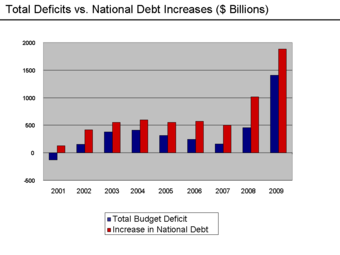
Debt Increases
This graph shows the debt increases in the United States from 2001-2009. Positive economics would provide a statement saying that the debt has increased. Normative economics would state what needs to be done in order to work towards resolving the issue of increasing debt.
1.6: Differences Between Macroeconomics and Microeconomics
1.6.1: Macroeconomics
Macroeconomics is the study of the performance, structure, behavior and decision-making of an economy as a whole.
Learning Objective
Define macroeconomics and identify the main users of macroeconomics
Key Points
- For most macroeconomists, the purpose of this discipline is to maximize national income and provide national economic growth.
- The most common macroeconomic topics of study for national entities are sustainability, full employment, price stability, external balance, equitable distribution of income and wealth, and increasing productivity.
- Macroeconomists hope that their models help address two key areas of research: the causes and consequences of short-run fluctuations in national income (otherwise known as the business cycle) and what determines long-run economic growth.
Key Terms
- Macroeconomics
-
The study of the performance, structure, behavior, and decision-making of an economy as a whole, rather than individual markets.
- deflation
-
A decrease in the general price level, that is, in the nominal cost of goods and services.
- inflation
-
An increase in the general level of prices or in the cost of living.
Macroeconomics is the study of the performance, structure, behavior and decision-making of an economy as a whole . Macroeconomists focus on the national, regional, and global scales. For most macroeconomists, the purpose of this discipline is to maximize national income and provide national economic growth. Economists hope that this growth translates to increased utility and an improved standard of living for the economy’s participants. While there are variations between the objectives of different national and international entities, most follow the ones detailed below:

Circulation in Macroeconomics
Macroeconomics studies the performance of national or global economies and the interaction of certain entities at the these level.
- Sustainability occurs when an economy achieves a rate of growth which allows an increase in living standards without undue structural and environmental difficulties.
- Full employment occurs when those who are able and willing to have a job can get one. Most economists believe that there will always be a certain amount of frictional, seasonal and structural unemployment (referred to as the natural rate of unemployment). As a result, full employment does not mean zero unemployment.
- Price stability occurs when prices remain largely stable and there is not rapid inflation or deflation. Price stability is not necessarily zero inflation; steady levels of low-to-moderate inflation is often regarded as ideal.
- External balance occurs when exports roughly equal imports over the long run.
- Equitable distribution of income and wealth among the economy’s participants. This does not, however, mean that income and wealth are the same for everyone.
- Increasing Productivity over time throughout the national economy.
To achieve these goals, macroeconomists develop models that explain the relationship between factors such as national income, output, consumption, unemployment, inflation, savings, investment and international trade. These models rely on aggregated economic indicators such as GDP, unemployment, and price indices.
On the national level, macroeconomists hope that their models help address two key areas of research:
- the causes and consequences of short-run fluctuations in national income, otherwise known as the business cycle, and
- what determines long-run economic growth.
1.6.2: Microeconomics
Microeconomics deals with the economic interactions of a specific person, a single entity or a company; it is the study of markets.
Learning Objective
Define Microeconomics, Identify the main users of microeconomics
Key Points
- One of the major goals of microeconomics is to analyze the market and determine the price for goods and services that best allocates limited resources among the different alternative uses.
- Microeconomics assumes businesses are rational and produce goods that maximize their profit.
- The science of microeconomics covers a variety of specialized areas of study including: industrial organization, labor economics, financial economics, public economics, political economy, health economics, urban economics, law and economics, and economic history.
Key Terms
- microeconomics
-
That field that deals with the small-scale activities such as that of the individual or company.
- Scarcity
-
an inadequate amount of something; a shortage
Microeconomics deals with the economic interactions of a specific person, a single entity, or a company. These interactions, which mainly are buying and selling goods, occur in markets. Therefore, microeconomics is the study of markets. The two key elements of this economic science are the interaction between supply and demand and scarcity of goods .

Supply and Demand Graph
Microeconomics is based on the study of supply and demand at the personal and corporate level.
One of the major goals of microeconomics is to analyze the market and determine the price for goods and services that best allocates limited resources among the different alternative uses. This study is especially important for producers as they decide what to manufacture and the appropriate selling price. Microeconomics assumes businesses are rational and produce goods that maximizes their profit. If each firm takes the most profitable path, the principles of microeconomics state that the market’s limited resources will be allocated efficiently.
The science of microeconomics covers a variety of specialized areas of study including:
- Industrial Organization: the entry and exit of firms, innovation, and the role of trademarks.
- Labor Economics: wages, employment, and labor market dynamics.
- Financial Economics: topics such as optimal portfolios, the rate of return to capital, and corporate financial behavior.
- Public Economics:the design of government tax and expenditure policies.
- Political Economics: the role of political institutions in policy.
- Health Economics: the organization of health care system.
- Urban Economics: challenges faced by cities, such as sprawl, traffic congestion, and poverty.
- Law and Economics: applies economic principles to the selection and enforcement of legal regimes.
- Economic History: the history and evolution of the economy.
1.6.3: Key Differences
Microeconomics focuses on individual markets, while macroeconomics focuses on whole economies.
Learning Objective
Recognize questions addressed by microeconomics and macroeconomics
Key Points
- Microeconomics and macroeconomics both focus on the allocation of scarce resources. Both disciplines study how the demand for certain resources interacts with the ability to supply that good to determine how to best distribute and allocate that resource among many consumers.
- Microeconomics studies the behavior of individual households and firms in making decisions on the allocation of limited resources. Another way to phrase this is to say that microeconomics is the study of markets.
- Macroeconomics is generally focused on countrywide or global economics. It studies involves the sum total of economic activity, dealing with the issues such as growth, inflation, and unemployment.
- There are some economic events that are of great interest to both microeconomists and macroeconomists, but they will differ in how and why they analyze the events.
Key Terms
- Macroeconomics
-
The study of the performance, structure, behavior, and decision-making of an economy as a whole, rather than individual markets.
- microeconomics
-
The study of the behavior of individual households and firms in making decisions on the allocation of limited resources.
- inflation
-
An increase in the general level of prices or in the cost of living.
Stemming from Adam Smith’s seminal book, The Wealth of Nations, microeconomic and macroeconomics both focus on the allocation of scarce resources . Both disciplines study how the demand for certain resources interacts with the ability to supply that good to determine how to best distribute and allocate that resource among many consumers. Both disciplines are about maximization: microeconomics is about maximizing profit for firms, and surplus for consumers and producers, while macroeconomics is about maximizing national income and growth.

Adam Smith, Founding Father of Economics
Adam Smith’s book, Wealth of Nations, was the basis of both microeconomic and macroeconomic study.
The main difference between microeconomics and macroeconomics is scale. Microeconomics studies the behavior of individual households and firms in making decisions on the allocation of limited resources. Another way to phrase this is to say that microeconomics is the study of markets.
In contrast macroeconomics involves the sum total of economic activity, dealing with the issues such as growth, inflation, and unemployment. Macroeconomics is the study of economies on the national, regional or global scale.
This key difference alters how the two approach economic situations. Microeconomics does consider how macroeconomic forces impact the world, but it focuses on how those forces impact individual firms and industries. While macroeconomists study the economy as a whole, microeconomists are concerned with specific firms or industries.
Many economic events that are of great interest to both microeconomist and macroeconomists, though they differ in how they analyze those events. A shift in tax policy would interest economists in both disciplines. A microeconomist might focus on how the tax might shift supply in a specific market or influence a firm’s decision making, while the macroeconomist will consider whether the tax will translate into an improved standard of living for all of the economy’s participants.
Chapter 13: Informative Speaking
13.1: Introduction to Informative Speaking
13.1.1: Defining an Informative Speech
An informative speech is one that one that intends to educate the audience on a particular topic.
Learning Objective
Define an informative speech
Key Points
- This type of speech uses descriptions, demonstrations, vivid detail, and definitions to explain a subject, person, or place the audience wants to understand.
- An informative speech makes a complex topic easy to understand or offers a different point of view.
- Unlike persuasive speeches, an informative speech relies less on pathos and more on communicating information.
Key Terms
- definition
-
A statement expressing the essential nature of something; formulation.
- informative
-
Providing knowledge, especially useful or interesting information.
An informative speech is one that intends to educate the audience on a particular topic. There are many different types of informative speeches, including speeches that describe the conditions of a subject and speeches that instruct the audience on how to perform an action.

Purpose of the Speech
An informative speech is one that aims to inform the audience about a given topic.
The main goal of an informative speech is to provide enlightenment regarding a specific topic the audience knows nothing about. It may demonstrate how to use a new type of software, explain a new concept in the field of science, describe an expedition an archaeologist took, or provide details about a person of interest that the audience wants to learn more about.
The topics covered in an informative speech should help the audience to understand a subject better and to remember what they learned later. The goal of this type of speech isn’t to sway the audience to the speaker’s point of view. Instead, the details need to be laid before the audience so that they can make an educated decision or learn about a subject they are interested in.

Transferring Information
In an informative speech, how the information is presented will determine how the audience receives it.
However, it is important for the speaker to think about how this information will be presented. An informative speech should rely less on pathos, which is an appeal to the emotions of the audience and an important component of persuasive speeches. Instead, an informative speech might rely on visual aids, for example, in order to give the audience a visual representation of important information contained in the speech. Providing the information in multiple forms during the speech increases the likelihood that the audience will retain the information included in the speech.
13.1.2: Types of Informative Speeches
The four types of informative speeches are definition, explanatory, descriptive, and demonstrative.
Learning Objective
List the four types of informative speeches and describe their use
Key Points
- A descriptive speech helps the speaker create an accurate mental picture in the mind of the audience regarding a specific person, place, or thing.
- A demonstrative speech describes how to perform an action.
- An explanatory speech explains the state of a topic.
- A definition speech explains a concept or theory regarding a topic.
Key Terms
- description
-
A sketch or account of anything in words; a portraiture or representation in language; an enumeration of the essential qualities of a thing or species.
- definition
-
A statement expressing the essential nature of something; formulation.
An informative speech is one that informs the audience. However, as should be clear, this general definition demonstrates that there are many ways to inform an audience. Therefore, there are several types of informative speeches. The main types of informative speeches include definition, descriptive, explanatory, and demonstrative.
A definition speech explains the meaning, theory, or philosophy of a specific topic that the audience likely does not know much about. The topics may be general, such as a sport, or highly specific, like a particular person. The main goal of this speech is to educate the audience so that they understand the main points regarding this subject.
A demonstration speech explains how to do something. If you have ever sat through a lecture where a teacher explained how to create a bibliography, then you have heard a demonstration speech. Like most informative speeches, a how-to speech will likely use visual examples that show the audience how to move from step to step through a particular activity. Visualizations help the audience retain what each step looks like, increasing the likelihood that they will retain the overall information of the speech.

Demonstrative Speech
A demonstrative speech creates a mental image in audience members’ minds.
An explanatory speech might give a description of the state of a given topic. As an example, consider the types of speeches that are given at industry conferences. The goal of these speeches is for the speaker to inform the audience on a particular part of an industry. Commonly, these will also utilize visualizations that give the audience a visual representation of the particular data or statistics contained in the speech. This is one way to condense highly complex information into an easily retainable package for the audience.
A descriptive speech creates a vivid picture in a person’s mind regarding an object, person, animal, or place. An archaeologist who has discovered a new temple in South America or a paleontologist who believes they have found a new dinosaur may use a descriptive speech to inform an interested audience about their recent discoveries .
As all of these types make clear, there are many ways that a given set of information can be communicated in a speech. When deciding what type of informative speech you want to write and deliver, consider what you want the audience to know about your topic.
13.1.3: Subjects of Informative Speeches
Informative speeches can cover many subjects as long as they can be discussed without persuading or altering the perceptions of the audience.
Learning Objective
Name some examples of subjects of an informative speech
Key Points
- When choosing a subject of an informative speech consider whether you want to describe, explain, demonstrate or educate the audience about the topic.
- The subject of an informative speech should be one that can be communicated clearly to an audience.
- When choosing a subject for an informative speech, consider what is the essential information that an audience should know about that subject.
Key Term
- subject
-
A particular area of study.
There are many different subjects that can be used in informative speeches. College lectures about an event in history or a historical figure would be considered informative speeches
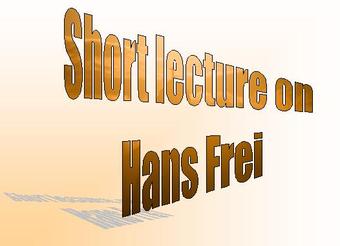
Lecture
A lecture is one type of informative speech. It’s usually about an important event or figure in history.
Other examples of subjects for an informative speech include an actor or actress, the field of advertising, a classic film the history of Dracula, social networking websites, and what causes volcanoes.
Each of these examples lends itself to multiple types of information. For example, an informative speech about a particular actor or actress would likely focus on providing a description of who the person is and what movies or plays they have been in. Incorporating famous pictures or clips from works is a way of increasing the audience’s retention of the information about the particular person.
An informative speech about the causes of a volcano could be considered a how-it-happens speech, which could be similar to a how-to speech. A speech about volcanoes might include a model volcano, describing how the model’s functioning is similar to processes in the real world.
More technical subjects, such as the field of advertising, require more technical information and specific data relevant to the industry. Technical subjects especially, but really all informative speeches, benefit from the use of visualizations, such as bar graphs or images. The choice of visual aids depends on what information the speaker wants to inform the audience of. For example, a speech that intends to explore the financial trends of political advertising over ten years would benefit from a bar graph. However, a speech that is informing the audience on how political advertisements have functionally changed over time would benefit from actual examples of ad campaigns.
In order to differentiate an informative speech from other types of speeches, it is important to stick to the basic facts of the subject. No personal biases, unsubstantiated information, or popular opinion should be included when stating the main ideas of the topic. The goal is to educate the audience on the facts, not to provide the speaker’s opinion. When crafting an informative speech look at the subject carefully and eliminate any potential statements that have prejudice or might persuade the audience.
13.2: Effective Informative Speaking
13.2.1: The Goals of an Informative Speech
An effective informative speech should be driven by a series of goals.
Learning Objective
List the goals of an informative speech
Key Points
- One of the goals of an informative speech is to enhance the understanding of the audience.
- Another goal of an informative speech is to maintain the interest of the audience.
- A final goal of an informative speech is for the audience to remember the speech.
Key Terms
- goal
-
A result that one is attempting to achieve.
- inform
-
To communicate knowledge to others.
An effective informative speech requires the speaker to aim for a series of goals. And similar to a soccer match, hitting these goals increases the likelihood of a successful speech. The main goals for an informative speech are to help explain a specific subject and to help the audience remember the knowledge later.
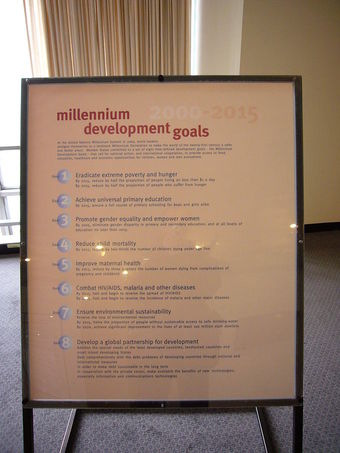
Setting Goals
You need to determine a series of goals in order to create a successful informative speech.
One of the goals, perhaps the most essential goal that drives all informative speeches, is for the speaker to inform the audience about a particular topic. In order to aim for this specific goal, a speaker should consider how best to package the complex understanding that they have cultivated of the topic, from personal experience and research, into an easily communicable form for the audience.
A final, significant goal an effective informative speech is to make the audience remember. Most memorable speeches have emotional appeals that audiences continue to talk about long after the speech is delivered, and sometimes even after the life of the speaker. To make sure that the information contained in a speech is remembered by the audience, the deliverer of an informative speech should combine organization, repetition and focused visualizations to increase the effectiveness of the speech and the likelihood that the audience will leave informed.
One way to help an audience remember the details of an informative speech is to maintain the interest of the audience. The challenge of an informative speech is delivering information in a neutral way that does not bore the audience. Unlike persuasive speeches, which rely heavily on emotional appeal, informative speeches have to demonstrate why the audience should care about the information contained in the speech without compromising a neutral tone.
13.2.2: Scoping Your Speech
Make sure that only the most relevant information is including in the speech, so the scope of your speech does not become too wide.
Learning Objective
Explain how to effectively scope an informative speech
Key Points
- Every piece of information in a speech should relate to the speech topic, purpose, and thesis simultaneously.
- Audiences have a hard time following or understanding speeches that are too broad in scope (that is, speeches that include too much irrelevant or tangential information).
- By keeping all of the information relevant as he or she develops your speech, the speaker’s job becomes easier by keeping all supporting information on point.
Key Term
- scope
-
The extent of the area or subject matter that something deals with or to which it is relevant.
Some speeches contain such a wide range of information that the audience is left wondering what the speaker was trying to communicate. A speech with a scope that is too broad complicates the audience’s ability to retain information. Properly scoping your speech allows the speaker to narrow down what the speech will cover, thus increasing its ability to inform the audience.
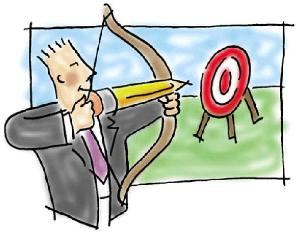
Scope Out a Specific Target
Every piece of information in a speech should be relevant to the topic, purpose and thesis. If it’s only a tangent, it doesn’t belong in the speech.
Scope refers to the extent of the area or subject matter that something deals with or to which it is relevant. The key word here is relevance; the speech should not go in so many different directions that none of those directions relate to the original purpose and thesis of the speech.
One way to effectively scope a speech is to think of the question: “What information do I want my audience to know at the end of the speech? ” Use the answer to this question as a focal point for everything else to be included in your speech. Everything included then must be relevant to your purpose and thesis. Anything superfluous or extraneous is only going to broaden the scope and take the speech away from that ultimate goal.
The evidence and supporting arguments should not only be related tangentially; there should be direct lines of relevance to every piece of information included in your speech.
Scoping a speech is not only helpful for the audience, but is also to the benefit of the speaker. Keeping the speech on point and focused makes it easier for the speaker to build more credible, reinforced arguments. By narrowing the scope of the speech, the speaker improve the speech’s ability to effectively communicate essential information to the audience.
13.2.3: Tailor Complexity to Your Audience
An important component of effective informative speaking is knowing how to tailor the complexity of the speech to the audience.
Learning Objective
Apply knowledge of your audience when composing your speech
Key Points
- Consider the audience that will be hearing your speech.
- Tailoring the complexity of the speech to your audience means considering how best they receive information.
- Considering how much information your audience already knows should help you tailor the complexity of your speech.
Key Term
- complexity
-
The state of being complex; intricacy; entanglement.
Overview
The main goals for an informative speech are to help explain a specific subject and to help the audience remember the knowledge later. To achieve these goals, a speaker should consider how best to package the complex understanding that they have cultivated of the topic, from personal experience and research, into an easily communicable form for the audience.
Complexity
One way to deliver an effective informative speech and ensure that the audience leaves your speech informed is to tailor the complexity of the speech to the specific audience.
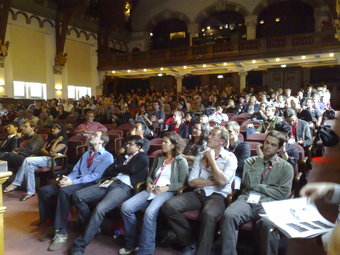
Consider the Audience
The speaker should tailor the complexity of the speech to the specific audience.
Never presume that your audience has a lot of background knowledge on your subject, but also don’t assume they know nothing. The audience is an integral part of public speaking; not only will they hear your speech, but they should be an important component that informs the writing of the speech as well. Consider, for example, if you are preparing to deliver an informative speech on the topic of cloning to an audience of geneticists. Their professional training will have given them an extensive understanding of DNA. Because of this, you would want to tailor the complexity of the speech to match the knowledge that the audience already possesses, meaning that the speech could contain lots of technical terms with little explanation because the audience will already understand what those terms mean.
Conversely, consider delivering a speech on the same topic to an audience of college students. This audience, even if they have taken biology classes, will not possess the same expertise knowledge that professionals do. Therefore, you would want to tailor the complexity of your speech to the knowledge of the students, using fewer technical terms and more general explanations.
13.2.4: Demonstrate the Relevance of the Topic
Make the topic of your speech relevant to your audience by articulating why they should care about your chosen topic.
Learning Objective
Choose a topic that is relevant to your audience
Key Points
- You can make a topic relevant by choosing a timely topic.
- Another way to make a topic relevant is to tell the audience why they should care about the particular subject of your speech.
- Making a topic relevant for your audience increases the likelihood that they will remember the information contained in your speech.
Key Term
- relevant
-
Not out of date; current.
Overview
Informative Speaking is a speech meant to inform the audience. This speech can take on topics ranging from the newest, high-tech inventions from around the world that hope to cure cancer, to more light-hearted topics. The topic should be one that is timely and interesting.
In order to improve the likelihood that the audience will walk away informed by your speech, you should make your topic relevant. The topic of an informative speech should be one that is timely. This means that what was a good topic for a speech for Teddy Roosevelt is probably no longer going to be a good topic for a speech given now. A relevant topic is one that is appropriate for the contemporary period. This is because the information that an informative speech contains should be the most recent, whether this information is statistical data or just the state of the conversation around a particular topic.
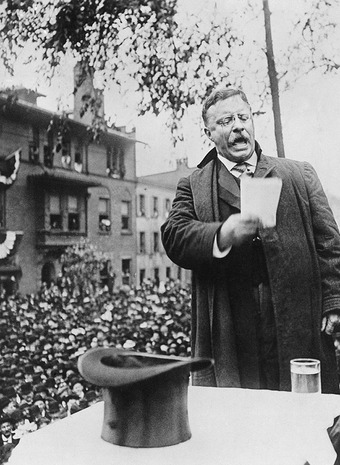
Choose a Relevant Topic
Although Theodore Roosevelt was a great speaker, giving a speech about him today might not be relevant.
Another way to consider how to make the topic of a speech relevant is to consider the audience who will hear your speech. Ask yourself, “What topic would the audience find interesting or useful? ” If you feel committed to a particular topic, then begin thinking about how you can demonstrate why the topic is relevant to your audience. Doing this requires that you articulate why they should care about your chosen topic. But remember that an informative speech should try to communicate this in an unbiased way that does not rely heavily on emotional appeals.
13.2.5: Make Connections
Make connections among your ideas and with audience interests; use transitions, signposts, internal previews, and summaries when speaking.
Learning Objective
Explain how to make connections in your speech
Key Points
- Make connections among your ideas so you can connect the ideas into meaningful groups for your main points.
- Make connections between your interests and the audience interests to motivate attention during your speech.
- Make connections with transitions to show relationships and join ideas together.
- Make connections with signpost transitions to help the audience organize ideas by numbering the main points, such as first, second, etc.
- Make connections by using previews before main points and use internal summaries to connect one idea to what is coming next.
Key Terms
- connection
-
The point at which two or more things are connected; a feeling of understanding and ease of communication between two or more people.
- signpost
-
A particular type of transition in the form of a brief statement that indicates where the speaker is in the speech, such as “first” and “finally,” or that calls attention to a key idea, such as “now remember this.”
- transitions
-
Words or phrases that allow the reader to understand how adjacent parts of a communication are connected.
Make connections like the old time switchboard operator.
In order to make your informative speech effective, you can think of yourself as the old time switchboard operator and make connections!
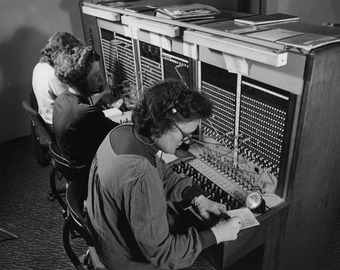
Connecting Information
In your speech, you should make connections between pieces of information for your audience.
Connect ideas and content when preparing the speech. After researching and collecting information for your speech, you will need to connect the ideas and different pieces of information into an organized message. You will group similar ideas together and connect them to form the main points of your speech. In addition to making connections between ideas and pieces of information, one of the most important connections is that between the speech and the audience.
Connect the topic to audience interests. There are many ways to establish this fundamental connection. One of the ways is to explain why the topic of the speech is important. This might occur in the introduction of the speech where you lay out what your speech will say. In addition to laying out the trajectory of the speech, you would include an additional explanation of why the topic is relevant to the audience. Another way to make the connection between the speech and the audience is to express your own interest in the topic. Demonstrating your own excitement could help the audience connect with you and your ideas.
Connect the ideas in the speech with transitions. Transitions are certain words, expressions, or other devices that give text or speech greater cohesion by making it more explicit, or signaling how ideas are meant by the writer or speaker to relate to one another. Transitions can signal addition, example, contrast, comparison, concession, result, summary, time (often chronologically), and place. The following are examples of transitional words and phrases: last, first, second, next, but, on the other hand, moreover, in addition, furthermore, however, to begin with, otherwise, conclusively, lastly, secondly, thirdly, most importantly, in conclusion, to end with, first of all, last of all, to sum it up, last but not least, lastly, finally, for example, on top of all, ultimately, or nevertheless.
Connect the important ideas with signposts. Signposts are a particular type of transition in the form of a brief statement that indicates where the speaker is in the speech, such as first and finally. You use signpost transitions to help the audience organize ideas when you number the main points, such as first, second, etc. You will also use signposts transitions to help the audience remember ideas by telling them what is important by directing their attention to an idea or concept. For example, you might saynow get this, this is really important, or now remember this when you want to signpost the attention of the audience.
Connect ideas with internal previews and summaries. Often you will devote more time to connecting ideas than a simple word or phrase. You may provide a short introductory preview of what you are going to be talking about in order to prepare the audience for what will come next. Additionally, you may want to summarize what you have just said to connect one main point to the next before you start talking about your next point.
13.2.6: Tailor Abstraction to Your Audience
Tailor abstraction to the specific content and the audience level of understanding.
Learning Objective
Use concrete terminology and abstract terminology when it is appropriate for your audience
Key Points
- The ability to simplify experiences with a word makes it easier to communicate, but it also makes us lose the connection to the specific meaning that we want to convey through the abstract wording.
- When you want the audience to make a concrete connection to their direct experience, remember to come down to earth on the the abstraction ladder. You can move up the ladder again to talk about boarder concepts.
- Your objective when choosing words is not to avoid abstract general words altogether, but rather to avoid using them when your audience needs more specific,concrete connections to what you are saying.
Key Term
- abstraction
-
The act of comparing commonality between distinct objects and organizing using those similarities.
Abstraction and the Abstraction Ladder
Abstraction is the process of perceiving similarities from our direct, specific observations in the universe, organizing the similarities, and then assigning a word label for the more general concept. The ability to simplify experiences with a word makes it easier to communicate, but it also makes us lose the connection to the specific meaning that we want to convey through the abstract wording.
Abstraction, the Process
I see a number of different objects and I see something similar about all of them, let’s say the color. I take this one characteristic, the color, and give it a label, for example, red. Here I have a direct observable experience with the objects and I see the color in them. I abstract the color and give it the label red. For you my label red is not connected with the objects I saw, but you may see similar objects and learn to assign the same label, red, to the color. We group together all the similar experiences to form a higher-level concept, which includes all the specific, individual observations we are engaging in abstraction.
Abstraction Ladder, the Concept
S. I. Hayakawa explained the concept using a ladder . Hayakawa used his cow Bessie to illustrate the four levels of abstraction from highest level four at the top to lowest at the bottom.

Ladder
Think of abstraction as a ladder. The most specific and direct experiences are at the bottom, while each step above is more abstract.
- 4 – Wealth
- 3 – Farm Asset
- 2 – Cattle
- 1 – Bessie, my cow
Lets look at another example with clothing. Level one is very specific, such as Levi 501. Moving up to level two, you have noun categories, such as clothing. Moving up a level, you have a broad noun class or group names such as manufactured goods or industry. Finally, at the top level, you have even more abstract concepts such as power, beauty, and casualness.
Almost anything can be described either in relatively abstract, general words or in relatively concrete, specific ones. You may say that you are writing on a piece of electronic equipment, or that you are writing on a laptop computer. You may say that your company produces consumer goods, or that it makes cell phones. When groups of words are ranked according to degree of abstraction, they form hierarchies.
Tailor the level of abstraction to the specific content and the audience level of
understanding
.
Using Concrete, Specific Words for Clarity
In general, as you move from one level to another while speaking, you will tailor the level of abstraction to the specific speech content and the audience level of understanding. You can increase the clarity, and therefore the usability, of your speaking by using concrete, specific words rather than abstract, general ones. Concrete words help your audience understand precisely what you mean. If you say that you want to produce television shows for a younger demographic segment, they won’t know whether you mean teenagers or toddlers. If you say that you study natural phenomena, your audience won’t know whether you mean volcanic eruptions or the migrations of monarch butterflies. Such vagueness can hinder audience from getting the information they need in order to make decisions and take action. When you want the audience to make a concrete connection to their direct experience, remember to come down to earth on the the abstraction ladder. You can move up the ladder again to talk about boarder concepts.
For example, you will draw heavily on level one to create images of specific people, places, or things in the minds of your audience. You may move up and down the level of abstraction as needed. For example, if you are talking about a top-level abstraction such as transportation, you may need to make it real for the audience by describing actual means of transportation such as your green mountain bike for city use or your blue and silver BMW for longer trips.
Abstract and general terms do have important uses for different audiences and occasions. For example, in scientific, technical, and other specialized fields, speakers often need to make general points, describe the general features of a situation, or provide general guidance for action.
Use abstract and specialized terminology to communicate
messages
economically.
Specialized, abstract terminology only works when your audience will understand them. You can use the specialized terminology of a particular profession or group if you know that they already have specific connections to the more abstract terminology. With audiences who understand the abstractions, the technical meanings can communicate messages economically with fewer words than if you started with specific instances at the bottom of the abstraction ladder.
Your objective when choosing words is not to avoid abstract general words altogether, but rather to avoid using them when your audience needs more specific, concrete connections to what you are saying.
13.2.7: Make It Memorable
Making your speech memorable is a way to improve its ability to inform the audience.
Learning Objective
List ways to make your speech memorable for your audience
Key Points
- Use visual aids to help make your speech memorable.
- Repeat key points of your speech to make it more memorable.
- Making your speech memorable is important because it increases the likelihood that the audience will walk away informed.
Key Term
- memorable
-
Worthy to be remembered; very important or remarkable.
Remember that the goal of an informative speech is to inform the audience . Ideally, not only are they informed while you are speaking, but they actually retain that information after you have left the podium. In order for this to happen, you have to make your speech memorable.
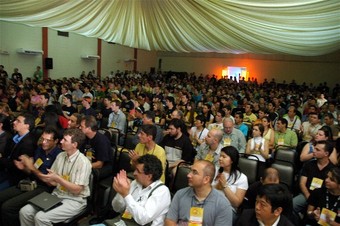
Memorable Speech
Making your informative speech memorable increases the likelihood that your audience will retain the information.
There are multiple ways to make your speech memorable. One way to do this is to repeat the key information that you want the audience to remember. This means repeating important information, within reason, throughout the speech. Lay out the important keys in the introduction of the speech, reiterate them in the body of the speech, and then repeat them again in the conclusion.
Another way to make your speech memorable is to use visual aids. Visual aids have the advantage of providing the information of your speech in an easily digestible form. In addition, visualizations have the ability to be uniquely captivating. Having an attractive visual can get the attention of the audience and improve the chances that they will remember the information contained in the visualization.
Though there are many ways to make an informative speech memorable, another way is to let yourself be engaged in the presentation of the speech. Demonstrating your own excitement by the speech’s topic has the possibility of drawing in the audience. If the speaker seems uninterested in the speech, then why should the audience be engaged? Therefore, let yourself be absorbed and excited by the speech, which might lure in the audience and make the speech more memorable.
These are just a few ways to make your speech memorable. Remember, the goal of making an informative speech memorable is to increase the likelihood that your audience will walk away informed. Using visual aids and repetition of key points are two strategies to use in order to deliver an effective informative speech.
13.2.8: Utilizing Devices to Enhance Audience Understanding
Visual aids, microphones, video screens, and/or a podium can help enhance audience understanding.
Learning Objective
Describe the use of devices in public speaking
Key Points
- Visual aids such as graphs, handouts, slide show presentations, and objects can help audiences understand complicated subjects. Many people learn visually and need information provided in this context, as well as orally, to enhance learning.
- A podium can help the presenter provide the audience with necessary information on a topic by offering a place for the speaker to have cue cards or scripts.
- A microphone is a good way to make sure that everyone in the audience hears the presentation properly. Wireless headsets allow the speaker to amplify the presentation while moving about the audience or reviewing visual aids.
- A video screen is a good way to make sure the audience can see the entire presentation in a large venue.
Key Term
- podium
-
A platform on which to stand, as when conducting an orchestra, preaching at a pulpit, or delivering a speech.
Utilize Devices to Enhance Audience Understanding

Visual Aid
Using a visual aid, like a large-screen digital projector, helps inform the audience.
Visual Aids
Many people need the assistance of visual material to understand complicated topics. Visual aids help the speaker reinforce the information provided in the speech to increase absorption and retention of the material. Visual aids can include objects, models, handouts, graphs, charts, photos, and slide show presentations. With visual aids, a speaker needs to make sure they adequately enhance the presentation without causing a distraction for the audience.
Podium/Rostrum
A podium can help an audience understand a speech. It allows the speaker to have notes or scripts to make sure the important information is covered regarding the subject matter. Additional information can be included in the notes so that if the audience has any questions the speaker can make sure they provide a complete answer.
Amplification
Amplification is important to make sure that the entire audience can hear the speech properly. Some large auditoriums and amphitheaters are designed to assist acoustics. Still, a microphone is a beneficial addition to a speaker’s toolkit. With the advancements in wireless technology, a headset can also be used, enabling the speaker to move about during the presentation, go over visual aids, or enter the audience during the question and answer session.
Video Screens
Video screens are beneficial for an audience, especially those who are seated in a large venue. The screens can help the audience see the speaker and the visual aids better, especially if they are in the back of the room or off to the far right or far left of the stage. Video screens are often available at modern conference centers and auditoriums that can be synced with presentation devices.
With the addition of visual aids, podiums, microphones, and video screens, a presenter can ensure that the audience is able to see, hear, and understand the material properly. When determining the type of visual aids needed for a speech, the speaker needs to consider the subject matter, audience, and venue so that the right materials are used to enhance audience understanding.
13.3: Sample Informative Speech
13.3.1: Sample Informative Speech
On May 1, 2011, President Barack Obama delivered an informative speech to the international community on the death of Osama bin Laden.
Learning Objective
Identify ways in which President Obama’s speech about the death of Osama bin Laden was a good example of an informative speech
Key Points
- In the late hours of May 1, 2011, President Barack Obama gathered in the East Room of the White House to address America and the world that Al Qaeda’s highest commander, Osama bin Laden, had been killed via military actions in Pakistan.
- President Obama gives context by describing the events of September 11, 2001 and bin Laden’s instrumental role in that day’s events.
- The President shares some details on international intelligence gathering on bin Laden’s current location as well as the decision-making process to proceed with the military operation on the bin Laden compound in Abbottabad, Pakistan.
- The President’s speech is largely focused on events and processes, two examples of informative speeches. He describes the events of September 11, 2001 and the military operation on May 1, 2011 as well as the process of how that military operation was carried out.
- The President concludes his speech by thanking the many people involved in the locating and killing of Osama bin Laden, as well as the patience and resolve of the American people in the years since September 11, 2001.
Key Terms
- excerpt
-
A clip, snippet, passage or extract from a larger work such as a news article, a film, a literary composition, or other media.
- intelligence
-
A political or military department, agency or unit designed to gather information, usually secret, about the enemy or about hostile activities.
- firefight
-
A skirmish involving an exchange of gunfire.
Sample Informative Speech
The following excerpts are taken from President Barack Obama’s informative remarks to the American people of the death of Osama bin Laden, given on May 1, 2011.
Good evening. Tonight, I can report to the American people and to the world that the United States has conducted an operation that killed Osama bin Laden, the leader of al Qaeda, and a terrorist who’s responsible for the murder of thousands of innocent men, women, and children.
It was nearly 10 years ago that a bright September day was darkened by the worst attack on the American people in our history. The images of 9/11 are seared into our national
memory
— hijacked planes cutting through a cloudless September sky; the Twin Towers collapsing to the ground; black smoke billowing up from the Pentagon; the wreckage of Flight 93 in Shanksville, Pennsylvania, where the actions of heroic citizens saved even more heartbreak and destruction…
…We were also united in our resolve to protect our nation and to bring those who committed this vicious attack to justice. We quickly learned that the 9/11 attacks were carried out by al Qaeda — an organization headed by Osama bin Laden, which had openly declared war on the United States and was committed to killing innocents in our country and around the globe. And so we went to war against al Qaeda to protect our citizens, our friends, and our allies.
Over the last 10 years, thanks to the tireless and heroic work of our military and our counterterrorism professionals, we’ve made great strides in that effort. We’ve disrupted terrorist attacks and strengthened our homeland defense. In Afghanistan, we removed the Taliban government, which had given bin Laden and al Qaeda safe haven and support. And around the globe, we worked with our friends and allies to capture or kill scores of al Qaeda terrorists, including several who were a part of the 9/11 plot.
Yet Osama bin Laden avoided capture and escaped across the Afghan border into Pakistan. Meanwhile, al Qaeda continued to operate from along that border and operate through its affiliates across the world.
And so shortly after taking office, I directed Leon Panetta, the director of the CIA, to make the killing or capture of bin Laden the top priority of our war against al Qaeda, even as we continued our broader efforts to disrupt, dismantle, and defeat his network.
Then, last August, after years of painstaking work by our intelligence community, I was briefed on a possible lead to bin Laden. It was far from certain, and it took many months to run this thread to ground. I met repeatedly with my national security team as we developed more
information
about the possibility that we had located bin Laden hiding within a compound deep inside of Pakistan. And finally, last week, I determined that we had enough intelligence to take action, and authorized an operation to get Osama bin Laden and bring him to justice.
Today, at my direction, the United States launched a targeted operation against that compound in Abbottabad, Pakistan. A small team of Americans carried out the operation with extraordinary courage and capability. No Americans were harmed. They took care to avoid civilian casualties. After a
firefight
, they killed Osama bin Laden and took custody of his body.
For over two decades, bin Laden has been al Qaeda’s leader and symbol, and has continued to plot attacks against our country and our friends and allies. The death of bin Laden marks the most significant achievement to date in our nation’s effort to defeat al Qaeda…
…Tonight, I called President Zardari, and my team has also spoken with their Pakistani counterparts. They agree that this is a good and historic day for both of our nations. And going forward, it is essential that Pakistan continue to join us in the fight against al Qaeda and its affiliates…
…We give thanks for the men who carried out this operation, for they exemplify the professionalism, patriotism, and unparalleled courage of those who serve our country. And they are part of a
generation
that has borne the heaviest share of the burden since that September day.
Finally, let me say to the families who lost loved ones on 9/11 that we have never forgotten your loss, nor wavered in our commitment to see that we do whatever it takes to prevent another attack on our shores.
And tonight, let us think back to the sense of unity that prevailed on 9/11. I know that it has, at times, frayed. Yet today’s achievement is a testament to the greatness of our country and the determination of the American people…
…Thank you. May God bless you. And may God bless the United States of America.
Chapter 18: Speaking in and for Groups
18.1: Working in Groups
18.1.1: Leadership in Groups
While leadership styles vary, effective group leaders are characterized by group involvement, mutual respect, and excellent communication.
Learning Objective
Describe the qualities of effective leadership in groups
Key Points
- There are three main leadership styles: Laissez-faire, Democratic, and Authoritarian. A leader’s style and involvement may fall anywhere along the continuum.
- It is the group leader’s job to unite group members in working toward a common goal, keep them motivated, diffuse conflict, and ultimately deliver success.
- Excellent communication can be the key to successful group work. When messages are properly understood and all group members feel they are being heard, the group’s goal can more easily be accomplished and conflict is less likely.
Key Terms
- continuum
-
a continuous series or whole, no part of which is noticeably different from its adjacent parts, although the ends or extremes of it are very different from each other
- rapport
-
a relationship of mutual trust and respect
Example
- This photo of civil rights leaders with President Johnson shows several examples of leadership.
Leadership Overview
There are many essential elements to being an effective leader. A group leader must be responsible for not only participating in the group and ensuring that the group’s goal is attained, but also for motivating the team, delivering success, and being a resource that group members can reach out to for help.
Leadership Continuum
Leaders are usually categorized along a continuum, at one end of which lies the Laissez-faire leader, in the middle the Democratic leader, and at the other end the Authoritarian leader.
Laissez-faire is French for “let do.” A Laissez-faire leader takes a laid back or hands-off approach. This style may be most effective in a highly skilled and motivated group, or in order to foster creativity and participation. However, if a group is in need of direction, then a laissez-faire style may result in frustration and inefficiency.
An Authoritarian leader is one in which a leader attempts to exert maximum control over a group. This leadership style may be beneficial when a group is lost and disorganized or there are significant time pressures. However total control can also lead to group tensions or resentment of the leader and group members are also not likely to stay committed to the project as they feel they have no part in the decision making process.
The Democratic style of leadership falls somewhere in between Laissez-faire and Authoritarian styles. A Democratic leader will allow the decision-making power to be shared amongst group members and not only themselves. At the same time, a Democratic leader will facilitate discussions and lead the group in right direction.
Recently, leadership theories have emphasized the importance of leaders who cultivate positive, mutual relationships within their groups rather than step back too much from the team or dictate the flow of work. The leader must know each member of the team as well as the team as a whole in order to bring them all together. An effective leader uses each member’s contributions and energy to focus on a common goal.

Group Leadership
General Petraeus talks with U.S. soldiers serving in Afghanistan.
Group Leadership
Communication is one of the most important aspects of working successfully in a group setting. Therefore, good communication skills are an essential quality for a good leader. Communicating is always difficult in a group, but these difficulties can be magnified by factors such as large group sizes, strong personalities, or differences in opinion.
When working in a group, it is important to have a common goal around which group members can unite. This is something on which all group members can agree and which they all desire to work toward. When leaders find that they have particularly strong-willed group members who seem to dominate the conversations, or several group members who do not seem to get along, communication can often be the key to resolving the conflict.
In these situations, effective communication techniques include discussing the conflict openly with the members involved, providing a more structured discussion forum so all members can be heard, or even engaging group members in non-project related bonding activities such as ice-breaking games, a group lunch, or a fun outing.
Technology is now a great resource for effective group communication. Technology is a great way for large groups to share their ideas. Often, groups can become so large that it is difficult for all the members to meet at the same time and place. Additionally, in large groups it can be difficult to allow everyone’s ideas to be heard. Through various platforms such as email, Google Groups, Blackboard, Facebook, and others, it is possible for group members to share their ideas in an organized manner so they can be read by others at their own leisure.
While leadership styles may vary with person and situation, it is always important for leaders to remember their role in the group. Effective leaders both participate in the group and work to achieve the overall goal of the group, guiding members in the right direction. Effective leaders will build mutually respectful relationships with their group members. Having a rapport with group members allows leaders to better understand members’ actions and increase their cooperation. Finally, effective leaders facilitate excellent communication amongst the group. Great communication leads to better and more effective idea generation and less conflict overall.
18.1.2: Responsibilities in Group Work
When all member assume their expected responsibilities, working in groups can be enjoyable and effective.
Learning Objective
Describe the typical roles and responsibilities of group members
Key Points
- Assigning group members roles can help alleviate uncertainty about expected responsibilities and help keep the group on task such as leader, scribe, devil’s advocate, and tracking lessons learned.
- Group member responsibilities include holding themselves accountable, participating in group activities to achieve the overall goal, and respecting all members of the group.
- Each group member has something uniquely valuable to bring to the table. Allowing group members to use their strengths and bring their individual knowledge and backgrounds to the project will allow the group to function to its full potential.
Key Term
- group think
-
A process of reasoning or decision – making by a group, especially one characterized by uncritical acceptance or conformity to a perceived majority view.
Responsibilities in Group Work
When participating in group work, every member of the team has a responsibility to the group and the project. If each member does not participate, contribute, and deliver results, the group will ultimately fail to achieve their goal. Collaboration becomes effective only when group member participation is balanced .
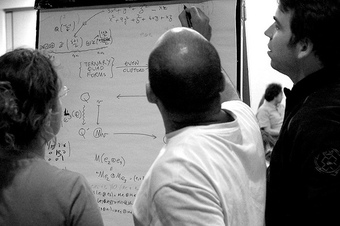
Group Work
Assigning roles can make groups more effective.
Everyone in a group must learn to hold themselves accountable and be accountable to the other people in their group. Without accountability, work will not get done, deadlines will not be met, and the group will not be able to reach its goal. Individual and group accountability means that no one student has to do all the work. Accountability means not only being accountable for the physical work that a group member must deliver, but also attendance to group meetings, conduct, and behavior towards other group members, etc. It is also important to remember that group members are diverse and each one has a different strength and perspective to bring to the project based on their backgrounds, learning style, experiences, and aspirations.
Typical Roles in a Group
While everyone should be responsible for brain storming, problem solving, and providing their experience and knowledge, sometimes it can be helpful to assign group member specific roles. That way, members know exactly what they are responsible for. Four roles that are commonly found in groups are: a leader, a scribe, a lessons learned tracker, and a devil’s advocate.
- Leader – In the event there is no clear chain of command, a team must be prepared to assign the role of leader. A leader can keep the team focused, mediate conflicts, and ensure that individuals are held accountable.
- Note taker or scribe – again, a simple idea, but documenting every meeting is an important step in developing a productive team. A scribe can quickly get a team up to date with past notes so little time is wasted remembering where you left off. Documenting and distributing notes from each meeting will equally inform all team members.
- Lessons Learned tracker – Identify one person to track both positive and negative outcomes of meetings and projects. This individual can solicit input from other members. By documenting what everyone thinks went well and why and what did not go well and why, can keep a team productive by not repeating past mistakes.
- Devil’s Advocate – Teams need to embrace conflict and different points of view. By assigning a devil’s advocate, this person can freely bring up alternatives or objections, making the team more objective.
By assigning these roles to members of the group, it can increase efficiency and productivity. The group now has people in specific roles to help them stay on track and the group members can now clearly outline their responsibilities in regards to the group work.
Characteristics of Great Group Members
Characteristics of great group members are those who actively participate, respect all other members, can both learn from other members and teach them, values other’s contributions, draws on their own unique past experience and knowledge, and feels a sense of ownership over the project. To strive to embody all of these characteristics is the responsibility of all group members, regardless of their assigned role.
Responsibilities of Group Members
Group members are not only responsible for creating positive productivity within their group, but they must also avoid falling into the trap of unproductive behaviors that also arise in group settings. Group think and social loafing are two incredibly common negative phenomena that arise in group collaboration.
- Groupthink is simply going along with the team on a decision because that seems to be the consensus and they want to avoid conflict. Having a strong devil’s advocate will help reduce the chances of groupthink.
- Social loafing is someone that is putting forth less effort as a member of a group than they would as an individual. They are allowing the other members of the group to do the majority of the work with the intention of still reaping equal benefits. Again, leadership and holding people accountable is a great tool to deal with social loafing.
Working in groups can be challenging. Blending people from many different backgrounds, with different personalities styles and work ethics can make consensus difficult. However, when all group members take on their expected responsibilities, group work can become much more enjoyable and effective.
18.1.3: Reflective Thinking
Reflective thinking about group work allows students to evaluate both successes and failures of the project and work towards improvement.
Learning Objective
Explain how reflective thinking is used in group settings
Key Points
- Reflective thinking requires scientific analysis of a problem and using empirical knowledge to make decisions.
- According to John Dewey, a disciplined mind is necessary to gain knowledge and obtain true intellectual freedom.
- When group members use reflective thinking, they are able to use the scientific method to reach logical decisions and understand the strength of the group based on individual competencies.
Key Term
- scientific method
-
A method of discovering knowledge about the natural world based in making falsifiable predictions (hypotheses), testing them empirically, and developing peer-reviewed theories that best explain the known data.
Reflective Thinking
Reflective thinking is using the scientific method to make a decision. This helps to create deep learning, which will enable the growth of an individual in many different aspects, including morally, emotionally, and cognitively. Reflective thinking helps to determine an individual’s strengths and weaknesses by allowing individuals to question values and beliefs, challenge assumptions, recognize biases, acknowledge fears, and find areas of improvement.
John Dewey and Critical Thinking
Dewey’s method of critical thinking involves a disciplined mind in order to gain knowledge . A disciplined mind needs intellectual control of the thinking process, which is so often emotionally based. This disciplined mind offers intellectual freedom, and discipline shouldn’t be viewed as a negative aspect as many individuals believe it to be.
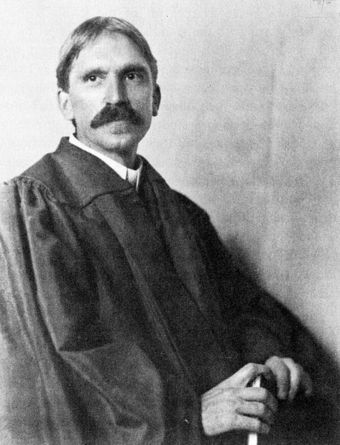
John Dewey
Public speaking students are often taught John Dewey’s methods of reflective thinking.
Reflective Thinking in a Group Setting
Using reflective thinking in a group setting can allow for intellectual decisions based on defining a problem and using concepts based in logic to select the best solution. Group members will then be able to compare and contrast their colleagues’ interpretations of the project experience with their own. They can learn about the strengths and weaknesses of the group, as it is comprised of the competencies and assumptions of the individuals.
Reflective thinking about group work should cover ideas such as:
- What did I do well? What did the group do well?
- What could I improve on? What could the group improve on?
- What was one of the largest obstacles the group faced? Did did we overcome it? How?
- Was there group conflict? Was it resolved? How?
- Was our group successful? Did we complete our objective? Why or why not?
- What would we do differently if we were given the opportunity to repeat the project?
Reflective thinking is an excellent tool for identifying positive and negative aspects of a group work experience. By spending time seriously contemplating the overall process, both during and after the project, it is possible for group members to learn from their experience and work toward improving their group work skills for the future.
18.2: Presenting Group Thinking
18.2.1: Group Presentation Formats
Group presentations can be structured around a set format or can borrow components from different formats.
Learning Objective
Define four formats of group presentations
Key Points
- A panel format is a discussion between group members led by a moderator.
- A divided presentation is a sequence of individual presentations by group members.
- A debate format presents two sides of an issue and reasons for and against each side.
Key Terms
- forum
-
A form of discussion involving a panel of presenters and often participation by members of the audience.
- symposium
-
A conference or other meeting for discussion of a topic, especially one in which the participants make presentations.
- format
-
The form of presentation of something.
Group presentations can take place in different formats. These formats give a group an idea of how to structure their presentation, though different components can be taken from several formats and combined according to a group’s particular needs and goals.
Panel Presentation
A panel is a format in which the presenters talk to each other in addition to the audience. Typically the panel will consist of several group members to whom a moderator poses questions. The panel members then present their views on the question and discuss their different answers. The audience has the benefit of viewing this dynamic discussion play out before them. Often questions will also be taken from the audience, so audience members can become involved in the discussion as well. However, with such loose organization, the moderator must maintain control over the presentation and keep the group on topic .

Panel Discussion
In an panel discussion, the panel members talk to one another as well as the audience.
Symposium
A symposium presentation is a group presentation that is essentially a collection of individual presentations covering a broad topic. The topic is broken up into subtopics, and each group member, one after another, makes a presentation on his or her subtopic. All together, the group covers the topic in its entirety. This format is very easy to organize and coordinate as long as each group member remains cognizant of not addressing a different member’s subtopic. Since this method can make for a long presentation, the group members must concentrate on engaging the audience and keeping their attention.
Public Forum
Public forum debate can be compared to a nationally-televised debate, such as ‘Crossfire’ in which the debaters argue a topic. The debate in a public forum is conducted by teams of two people alternating speeches for their side, either affirming or negating their topic. Successful public forum debaters must make persuasive and logical arguments in a manner that is accessible to a wide variety of audiences. Public forum debate also focuses on not only logical, but research based arguments.
Oral Report by Group Leader
In this format, the designated leader of a group makes an individual presentation of the group’s thoughts and findings on a topic. The leader may summarize views from several different group members and present points of agreement and disagreement.
18.2.2: Thoughts for Group and Individual Presenters
Each individual in a group presentation should know their role and stay consistent and cooperative with the other members.
Learning Objective
Demonstrate how to each individual in a group should participate in a group presentation
Key Points
- The first speaker should introduce the entire presentation. After that, each speaker should introduce the next and transition with a preview of their topic.
- Each presenter should make eye contact with the audience and move to the front of the group when it is his or her turn to speak. The last speaker should then conclude the entire presentation.
- When preparing the presentation, the group should check each individual’s work for consistency of information and formatting. Group members should answer audience questions as a team with no one member dominating.
Key Terms
- transition
-
The process of change from one form, state, style, or place to another.
- consistency
-
correspondence or compatibility
There are several important considerations for an individual to keep in mind to help a group presentation succeed.
Choosing Roles
The instructor may require every person to speak during the presentation. However, if you are given a choice of how many speakers to include, decide which group members will speak and which ones will not. Because it is important for every student to develop strong knowledge of presenting, every member could benefit from speaking. Any members who do not present should be given other significant responsibilities .

Group Presentation
In a group presentation, all of the members will have a specific role.
Group Introduction
The first speaker should open with an introduction to the whole presentation rather than an introduction to only his or her part. This group introduction makes the presentation as a whole accessible to the audience. It introduces the group members, establishes goodwill between speakers and the audience, motivates them to listen, and previews all the talks.
Transitions between Speakers
Each speaker should identify the next speaker by name and signal that person’s topic. Changing speakers without such a spoken transition can break the flow of the presentation, and it may leave the impression that you are unprepared or that your presentation is unorganized. A transition should remind the audience of the sequence the group introduction promised. It should help listeners know where they are in the presentation as a whole. Transitions may also emphasize any special qualifications of the next speaker.
Internal Previews
Each individual speaker except the first should connect his or her part to the overall argument and tell the audience what topics he or she will discuss. Such statements identify the structure of the talk and help the audience follow along.
Group Conclusion
The last speaker should present a conclusion for the whole presentation rather than just a conclusion for his or her part. The last speaker is responsible for ensuring that the series of talks is comprehensible as a whole. He or she should summarize briefly the key points, motivate the audience to act, or reinforce the group’s interpretation of the issue with a memorable closing statement.
Move to the Front to Speak
If all the group members remain standing during the presentation, each one should move to the front of the room when it is his or her time to speak. Moving to the front will non-verbally draw the audience’s attention to the speaker.
Connect with the Audience through Eye Contact
In a team presentation, every individual speaker needs to develop rapport with the audience. Since each person has only a short time to connect with the audience, eye contact and introductions are especially important. Speakers should stand where they can see the computer screen, the audience, and, if possible, other team members.
Check for Overlaps, Accuracy, and Consistency
Since group members often prepare their parts of the presentation individually, it is necessary to check for overlapping or contradictory information once the individual parts are assembled. Although the first and last speakers cover the presentation as a whole, the speakers in the middle should not re-present evidence unless new analysis is involved. A speaker should build on what the previous speaker said—not merely repeat it.
Check for Consistent Formatting
All handouts or visuals should use the same formatting. A patchwork of different fonts, font sizes, and other formatting conventions may negatively impress the audience, distract or mislead them, and undermine the group’s credibility.
Answering Questions as a Team
The person who speaks first should act as the leader during Q&A. He or she should direct questions to the team member who knows most about the topic of the question and should therefore answer first. The leader should not dominate Q&A. Other team members may unobtrusively signal that they would like to contribute to the answer when the first person finishes.
18.2.3: Preparing for Team Presentations
The way a team functions while preparing for a presentation can be broken down into formal processes and interactions.
Learning Objective
Define the processes that describe the dynamics of group thinking and team presentations
Key Points
- The model for understanding team processes can be grouped into three categories: transition, action, and interpersonal.
- Teamwork processes examine interpersonal interactions between group members, which can be used as strategies for successful presentations.
- Another approach to the dynamics of a team presentation involves looking specifically at the strategies that guide interactions between group members throughout the team effort.
- Establishing ground rules, coordinating meeting times, and effectively resolving disputes are some methods used to build effective teams and group presentations.
Key Terms
- process
-
A series of events to produce a result, especially as contrasted to product.
- strategy
-
A plan of action intended to accomplish a specific goal.
Preparing for Team Presentations
The way a team prepares for a presentation can be broken down into formal processes and interactions. This is not a strict distinction, but two different ways of analyzing how a team achieves its goals while building, practicing, and delivering a presentation.
Processes
Researchers have identified ten teamwork processes divided into three categories, which can be used to describe the dynamics of group thinking and team presentations.
Transition processes are reflective in nature, and take place between periods of action. They serve to assess previous actions and outline future actions. In team and group presentations, these processes can serve to:
- Determine what the team is trying to achieve, and what steps will lead there.
- Specify the incremental goals and accomplishments that will lead to overall mission success.
- Formulate an approach to achieving the goals and mission.
Action processes embody the steps that the group takes to move forward. Whether during preparation or delivery of a presentation, these actions are crucial to working effectively in a team. Team members within groups must:
- Monitor progress toward goals and make sure the team is on track, rather than veering off course.
- Assure that roles and responsibilities are being fulfilled.
- Monitor and backup behavior to ensure that all members remain engaged.
- Coordinate roles to keep things organized and working smoothly.
Interpersonal processes apply during the delivery of group presentations, while team member both present and transition between roles (e.g., speaker and observer). They include:
- Identifying and resolving disputes.
- Motivating and building confidence, while maintaining high member performance.
- Making sure group member participation steers rather than stalls the development and delivery of the presentation.
Interactions
Another approach to the dynamics of a team presentation involves looking specifically at the strategies that guide interactions between group members throughout the team effort. Examples of strategies for interaction include:

Group Interactions
Timing transitions between slides and other breaks is crucial to a well-prepared group presentation.
- Establishing ground rules: Establishing ground rules sets expectations for each group member on how the group plans to achieve its end goal (e.g, educate students, sell a product to prospects, etc). Making these rules explicit helps avoid miscommunication at the beginning of the project.
- Mission analysis:This strategy ensures every team member has contact information for the others, and that everyone’s schedule is coordinated for meeting times. At a higher level, it means achieving consensus on how group decisions will be made and how group information will be shared with all team members.
- Managing team cooperation: This strategy applies to group meetings. It focuses on outlining an intention for each meeting, and reviewing meeting activities and actions to ensure the intention has been met.
- Resolving conflict: Resolving conflict requires the group to acknowledge that there is a legitimate conflict. The group must then agree on an approach to address it, and determine how to proceed. Possible solutions include discussing a compromise, referring to previously established group decisions, or deciding to address the issue later.
- Preparing Back-ups: Practicing transitions between group members’ sections, preparing extra copies of handouts and other visual aids, and reviewing group members’ roles are all part of this strategy. This helps improve preparation and the delegation of tasks within the group.
Chapter 17: Special Occasions
17.1: Speeches for Special Occasions
17.1.1: The Speech of Introduction
Introductory speeches may not be the main event, but they are key for getting an audience acquainted with their main speaker.
Learning Objective
Define an introduction speech
Key Points
- Introduction speeches are usually brief and always prepared in advance.
- If you know the person you’re introducing, it certainly makes it easier to prepare your remarks. However, be mindful of the context of your relationship to the speaker, and the context of the event itself. For example, avoid an overly casual tone when speaking at a formal event.
- If you don’t know the speaker, conduct some research to get a basic understanding of who they are, as well as any relevant work that applies to their keynote. To help you prepare, consider contacting the speaker in advance to request their professional biography or their curriculum vitae (CV).
Key Terms
- curriculum vitae
-
A detailed written account of one’s education and experience used to seek positions in academic or educational environments, typically including academic credentials, publications, courses taught, etc.
- introduction
-
A means of presenting one person to another.
- keynote
-
A speech that sets the main theme of a conference or other gathering; a keynote speech or keynote address.
The Introduction Speech
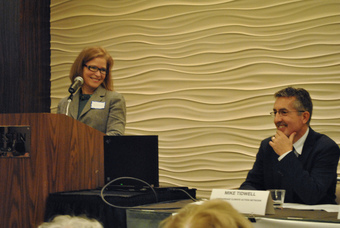
Introduction
You might not be the headliner, but you may get to introduce the keynote speaker.
Sometimes you may be asked to speak at an event or occasion before the headlining speech, or be called upon to introduce a keynote speaker or panelist.
The introduction speech is no less significant than the keynote. It’s important because you’re getting your audience warmed up and accustomed to who will be speaking about the topics and issues they care about. Just as we appreciate when friends introduce us to new acquaintances, your audience appreciates being introduced to their main speaker.
There may be times when you know the person that you’re introducing, so it might be easier to talk about them. Just be mindful of the context of both your relationship and the event itself. You might be buddies with a leading scientist in biology at a biology conference, but that doesn’t mean you should introduce him by the nicknames you call each other on Facebook.
Knowing the person you need to introduce is also helpful as you can ask them directly what information they would or would not like shared about them.
There will also be times where you may only have passing knowledge about the person you’re introducing, or perhaps you might not know anything about them at all. But in the age of the Internet and the Google search, it shouldn’t take very long to find out some basic information about them that is relevant to their speech, such as their professional experience or publications.
You may also be able to contact them to see if they can provide you with a professional bio or curriculum vitae (CV). In the latter instance, you may want to distill that into your own prepared remarks.
The good news is that speeches of introduction are usually brief and always prepared. Whether you’re reading from a script or teleprompter, you typically won’t be asked to introduce someone you don’t know without preparation.
17.1.2: The Speech of Presentation or Acceptance
Acceptance and presentation speeches both occur at events where awards and honors are distributed, but have different focuses.
Learning Objective
Discuss how to prepare an acceptance speech
Key Points
- If you’ve been nominated or won a particular award or honor, always prepare an acceptance speech so you don’t fumble your words once on stage.
- In an acceptance speech, always thank the award-giver, be they an individual or an organization. Don’t forget to thank anyone who helped you achieve your honor, either.
- Speeches of presentation introduce the award itself, tell a little about its history and meaning, and introduce and name the actual awardee.
Key Term
- humble
-
Not proud, arrogant, or assuming; modest.
The Speech of Presentation or Acceptance

Accepting an Award
Whenever someone is nominated for an award, they should prepare an acceptance speech.
When you think of an acceptance speech, you might think of actress Sally Field clutching her Oscar award shouting into the microphone: “You like me! You really, really like me! “
Often, these speeches are far more humble.
Acceptance Speech
If you’ve been nominated for an award or honor, you may be asked to prepare some remarks in the event you win the award. Other times, you may know that you have won, making it substantially easier to prepare. Acceptance speeches may vary in length. For a multi-award event, such as the Academy Awards, winners are given a brief ninety seconds to make their remarks. At other times, a person could be the single awardee of the evening and have substantially more time to speak, often doubling as keynote speaker.
Acceptance speeches thank the awarding individual or organization. Depending on the award, the awardee may speak about their experience and emotions of getting that award or the work to achieve that award. If others have helped you in your endeavors, you may give them a quick thanks by name as well. If you’re partnered, you may thank your spouse, partner, or children. And if it’s a benefit for the Humane Society, it might even be appropriate to thank your pets!
Like any speech, consider your audience and the context of the speech. While being mindful of your time, get your thanks in while being gracious and humble.
Even if you are one of many in a field of nominees, it’s always a good idea to prepare an acceptance speech so that if you are named the winner, you won’t be fumbling for your words on stage.
Presentation Speech
Similar to the introductory speech, presentation speeches are typically prepared in advance and may describe the awardee before naming them, or describe the circumstances for their awarding.
If the award is named or in memory of someone, you may describe why that award was named in that person’s honor, such as the Pulitzer or Nobel Prize. You may talk about the criteria for selecting the award and how the awardee met that criteria for their specific work.
The speech of presentation is one that is particularly enjoyable to give, as the awardee is often honored to have received the award in the first place!
17.1.3: The Speech to Secure Goodwill
Speeches to secure goodwill seek to forge new relationships between previously unknown, antagonistic, or unfamiliar entities.
Learning Objective
Define a speech to secure goodwill
Key Points
- Goodwill speeches are both informative and persuasive. You seek to persuade your audience to be in favor of you and who or what you represent.
- Goodwill speeches highlight shared values, customs, beliefs, and morals.
- Goodwill speeches do not make assumptions or judgments about their audience and are not meant to intimidate, embarrass, or offend.
- One of the best examples of a goodwill speech is “Ich bin ein Berliner” (I am a Berliner) delivered by President John F. Kennedy in 1963.
Key Term
- goodwill
-
A favorably disposed attitude toward someone or something.
The Speech to Secure Goodwill
Goodwill speeches seek to introduce oneself or an entity to another group, organization, or even country, while building a goodwill relationship with that audience. They may occur on a small scale such as through a maiden speech by the new CEO to a company, or on a large scale, e.g. a world leader touring another country.
Goodwill speeches are informative and persuasive. You are persuading your audience to consider you favorably. You will want to make the case about what makes you qualified or relevant to them. Goodwill speeches also often highlight shared customs, values, morals, and beliefs. Goodwill speeches do not make assumptions or judgments about their audience and do not intimidate, embarrass, or offend them.

Speech to Secure Goodwill
John F. Kennedy’s famous “Ich bin ein Berliner” (I am a Berliner) is a prime example of a speech to secure goodwill.
Perhaps one of the most famous goodwill speeches was made by President John F. Kennedy in 1963 in Berlin, Germany. Often referred to as “Ich bin ein Berliner” speech (“I am a Berliner”), the speech discusses how to build rapport and favorable attitudes between two differing nations (as excerpted below):
I am proud to come to this city as the guest of your distinguished Mayor, who has symbolized throughout the world the fighting spirit of West Berlin. And I am proud to visit the Federal Republic with your distinguished Chancellor who for so many years has committed Germany to democracy and freedom and progress, and to come here in the company of my fellow American, General Clay, who has been in this city during its great moments of crisis and will come again if ever needed…
…You live in a defended island of freedom, but your life is part of the main. So let me ask you, as I close, to lift your eyes beyond the dangers of today, to the hopes of tomorrow, beyond the freedom merely of this city of Berlin, or your country of Germany, to the advance of freedom everywhere, beyond the wall to the day of peace with justice, beyond yourselves and ourselves to all mankind.
Freedom is indivisible, and when one man is enslaved, all are not free. When all are free, then we can look forward to that day when this city will be joined as one and this country and this great Continent of Europe in a peaceful and hopeful globe. When that day finally comes, as it will, the people of West Berlin can take sober satisfaction in the fact that they were in the front lines for almost two decades.
All free men, wherever they may live, are citizens of Berlin.
And, therefore, as a free man, I take pride in the words, “Ich bin ein Berliner. “
17.1.4: Commemorative Speeches: Dedications and Eulogies
Dedications and eulogies are two types of commemorative speeches that memorialize people and/or events.
Learning Objective
Identify types of commemorative speeches
Key Points
- Dedications may honor an individual, a group of individuals, or a specific event.
- Eulogies honor a specific deceased person, celebrating the life he lived rather than mulling on the manner or circumstances of their death.
- It is entirely acceptable for speech givers to become emotional when delivering these types of speeches (especially eulogies) as they can evoke strong emotions with both speaker and audience.
Key Terms
- dedication
-
A ceremony marking an official completion or opening.
- eulogy
-
An oration to honor a deceased person, usually at a funeral.
- commemorate
-
To honor the memory of someone or something with a ceremony.
The Commemorative Speech
Commemorative speeches are those that celebrate and honor the memory of someone or something. If you consider various memorial holidays and observances throughout the year, such a Memorial Day in the United States, many people commemorate the occasion by remembering fallen veterans. In England, the English commemorate their fallen heroes by wearing poppies on Remembrance Day.
The Dedication
The dedication is a very specific type of commemorative speech. It is often accompanied by a ceremony accompanying an official opening or completion of something. The speech honors the event, individual or groups of people to which the items are being dedicated. Take for example, the dedication of the National Cemetery in Gettysburg, Pennsylvania in 1863, by then President Abraham Lincoln:
Fourscore and seven years ago our fathers brought forth on this continent a new nation, conceived in Liberty, and dedicated to the proposition that all men are created equal. Now we are engaged in a great civil war, testing whether that nation, or any nation so conceived and so dedicated, can long endure. We are met on a great battlefield of that war. We have come to dedicate a portion of that field, as a final resting-place for those who here gave their lives that that nation might live. It is altogether fitting and proper that we should do this. But, in a larger sense, we cannot dedicate—we cannot consecrate—we cannot hallow—this ground. The brave men, living and dead, who struggled here, have consecrated it far above our poor power to add or detract. The world will little note nor long remember what we say here, but it can never forget what they did here. It is for us, the living, rather, to be dedicated here to the unfinished work which they who fought here have thus far so nobly advanced. It is rather for us to be here dedicated to the great task remaining before us—that from these honored dead we take increased devotion to that cause for which they gave the last full measure of devotion; that we here highly resolve that these dead shall not have died in vain; that this nation, under God, shall have a new birth of freedom; and that government of the people, by the people, for the people, shall not perish from the earth.
The Eulogy
A eulogy is a very specific type of commemorative speech that occurs at a person’s funeral. Where a dedication may commemorate an event, an eulogy commemorates a specific deceased person. Eulogies may include memories and anecdotes of that person’s life. Rather than focusing on how or why a person died, the eulogy celebrates the life he lived. It can be extremely emotionally difficult to deliver a eulogy for a friend or family member. In many circles, it is often expected that the eulogy reader may cry or become upset while speaking as they remember their loved one.
President Lincoln was remembered by Josiah Gilbert Holland, on the occasion of his funeral in 1865:

Giving a Eulogy
President Abraham Lincoln’s funeral procession on Pennsylvania Avenue on April 19, 1865.
Our President is dead. He has served us faithfully and well. He has kept the faith; he has finished his course. Henceforth there is laid up for him a crown of glory, which the Lord, the righteous Judge, shall give him in that day. And He who gave him to us, and who so abundantly blest his labors, and helped him to accomplish so much for his country and his race, will not permit the country which He saved to perish. I believe in the overruling providence of God, and that, in permitting the life of our Chief Magistrate to be extinguished, He only closed one volume of the history of His dealings with this nation, to open another whose pages shall be illustrated with fresh developments of His love and sweeter signs of His mercy. What Mr. Lincoln achieved he achieved for us; but he left as a choice a legacy in his Christian example, in his incorruptible integrity, and in his unaffected simplicity, if we will appropriate it, as in his public deeds. So we take this excellent life and its results, and, thanking God for them, cease all complaining and press forward under new leaders to now achievements, and the completion of the great work which he who has gone left as a sacred trust upon our hands.
17.1.5: The Inspirational Speech
Inspirational speeches are ones that are memorable, truly inspiring, and ones that can stand the test of time.
Learning Objective
Define an inspirational speech
Key Points
- Inspirational speakers are often characterized as warm, encouraging and able to connect and engage almost instantly with their audiences.
- Inspirational speeches elicit strong emotional responses from their audiences.
- Not all inspirational speeches must be geared toward positive or happy messages; many times, these speeches are often used in “rally the troops” situations.
Key Term
- inspire
-
To infuse into the mind; to communicate to the spirit; to convey, as by a divine or supernatural influence; to disclose preternaturally; to produce in, as by inspiration.
Example
- In the movie Braveheart, William Wallace (played by Mel Gibson) delivers this rousing and classic inspirational speech to Scots about to fight the English troops: “I AM William Wallace. And I see a whole army of my countrymen here in defiance of tyranny. You have come to fight as free men, and free men you are. What would you do without freedom? Will you fight? Aye, fight and you may die. Run and you’ll live — at least a while. And dying in your beds many years from now, would you be willing to trade all the days from this day to that for one chance, just one chance to come back here and tell our enemies that they may take our lives, but they’ll never take our freedom! “
The Inspirational Speech

“They may take our lives, but they’ll never take our freedom!”
An inspirational speech straight out of Hollywood in the Mel Gibson classic, Braveheart.
When we think of the word “inspire,” we typically think of motivational and rousing ideas and imagery. In a very literal sense, inspiration is a synonym of the biological function of inhalation: by inspiring, we take air into our lungs.
It only makes sense then, that inspirational words, images and situations cause our chests to swell with pride, excitement or even anger. Inspiration can elicit extreme emotional responses within us. As such, the inspirational speech is one that can elicit those same strong emotional responses within our audiences, no matter their size.
Some of the most famous inspirational speeches in history include Martin Luther King Jr.’s “I Have a Dream” and President John F. Kennedy’s inauguration speech. A modern day example could be President Barack Obama’s “Yes We Can” campaign stump speech made in 2008.
The power of these speeches lies in the rousing words and imagery that capitalize on the emotional response of their audiences. Inspirational speakers are often characterized as warm, encouraging, and able to instantly connect and engage with their audiences.
But not all messages are necessarily warm and fuzzy; take for example, the speech made popular by actor Mel Gibson as William Wallace in the film, Braveheart, as he motivates his ragtag band of Scotsmen to fight against the English troops:
Wallace: Sons of Scotland, I am William Wallace.
Young soldier: William Wallace is 7 feet tall.
Wallace: Yes, I’ve heard. Kills men by the hundreds, and if he were here he’d consume the English with fireballs from his eyes and bolts of lightning from his arse. I AM William Wallace. And I see a whole army of my countrymen here in defiance of tyranny. You have come to fight as free men, and free men you are. What would you do without freedom? Will you fight?
Veteran soldier: Fight? Against that? No, we will run; and we will live.
Wallace: Aye, fight and you may die. Run and you’ll live–at least a while. And dying in your beds many years from now, would you be willing to trade all the days from this day to that for one chance, just one chance to come back here and tell our enemies that they may take our lives, but they’ll never take our freedom!
Wallace and Soldiers: Alba gu bra! (Scotland forever! )
The successful inspirational speech is one that is memorable, truly inspiring, and one that can stand the test of time.
17.1.6: Other Speeches: Farewells, Toasts, and After-Dinner Remarks
Farewells, toasts, and after dinner remarks are often the lightest fare when it comes to public speaking.
Learning Objective
Distinguish a light speech such as a farewell, toast, or after dinner remark from other types of public speaking
Key Points
- Farewells, toasts, and after dinner remarks typically require much less preparation than formal speeches.
- Farewells, toasts, and after dinner remarks often use humor and anecdote to entertain a crowd and/or celebrate a guest or guests of honor.
- It’s okay to poke fun at the guest of honor, but the goal is to entertain, not humiliate.
- Brevity is an artform and a gift when it comes to informal speeches like these.
Key Terms
- farewell
-
a wish of happiness or welfare at parting, especially a permanent departure; the parting compliment; a goodbye; adieu.
- roast
-
(Originally fraternal) a comical event where a person is subjected to verbal attack, yet may be praised by sarcasm and jokes.
- toast
-
to engage in a salutation and/or accompanying raising of glasses while drinking alcohol (or other appropriate beverage) in honor of someone or something.
Farewells, Toasts, and After-Dinner Remarks

After-Dinner Speeches
Maid and Matron of Honor, as well as Bridesmaids’ speeches, are becoming the norm at wedding receptions.
Special occasion speeches are, to put it lightly, the “life of the party” when it comes to public speaking. Farewells, toasts, and after dinner remarks are often the lightest of public speaking fare, requiring little in preparation or execution. Humor, anecdote, and brevity are notable qualities of these types of speeches. Still, like any public speaking experience, it helps to be familiar with your subject and able to prepare, even if briefly beforehand.
Many times, these speeches are not written extensively prior to the speaking engagement. You may jot down a few key talking points or maybe a specific joke or anecdote that you wish to include.
Like preparing for any speech, regardless of formality, consider the audience, venue, and occasion for which you’re speaking. It’s also particularly helpful, especially for wedding toasts, to consider the span of ages in the room. If there is a particularly older or younger crowd, you may need to tailor your material accordingly so that all audience members can relate.
Many times, farewells, toasts, and after dinner speeches are made in honor or in celebration of someone else: a guest or guests of honor, or perhaps the event host or hostess themselves. While it’s acceptable to poke fun, make sure you do so in a way that’s kind and not cruel. Unless you’re specifically giving remarks for a full on roast, you shouldn’t overly embarrass your guest of honor. You’re there to entertain, not humiliate.
It’s important to remember that brevity is your friend in all of these situations: no one likes a toast that goes on forever while the champagne bubbles go flat. To quote Esenwein and Carnagey, authors of The Art of Public Speaking:
Blessed is the man that maketh short speeches, for he shall be invited to speak again.
Chapter 16: Preparing and Using Visual Aids
16.1: The Value of Sensory Enhancements
16.1.1: Improve Listener Engagement, Comprehension, and Memory
Sensory enhancements may help your audience to become more engaged and to better understand and remember your presentation.
Learning Objective
Discuss how sensory enhancements can improve listener engagement, comprehension, and memory
Key Points
- Listeners will be more engaged if you tailor your sensory enhancements to them and add value with pictures, graphs, and other visually appealing items.
- Sensory enhancements improve comprehension through the process of repeating the information both visually and audibly.
- The repetition of information through a sensory enhancement and in your speech will help the audience remember your presentation.
Key Term
- engage
-
To engross or hold the attention of (someone); to keep busy or occupied.
Example
- Engage your audience by taking into account their goals and motivations. For example, the details that you share about an organization’s financial status will differ depending on whether your audience is a tax inspector, an external auditor, the community of beneficiaries or the new employees.
Improving engagement, comprehension, and memory of your presentation can be accomplished by using sensory enhancements, or visual aids. Sensory enhancements allow the audience members to break up the presentation into memorable chunks that are more easily understood than if the presentation had not included visual aids.
Improving Listener Engagement through Sensory Enhancements
- Listeners will be more engaged if you understand your audience and tailor your sensory enhancements to them. For example, if you are presenting to a group that may have a shorter attention span, such as teenagers or young adults, you will want to use sensory enhancements with pictures and colors rather than additional text.
- Visual aids help audience members follow the structure and flow of your presentation. They will also help audience members pay attention, as it is easier to engage with visuals rather than simply with words .
- Use engaging anecdotes, quotes, and examples as a part of your visual aid. Stories and quotes help to break up your presentation, and will also help audience members to maintain their engagement in your presentation. Outlining these stories in your visual aids will help the audience remember and apply these stories.
Improving Listener Comprehension through Repetition and Sensory Enhancements
Listener comprehension can be greatly improved through repetition, as it allows the audience to mentally rehearse and process information a second time, both visually and audibly. This is most effective when a sensory enhancement is used as a method of repeating an idea. For example, if a speaker uses a story to explain a concept and has a visual aid related to the story, the audience member will process both the visual aid and the story, and will be more likely to understand the concepts the speaker is presenting.
Improving Listener Memory through Sensory Enhancements
Sensory enhancements are also a powerful way of enhancing the memory of your audience. This is accomplished through the repetition of the information presented to the audience member. If a speaker discusses the idea and then uses a visual aid to help the audience understand that idea, the audience member will think about and process this idea twice rather than just once. This will result in the audience member being more likely to remember the idea. Similarly, a visual aid will act as a cue for the audience to remember a story or concept that the speaker is explaining. The visual cue will more easily remind the audience of the concept than a simple explanation in words.

Making an Impression
Graphs, images, and other sensory enhancements help the audience to understand and remember a presentation.
16.1.2: Choosing the Right Visual Aid
One way to make your presentation memorable is through the use of visual aids; select aids that are appropriate to the point that you wish to illustrate.
Learning Objective
Discuss how to choose the appropriate visual aid for presentations
Key Points
- Visual aids should support, clarify, and amplify, not repeat what you are saying. In order to make sure that the intent of your visual aid is clear try to use only important or memorable words or phrases.
- It is important to consider if your visual can be seen and understood by the member of your audience who is farthest from the screen when choosing to use it. In order to do this test out your visual aids in different environments.
- Visual Communication relies on vision, and is primarily presented or expressed with two dimensional images. A visual message accompanying text has a greater power to inform, educate, or persuade a person or audience.
Key Term
- Visual Communication
-
The communication through visual aid and the conveyance of ideas and information in forms that can be read or looked upon.
Example
- Avoid passing hard copies of your visual aids around to the audience. Do try to provide interactive aspects into your visual aids that involve the audience such as polls, feedback requests, and interactive activities.
Choosing the Right Visual Aid
Visual Communication relies on vision, and is primarily presented or expressed with two dimensional images. These may include the following:
- Typography
- Drawing
- Graphic design
- Illustration
- Color
- Electronic resources
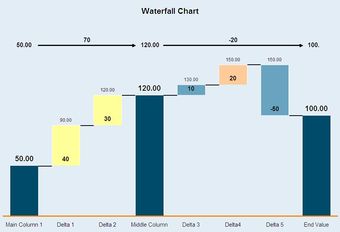
Using Visual Aids
A chart is an example of a visual aid that a speaker can use during a speech.
It also explores the idea that a visual message accompanying text has a greater power to inform, educate, or persuade a person or audience. One way to make your presentation vivid and memorable is through the use of visual aids. Although computer generated and projected visual—and presentation—aids are commonly used, it is still important to understand how to use them or any other type of visual aids in your presentation.
There are many different types of visual aids. The type of visual aid a speaker uses depends on his preference and the information he is trying to present. In order to determine the type of visual aid to use, begin by writing your outline first, focusing on the main points of your presentation and taking into consideration your audience and any cultural contexts. Select visual aids that are appropriate to the point that you wish to illustrate or clarify. Visual aids should support, clarify, and amplify, not repeat what you are saying. In order to make sure that the intent of your visual aid is clear, try to use only important or memorable words or phrases. For example, eliminate any unnecessary word slides or overcrowding of visual aids. Pictorial slides and appropriate color usage have the biggest impact.
It is important to consider if your visual aid can be seen and understood by the member of your audience who is farthest from the screen when choosing to use it. In order to do this, test out your visual aids in different environments. Practice with your visual aid when going through your presentation for timing and familiarity. Try to avoid beginning or ending your presentation with a visual aid unless it is key in opening your presentation or making a significant point. Introduce visual aids so that they blend smoothly with your speech and highlight your main points or provide clarity to examples. It is important to maintain eye contact; talk to your audience, not the visual aid throughout your presentation. Practice going through your presentation and coordinating your points with your visual aids when discussing them. Avoid passing hard copies of your visual aids around to the audience as it is often a distraction. Do try to provide interactive aspects into your visual aids that involve the audience such as polls, feedback requests, and interactive activities.
Here are some examples of visual aids:
- Photographs
- Drawings or diagrams
- Graphs
- Display charts
- Video excerpts
16.1.3: The Importance of Preparation
Preparing and understanding your visual aids is essential to improving the engagement, understanding, and memory of your audience.
Learning Objective
Indicate what factors speakers should consider when selecting and preparing visual aids
Key Points
- In preparing your visual aids, you should consider three important components: Are your visual aids appropriate for your audience? Are your visual aids easy to understand and easy to read or view? Do you know what is on your visual aids and can you present them effectively?
- When creating a visual aid, make sure to consider the knowledge base, demographic background, occupation, and values of your audience.
- Be sure to use text that is large enough (size 16 point font is a suggested minimum) and colors that do not conflict with one another. This ensures that words are legible.
- An essential component of using visual aids effectively is to prepare yourself in understanding what is on them and determining how you want to explain them.
Key Term
- demographic
-
A characteristic used to classify people for statistical purposes, such as age, race, or gender.
Example
- Make sure to consider the knowledge base, demographic background, occupation, and values of your audience when creating a visual aid. For example, you may not want to use examples and images that one generation or age group may not understand.
Appropriate preparation of your visual aids is essential in making sure that they are effective in helping to improve the engagement, memory, and comprehension of your audience. In preparing your visual aids, you should consider three important components:
- Are your visual aids appropriate for your audience?
- Are your visual aids easy to understand and easy to read or view?
- Do you know what is on your visual aids and can you present them effectively?
Are your visual aids appropriate for your audience?
Once your topic has been decided upon and your research is underway, it’s time to think about how you plan to present your information in visual aids. Of the several angles that need to be addressed in regards to delivering a speech, the most important thing to keep in mind is, “Who is my audience? ” Never underestimate the importance of knowing your audience. If your audience can’t understand your visuals, you’ll find it much harder to accomplish your objective.
Make sure to consider the knowledge base, demographic background, occupation, and values of your audience when creating a visual aid. For example, you may not want to use examples and images that one generation or age group may not understand. Your decision to use visual aids such as PowerPoint, charts, or any kind of demonstrative props will have a sizable impact on your audience, so they should be given careful thought.
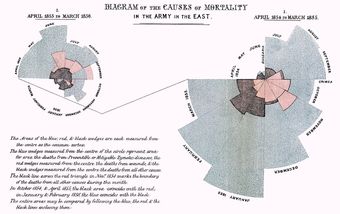
Choosing Visual Aids
The speaker should carefully select visual aids that are relevant to the topic and the audience.
Are your visual aids easy to understand and easy to read or view?
When you are preparing your visual aids, you should make sure that your audience will be able to read and understand what they are saying. Be sure to use text that is large enough (size 16 point font is a suggested minimum) and colors that do not conflict with one another. This ensures that words are legible. Make sure that any photos, charts, and diagrams are easily understood within the first few seconds of looking at them. If they are not easily understood, be sure to spend time during your presentation explaining what the photos or charts mean.
Additionally, one way to make sure that people in the back of the presentation can read your visual aids is to print off a full page slide of your presentation, place it on the floor and stand up and see if you can read the entire slide. If you cannot read it, people in the back of the room during your presentation will also likely not be able to read your slide. One other consideration is to be sure that you are comfortable using any technology that you will use to assist the presentation of your visual aids. You must also make sure that the location of your presentation has this working technology available to you.
Do you know what is on your visual aids and can you present them effectively?
An essential component of using visual aids effectively is to prepare yourself in understanding what is on them and determining how you want to explain them. If you are using pictures, graphs, or charts to help you explain a point, be sure that you understand the graph or picture and you are comfortable explaining this to an audience. If you are confused about a graph during your presentation, or do not do an adequate job of explaining a graph, your audience will also likely be confused about the graph as well. Such confusion will detract from audience engagement and comprehension.
Before you present, go through your graph, charts, and pictures. In your notes, write where each visual aid is presented in your presentation, what they mean, and how you plan to present them. Be sure to rehearse this before your presentation so your visual aids can be as effective in helping your audience be engaged, understand your presentation, and remember your key points.
16.2: Types of Sensory Enhancements
16.2.1: Physical Objects and Animations
Physical and animate objects can help to integrate the verbal and visual elements of a presentation into one unified message.
Learning Objective
Indicate when using physical and animate objects is appropriate in presentations
Key Points
- Choosing the appropriate object for a presentation depends on the speaker’s preference, as well as the content and setting of the presentation.
- Ultimately, objects should enhance rather than detract from a presentation.
- Using physical objects is often necessary when demonstrating how to do something so that the audience can fully understand the procedure or process.
Key Terms
- LCD
-
A flat panel display, electronic visual display, or video display that uses the light modulating properties of liquid crystals. Liquid crystals do not emit light directly.
- prop
-
An item placed on a stage or set to create a scene or scenario in which actors perform. Contraction of “property”.
Physical and Animate Objects
In today’s media-driven world, public speakers have a plethora of visual aids to choose from when augmenting their presentations. From LCD projections to flip charts, visual aids help presenters inform and persuade audiences, as well as help them understand the presentation topic. Physical and animate objects can also help integrate the verbal and visual elements of the speaker’s presentation into one unified and memorable message.

Using Objects
Physical and animate objects can help audiences better understand the topics being presented.
Objects as Visual Aids
Ultimately, objects should enhance rather than detract from a presentation. The use of objects as visual aids involves using actual objects as live demonstrations or props for the audience. For example, a speech about tying knots would be more effective by bringing a rope. Using physical objects is often necessary when demonstrating how to do something so that the audience can fully understand the procedure or process.
The use of physical and animate objects in formal presentations is the same as in stage acting where actors use still and animated props. For the objects to be as effective as possible, they must be positioned in a way where they are quickly detected and easily understood by the audience. A common mistake involves placing an object where it is obstructed or hidden from view, or in front of a more interesting object that divides the audience’s attention. Speakers must also be cognizant of objects that are too large or inconvenient for stage use.
Choosing Objects for Presentations
There are many physical and animate objects available for presentations. Choosing the appropriate visual aids depends on the speaker’s preference, as well as the content and setting of the presentation. Objects can be both beneficial or distracting during speeches. Therefore, presenters should prepare and plan ahead accordingly to ensure that objects are appropriate for the audience and material being presented.
16.2.2: Chalkboards, Flip Charts, and Transparencies
Visual aids including chalkboards, flipcharts, and transparencies help presenters weave words and images together into a cohesive message.
Learning Objective
Distinguish between the use of chalkboards, dry boards, whiteboards and flipcharts during presentations
Key Points
- While chalkboards are typically used in academic settings, universities and organizations employ dry boards for presentations and record-keeping.
- Chalkboards, dry boards, and flipcharts allow for fast, simple and easy use by presenters who may not be familiar or comfortable with presentation software tools.
- Transparencies are used across a wide variety of organizations, allowing for easy note-taking and steady eye contact during presentations.
- Despite its heavy use in academia, transparencies are quickly becoming outdated and being replaced by computer-based presentation tools.
Key Term
- transparency
-
specifically, a transparent material with an image on it, that is viewable by shining light through it.
Chalkboards, Flipcharts, and Transparencies
Visual aids such as chalkboards, flipcharts, and transparencies are used by presenters to help weave their words and images together into a cohesive message. Using visual tools effectively during a presentation helps speakers appear prepared, professional, interesting, and credible. Writing tools and imagery also help audience members focus on and remember the presenter’s major points, as well as better understand the presenter’s argument.

Choosing Visual Aids
Modern chalkboards are often made with green slate stone so that the writing is easier to read.
Chalkboards: From School to the Workplace
Although we often think of chalkboards in academic or teaching settings, chalkboards (or dry boards) are also commonly used in business environments. Chalkboards are reusable writing surfaces where text and drawings are made using sticks of calcium sulfate or calcium carbonate known as chalk. Chalkboards were originally made of smooth, thin sheets of black or dark grey slate stone. Modern versions are often green because the color is considered easier for reading.
Organizations typically use dry boards, which use dry erase markers for easy application and removal. These boards can be used for presentations, as well as advertisements or record-keeping.
In presentations, chalkboards and dry boards provide significant flexibility for recording audience responses and jumpstarting discussions. This spontaneity allows for fast, simple and easy use by presenters who may not be familiar or comfortable with presentation software tools.
On the other hand, writing on a chalkboard or dry board can delay presentations. Presenters may be tempted to speak to the board instead of the audience. Also, the chalkboard’s size limits visibility for large groups. Presenters with poor spelling or illegible handwriting can also pose problems for audience members.
Flipcharts in Presentations
Like chalkboards and dry boards, flipcharts have a low learning curve, allowing anyone with the ability to write to quickly convey information to audience members. Flipcharts are typically stationary items consisting of pads of large paper sheets fixed to the upper edge of a whiteboard. These are typically supported on a tripod or four-legged easel. Invented by Peter Kent, who built one to help him in a presentation, flipcharts are commonly used for presentations.
Flipcharts come in various forms, including:
- Stand-alone flipcharts
- Metallic tripod (or easel) stands
- Metallic mounts on wheels
Recently, scientists have developed a digital self-writing flipchart which writes word-for-word everything it is instructed to record. Self-heightening flipcharts such as the POGO system are also being introduced into public use. However, traditional flipcharts where text is usually hand-written with marker pens are still widely used in organizations.
Transparencies in Business, Academia, and the Church
In today’s information age, digital presentations and slideshows are by far some of the most widely used visual aids in public speaking. However, transparencies are still used by a variety of organizations. A transparency, also known in industrial settings as a “viewfoil” or “foil”, is a thin sheet of transparent flexible material, typically cellulose acetate, onto which figures can be drawn. These are then placed on an overhead projector to display to an audience.
Many companies and small organizations use a system of projectors and transparencies in meetings and other groupings of people; though this system is being largely replaced by LCD projectors and interactive whiteboards. In academia, mathematics and history classes traditionally used transparencies to illustrate a point or problem. Math classes in particular used a roll of acetate to illustrate sufficiently long problems and create illustrations that were difficult to do on computers due to a lack of math symbols on standard computer keyboards.
Nevertheless, more colleges are switching to digital projectors and PowerPoint presentations. In churches and other religious organizations, religious leaders used transparencies to show sermon outlines and illustrate certain topics such as Old Testament battles and Jewish artifacts during worship services.
While transparencies allow presenters to maintain eye contact with the audience, and multitask (e.g. take notes), they often appear plain looking with no motion or sound. Moreover, transparencies must be shown in dim lighting, which may potentially cause visibility problems for viewers. As a result, overhead projectors are quickly becoming outdated and being replaced by computer-based presentation tools.
16.2.3: Static Representations: Images, Drawings, and Graphs
Physical cues such as images can help to reinforce a speaker’s message.
Learning Objective
Discuss the appropriate placement of images, graphs, and drawings in presentations
Key Points
- Static imagery can either serve as a useful visual tool to further emphasize or support a speaker’s point, or confuse audiences and detract from the speaker’s message.
- Photographs, maps, and handouts are all examples of visual aids that employ static imagery.
- Bar graphs, line graphs, and other types of graphs are used in both static and electronic presentations to visualize relationships between different quantities.
- Drawings or diagrams can be used when photographs do not show exactly what the speaker wants to show or explain.
Key Term
- typography
-
The appearance and style of typeset matter.
Static Presentations: Images, Drawings, and Graphs
Visual communication, as the name suggests, conveys ideas and information in forms that can be read or looked upon. Audiences partially rely on vision to receive a speaker’s message, using physical cues, signs, typography, drawing, graphic design, illustration, color, and electronic resources. Public speakers often employ a variety of presentation tools—including drawings, paintings, and graphs—to inform, educate or persuade a person or audience. Although static in nature, non-electronic imagery has both advantages and disadvantages when used as visual aids in presentations.

Drawings
Drawings can be used in place of complex or detailed photographs.
The Many Uses of Images in Presentations
Images can be any two-dimensional figure such as a map, a graph, a pie chart, or an abstract painting. In this wider sense, images can also be rendered manually (e.g., by drawing, painting, carving) or automatically (e.g., by printing, computer graphics technology). Static images such as photographs, paintings, and illustrations can serve as useful visual tools to further emphasize or support a speaker’s point. However, if the images appear unrealistic, too small, or confusing, they can hinder the presentation and dilute the speaker’s message.
Examples of static images used in presentations include:
Photographs – Photographs are helpful tools to make or emphasize a point, or to explain a topic when the actual object cannot be viewed. For example, photographs are particularly useful for displaying historical places and sites that no longer exist.
Maps – Maps show geographical areas of interest. They are often used as aids when speaking of differences between geographical areas or showing the location of something.
Handouts – Charts, graphs, pictures, illustrations, and other images can be printed on handouts for distribution before, during, or after a presentation. An important aspect of the use of a handout is that a person can keep the handout long after the presentation is over. This helps the person better remember what was discussed.
Graphs and Data
Graphs are used in both static and electronic presentations to visualize relationships between different quantities. Various types of graphs are used as visual aids, including bar graphs, line graphs, pie graphs, and scatter plots. Graphs are particularly helpful for visualizing statistics that might be overlooked if just presented verbally. However, it is graphs’ complexity—detailed calculations, complex data and large figures—that cause them to become cluttered during use in a speech. Graphs often include too much detail, overwhelming the audience and making the graph ineffective.
Drawings in Presentations
Drawings or diagrams can be used when photographs do not show exactly what the speaker wants to show or explain. It could also be used when a photograph is too detailed. For example, a drawing or diagram of the circulatory system throughout the body is a lot more effective than a picture of a cadaver showing the circulatory system.
Nevertheless, talent and skills are usually needed for professional drawings that require significant detail or realism. If not done correctly, drawings can look sloppy, be ineffective, and appear unprofessional.
16.2.4: Dynamic Representations: Video and Multimedia
For speakers, multimedia allows dynamic customization and increased chances for audience engagement during presentations.
Learning Objective
Illustrate how multimedia tools can enhance audiences’ experience
Key Points
- Presenters may use navigation devices such as text links, picture thumbnails, or miniature screenshots to move around spontaneously within and between large collections of interconnected content.
- Although studies have revealed that audiences are more engaged during presentations that employ dynamic elements, there have been no assessments as to whether using multimedia improves learning and retention of presentation material.
- Multimedia such as video enhances the experience of the audience member, and can help presenters convey information more easily and quickly than static presentations.
- Integrating multimedia with online applications and hardware elements can ease the job of presenters by adding emphasis and bringing attention to specific points in the presentation.
Key Term
- multimedia
-
The use of different media to convey information; text together with audio, graphics and animation, often packaged on CD-ROM with links to the Internet.
Dynamic Representations: Video and Multimedia
Presenters may use navigation devices such as text links, picture thumbnails, or miniature screenshots to move around spontaneously within and between large collections of interconnected content. Using these relational presentation techniques allows presenters to interact with rather than “talk at” audiences .

Multimedia in Presentations
Presenters often use multimedia in presentations to make the content more engaging for audiences.
Audience Reception of Dynamic Content
Although studies have revealed that audiences are more engaged during presentations that employ dynamic elements, there have been no assessments as to whether using multimedia improves learning and retention of presentation material. Regardless of whether speakers use static or dynamic content, all presentations must present consistent and compelling information within a limited time frame. The various formats of technological or digital multimedia available to presenters may be intended to enhance the users’ experience, quickly and easily convey information, or transcend everyday experiences.
Software Presentation Programs
Presentation software programs provide public speakers with the ability to display video, photography, and other dynamic content in slideshow formats suitable for small and large audiences. For example, Apple’s iPhoto allows groups of digital photos to be displayed in a slideshow with options including transitions, looping functions, and the integration of music and digital photos. Zooming presentation programs such as Prezi present content on one infinite canvas. This allows for non-linear presentations where presenters can present richer detail of content, as well as provide a better overview and understanding of complex visual messages and relations.
Multimedia Tools in Presentation Software
Many presentation programs come with pre-designed images (clip art) and/or have the ability to import graphic images. Some tools also have the ability to search and import images from Flickr or Google directly from the tool. Custom graphics can also be created in other programs such as Adobe Photoshop or Adobe Illustrator and then exported.
Similar to programming extensions for an operating system or web browser, plugins for presentation programs can be used to enhance their capabilities. For example, it would be useful to export a PowerPoint presentation as a PDF document. This would make delivery through removable media or sharing over the Internet easier. Since PDF files are designed to be shared regardless of the platform, this format would allow presentations to be more widely accessible.
Certain presentation programs also offer an interactive, integrated hardware element designed to engage an audience (e.g., audience response systems) or facilitate presentations across different geographical locations (e.g., web conferencing). Integrated hardware devices such as laser pointers and interactive whiteboards can ease the job of the presenter by adding emphasis and bringing attention to specific points in the presentation.
16.2.5: Slideshows
A slideshow is an on-screen presentation of information and/or ideas presented using overhead projectors, photos, or presentation software.
Learning Objective
Explain how slideshows are used for personal and business purposes
Key Points
- Presentation software is most commonly used for instructional purposes, usually with the intention of creating a dynamic, audiovisual presentation.
- Before the introduction of motion pictures and computer software, slides originally were projected onto a theater screen via magic lanterns.
- In addition to business presentations, slideshows are used to provide dynamic imagery for museum presentations and installation art, and for saving personal memories as digital photo albums.
Key Terms
- annotation
-
The process of writing comments or commentary.
- phenomenological
-
Using the method of phenomenology, by which the observer examines the data without trying to provide an explanation of them.
- magic lantern
-
An early form of slide projector that could achieve simple animation by moving and merging images.
Slideshows
A slideshow is an on-screen presentation of information and/or ideas presented on slides. Since the late 1960s, visual artists in museums and galleries have used slideshows as a device for presenting specific information about an action or research, or as a phenomenological form in itself. Before the advent of motion pictures, slides originally were projected onto a theater screen by magic lanterns. This practice later evolved into moving picture shows .

Building a Slideshow
Consumers can use online programs such as Flickr to assemble photo slideshows.
Even after the introduction of motion pictures, slides continued to be used between film showings to advertise for local businesses or advise on theater decorum—for example, by requesting that gentlemen remove their hats and refrain from smoking, and urging mothers to remove crying infants from the auditorium.
Slideshows were later conducted using apparatuses such as a carousel slide or overhead projector. Most recently, modern slideshows are commonly assembled using presentation software such as Microsoft PowerPoint or Prezi.
Personal and Business Uses
Presentation software is most commonly used for instructional purposes, usually with the intention of creating a dynamic, audiovisual presentation. The relevant points and imagery of the entire presentation are placed on slides and accompanied by a spoken monologue. The old adage “a picture is worth a thousand words” holds true, in that a single image can save a presenter from speaking a paragraph of descriptive details. As with any public speaking or lecturing, a certain amount of talent, experience, and rehearsal is required to make a successful slideshow presentation.
Slideshows have artistic uses as well. They are often used to provide dynamic imagery for museum presentations and installation art. Consumer uses of slideshows include personal screensavers, and digital photo slides for display. Vendors or consumers can custom make slideshows using their using photos, music, wedding invitations, birth announcements, or other digital files. The slideshows are typically placed onto DVDs, converted into HD video format, or saved in an executable file for computer use. Ultimately, photo slideshow software—coupled with digital cameras and computer technology—has made it easier to create photo slideshows, eliminating the need for expensive color reversal film.
Common Slideshow Features
Photo slideshow software often provides a wide range of editing features. For example, users can add transitions, pan and zoom effects, video clips, background music, narrations, and captions.
Slideshows created using presentation software result in a file sometimes referred to as a “slide deck” or simply a “deck” in business settings. Some key features useful in desktop or cloud-based presentation software include screen capturing, image editing and annotation tools, and slide transition and text effects.
Web-based slideshows are slideshows that can be viewed or presented using a web browser. Some web-based slideshows are generated from presentation software, but may be difficult to modify. Others offer templates where slideshows can be easily edited and changed. Web-based slideshows are typically generated or authored in HTML, JavaScript, and CSS code (files). However, compared with desktop presentation programs, web-based slideshows are usually limited in features.
16.3: Preparing Sensory Enhancements
16.3.1: The Do’s of Using Sensory Enhancements
Using sensory enhancements correctly will make your presentation come to life.
Learning Objective
Discuss the best practices of using text, video, sound, graphics and animation in presentations
Key Points
- During your presentation, your audience will see you and your visual aids.
- It is important to pay attention to the quality of the text as well as what is actually said.
- Learners are attracted to colors and may find programs without color to be boring.
- Video is a great attention grabber but may distract the audience from more important information.
Key Terms
- color-blind
-
Of a person or animal, unable to distinguish between two or more primary colors (usually red and green).
- animation
-
The technique of making inanimate objects or drawings appear to move in motion pictures or computer graphics.
Introduction
When you give a presentation, you are truly alive, as being on stage activates all of your senses. You see your audience waiting to receive your wisdom. You hear the noise they make as they shift in their places. You smell the scent of success that accompanies a job well done. You taste the nervousness bubbling in your gut. You feel your heart beating faster, your legs shaking.
Shouldn’t your presentation make your audience come alive, too?
Sight
During your presentation, your audience will see you and any visual aids you may include.
You
The audience is going to have to look at you throughout the the entire presentation. You want to keep them engaged by:
- Dressing in a way that suits your personality (Could you imagine Steve Jobs giving a presentation wearing a suit and tie? )
- Wearing colors that suit the setting and appeal to the audience
- Showing confidence through your body movements (Even when Steve Jobs was speaking about iPhone 4 “defects,” you knew that he was in control)
- Using gestures that go with your message
Text
Some useful suggestions for using text as a video presentation are:
- Text should be read from left to right, top to bottom
- Use consistent indentation and spacing
- End sentences or paragraphs on the same display screen
Text Quality
According to Alessi and Trollip (2001), the five important factors that should be used in determining the quality of text are:
- Leanness: Say the bare minimum
- Transitions: Should be used when moving from one topic to another to facilitate the flow of ideas
- Clarity: Use language that is comprehensible by your target audience as well as consistent words for defining terms
- Reading level: Ensure that the reading level is suitable to the learners intended to use it
- Mechanics: Always remember to correct grammar, spelling and punctuation
Color
Color should draw attention to the important terms or concepts in your presentation. Color should be consistently used throughout the design of the presentation. Learners are more attracted to colors and may find programs without color to be boring.

Power of Color
Using color in a presentation catches the audience’s attention and highlights important facts.
One of the disadvantages of using color is that color-blind individuals may miss out on some information in certain colors.
Useful suggestions for using color:
- Be consistent with use of colors
- Use color to indicate a difference or change
- Try to keep color use to a minimum
- Make sure that there is a good contrast between the background and the color of the text to allow the audience to read it easily
Video
Video is a great attention grabber, but may distract the audience from more important information.
Here are some useful suggestions for using video:
- Use video to emphasize important information
- Pay careful attention to where video is placed in the presentation
- Make sure the length of the video is appropriate
- Ensure that you have control over the video as far as pausing, ending and repeating
Sound
Your voice can serve as a sensory enhancement. To make it effective:
- Add variety to your tone
- Speak loudly and clearly
- Use proper enunciation and pronunciation
If you use sound other than your own voice:
- Use sound as an attention grabber if it makes sense to do so
- Use high quality sound
Graphics and Animation
Graphics and animation should enhance the presentation.
Useful suggestions for using graphics and animation:
- Use graphics that are consistent throughout presentation
- Sometimes less is better
- Decide if a realistic picture is necessary or not
- Some graphics may need to be broken into smaller pictures
- When using text and graphics, present both simultaneously
An effective presentation or speech will touch your audience; an alive audience is likely to take action.
16.3.2: The Don’ts of Using Sensory Enhancements
Using visuals in presentations is a good way to make sure people remember them, but it is important to do so in the proper manner.
Learning Objective
Identify the common missteps presenters make when using sensory enhancements in presentations
Key Points
- According to research carried out at UCLA, a visual presentation is five times more likely to be remembered after three days than a presentation using bullet points.
- When using objects in a presentation, set aside time for the audience to examine the object so it doesn’t detract from the speech.
- If using audio to enhance a speech, make sure it is loud enough to be heard without distracting the audience.
- Be careful with scents in a presentation, so as not to offend or distract the audience.
- A presentation with sensory enhancements should be practiced, so you can make sure that any problems are rectified ahead of time.
Key Terms
- acoustics
-
The physical quality of a space for performing music.
- clip art
-
A set of images, distributed as files with other software, that may be copied and pasted into documents or other files.
Don’ts of Using Sensory Enhancements
If sensory enhancements aren’t used properly, they can detract or distract from a presentation.

Awakening the Senses
Sensory enhancements are good in presentations, but they can be a distraction if they aren’t used correctly.
Visual Missteps
The famous psychologist Albert Mehrabian showed that the way people take in information during a presentation is 55% visual, compared to 38% vocal and only 7% through text. Yet simply adding a few visuals into a presentation may not be the solution. There are a number of traps that people fall into.
- Using Bullet Points: According to research carried out at UCLA, a visual presentation is five times more likely to be remembered after three days than a presentation using bullet points.
- Corny Images: These often have actors showing emotions such as surprise or happiness. The difficulty is that they can look very corny. Additionally, if the photos are a few years old, the fashions can look very dated.
- Using Clip Art: An idea behind its time. Clip Art used to be a great way of making a presentation visual—particularly when computers were less powerful and every presentation had be small enough to fit onto a floppy disk. The problem now is that clip art looks very dated compared to a color photograph.
- Grainy Pictures: Generally these images are taken from a web page and increased in size. The problem is that, since they were saved as small files to make them load quickly, they do not enlarge well .
- Copyright Theft: It’s easy and tempting to just lift an image off the web, but you must obtain the permission of the copyright owner before you can use any image.
- Images Purely for Decoration: A picture is worth a thousand words. So why would you slap down any old image just to fill up a bit of space? Instead of an image showing how their products could suit a wide range of businesses, their graphic design agency had added a picture of a horse! Relevance is everything.
- Long Video Clips: It can be helpful to add a video clip into a visual presentation, but be aware that an audience’s attention will dwindle if the clip is too long.
Audio Missteps
If you are going to use sound in a presentation, make sure that it is appropriate to the setting and subject matter. Don’t have the audio so loud that people can’t hear the speech properly or that it distracts the audience from your speech. You should also make sure that it isn’t so soft that it can’t be heard properly by everyone in the room.
Touch Missteps
If you bring objects for the audience to touch and examine during the presentation, you will want to bring more than one item so that you can have the objects pass around the venue quickly. You’ll also want to schedule a period of time during your speech for the examination, otherwise people will be paying more attention to the object and miss important elements of the speech.
Sense Missteps
Some people are sensitive to smells, so if you are including this aspect into your presentation, make sure the scent isn’t too strong or cloying. You want to be able to enhance your speech without distracting or offending your audience.
The Important of Preparation
Preparation is the most important part of sensory enhancements. Make sure that you practice your presentation in the same room in which it will be delivered. Check acoustics, visibility, and the ability to deliver objects and scents in the room without distraction. Have people listen and experience your presentation beforehand, so you can adjust any mistakes before the final presentation and ensure that your speech goes as smoothly as possible.
16.3.3: Design Tips
Designing an effective and engaging presentation in PowerPoint or other presentation program requires simple graphics, fonts, and structure.
Learning Objective
State the design best practices that should be incorporated into PowerPoint presentations
Key Points
- Do not write your entire presentation on your PowerPoint. Rather, use bullets and sub-bullets to break up the text into manageable, easy-to-read chunks.
- Be consistent with your color themes.
- Use at least 18-point font for main points and smaller font sizes for sub-points.
- Use a font color that is readable and stands out against the background.
- Use graphics.
Key Terms
- PowerPoint
-
(noun) an electronic slide presentation created and presented using the program (verb) to communicate to (an audience) by electronic slides
- design
-
To plan and carry out (a picture, work of art, construction etc. ).
Introduction
Let’s face it. Love it or hate it, PowerPoint, or PowerPoint type slides, are the most common form of visual aid seen during a presentation. We all know that we have encountered boring power points presentations with an overload of information and lack of creativity. Developed by Microsoft, PowerPoint is a presentation software that enables users to communicate text, graphics, video, and other content via electronic slides.
The following design tips can help users develop effective PowerPoint presentations, while keeping in mind PowerPoint etiquette.

PowerPoint Presentation
Using software, like PowerPoint, allows the speaker to create an engaging presentation.
PowerPoint Tips
- Do not write the entire presentation on your PowerPoint. Instead, create bullet points and headings no longer than three to five words that give the main points.
- Present no more than five to seven lines per slide.
- Use two slides rather than cramming too much information into one.
- Be consistent with your “theme” throughout the presentation (i.e., do not use a different theme for each slide).
- Do not overuse transitions. They are meant to enhance, not overwhelm your presentation.
- Be careful with your color scheme. Again, this is meant to enhance your presentation. Make sure the audience can read the text.
- Make an outline of what you will be talking about so listeners can know what to expect from the presentation.
- Use at least an 18-point font for main points and a smaller sized font for sub-points. Avoid using complicated and unreadable font.
- Use a font color that stands out against the background.
Easy-to-Read Text and Graphics
Use graphics! People identify items more quickly with images rather than just text alone. When creating your visual aids, however, make sure your text and graphics are readable.
Labeling
- Use headlines and sub-headlines in a larger font.
- Bold, italicize, or CAPITALIZE important information.
- Use bullet points or create lists to organize material. Make sure this is “nice” to look at (i.e., easy-to-read).
Charts and graphs
- Make sure the information is clear and supports your presentation. Color coordinate charts/graphs if necessary.
- Use text to support/explain your charts and graphs (be brief but cover the high points).
- Avoid charts and graphs that can be misleading to your readers.
Wording and Lettering
- Use large, easy-to-read fonts.
- Be concise, using as little text as possible. Also use simple language to avoid confusion.
- Limit your text to one or two fonts.
- Think of the demographic (e.g., age) of your audience when setting font size and type.
- Minimize the number of lines to no more than six lines per slide with six words per line.
→Overcrowding slides is common and can be easily avoided by limiting the amount of text.
Color
- Use color for clarity and emphasis, not for decoration.
- Use color schemes.
- Keep a similar color scheme throughout the entire presentation.
- Use contracting colors to highlight main points.
16.3.4: The Role of Color
When properly used color should draw attention to the important terms or concepts in your presentation.
Learning Objective
Describe how color can be used to enhance presentations
Key Points
- One of the disadvantages of using color is that individuals who are colorblind may miss out on some information in certain colors.
- Do not “waste” information by using unnecessary colors.
- It may also be useful to apply some color psychology when choosing which colors to use.
Key Term
- color-blind
-
Of a person or animal, unable to distinguish between two or more primary colors (usually red and green).
Introduction
When properly used color should draw attention to the important terms or concepts in your presentation. They can also create emotion. Color should be consistently used throughout the design of the visuals to achieve these goals.
Learners and audiences are more attracted to colors and may find presentations without color to be boring. Some presenters change up their color schemes regularly to prevent their presentations from becoming too monotonous. You can also change the shades of your colors.

Using Color Effectively
Color can be used in a presentation to get the audience’s attention.
One disadvantage of using color is that individuals who are color-blind may miss out on some information in certain colors. Using certain shades, and using them consistently, can eliminate this problem.
Useful Suggestions for Using Color
- Be consistent with the use of colors.
- Use color to highlight a difference or change.
- Try to keep color use to a minimum; each color should communicate necessary information.
- Make sure that there is a good contrast between the background and the color of the text to allow the learner to read the text easily.
- Use color for clarity and emphasis, not for decoration.
The Psychology of Colors
It may also be useful to apply some color psychology when choosing which colors to use. Basic internet research uncovers a whole host of analysis on the meanings of different colors.
Something else to consider is that on flip charts, blue, black, and green inks have the best visibility. People say that blue is the most pleasing color to view. Red comes in second, even though it is not the most visible. But too much red can be too strong. Avoid using purple, yellow, pink, and brown, which can be more difficult to see.
When creating graphs, bright colors will bring focus to a small graph while subtle colors will keep a large graph from overwhelming the audience.
16.4: Presenting with Sensory Enhancements
16.4.1: The Do’s of Using Visual Aids
Visual aids should be easily understood, aesthetically pleasing, easy to move, easily seen and heard, and act as a supplement to the speech.
Learning Objective
List best practices for presenting visual aids in a speech
Key Points
- Presentation aids must be easily understood by the audience. Graphic elements should be large enough to be easily seen and/or read.
- Presentation aids must be easy to transport. In addition, you should make sure you know to use presentation equipment ahead of time.
- The design of your presentation should not detract from the content of your speech.
- Consider whether you can understand if each visual aid is addressing and furthering the key point of your presentation.
- Visual aids are useful to help the audience better understand your topic if they are used as a supplement to your presentation.
Key Terms
- extraneous
-
Not essential or intrinsic.
- verbatim
-
A word-for-word report of a speech.
Visual aids are essential to helping your audience better understand the key points of your presentation. Visual aids will also help to improve the attention span of audience members during the presentation. However, it is important that presenters use visual aids in a manner that does not distract from the overall presentation. An effective visual aid will include the following attributes:
- Easily seen or heard by the audience
- Easily handled
- Aesthetically pleasing
- Easy to understand the key point
- Act as a supplement to the speaker’s message and not a replacement
Easily Seen or Heard by the Audience
Presentation aids must be easily understood by the audience, even those sitting at the very back of the room. Graphic elements in presentation aids must be large enough to be easily seen and/or read. Similarly, audio elements must be loud enough to hear.
Easily Handled
Your presentation aids should be easy to transport. In addition, you should make sure you know how to use presentation equipment ahead of time. You should seamlessly incorporate presentation aids into your speech. You don’t want your audience to be distracted by these elements.
Aesthetically Pleasing
Your visual aids should not detract from the content of your speech. Keep your presentation simple so people can focus on the content rather than the aesthetics. The decisions you make when you design your visual aids should be very deliberate. If you add color to a visual aid, for example, use it for a clear purpose.

PowerPoint Presentation
The
audience should be able to quickly understand the key point of each slide in a PowerPoint presentation.
Easy to Understand the Key Point
If your PowerPoint slides or handouts have too much extraneous information, then the audience may not be able to understand the takeaway message of the presentation. A way to test if your visual aids are addressing the key point is to ask someone who is unfamiliar with your presentation if they can understand what the key point is. If they cannot determine the key point, it may be a good idea to revise your visual aids to include less non-essential information.
Supplement not Replace, the Presentation
Visual aids are useful to help the audience better understand your topic if they are used as a supplement to, and not a replacement for, your presentation. For example, a visual aid that replaces a presentation could be a PowerPoint that includes big blocks of text that the presenter reads verbatim. While this will be an accurate presentation, it will likely bore the audience members who will not gain much from the presentation. However, if the visual aid acts as a supplement, it will enhance the audience member’s understanding through diagrams, graphs, charts, and summaries.
16.4.2: The Don’ts of Using Visual Aids
Some “don’ts” of visual aids include inconsistent themes, small fonts, too much information, and distracting noises and animation.
Learning Objective
Discuss the missteps presenters should avoid when using visual aids
Key Points
- If your visual aid has inconsistencies in color scheme or theme, the audience may become confused since color change may indicate a change in topic.
- Avoiding small font is essential to making sure that the audience can read your visual aids. A general standard is to make sure that all PowerPoint slides are at least 18-point font to ensure that audience members in the back row will be able to read your presentation.
- Try to keep the amount of information on each slide to a minimum and use only what is necessary to convey the key point of the visual aid or slide.
- Avoid distracting animation and noises. These will take the focus of the audience away from your presentation and shift it toward the noise or animation instead.
Key Term
- Detract
-
Take away the value of.
Visual aids can be effective at enhancing your presentation and helping the audience better understand the key points of your presentation. However, if visual aids do not help your message or are too confusing, they may actually detract from the presentation and hinder understanding. Some key “don’ts” of using visual aids include:
- Inconsistency in color scheme or theme
- Small or complicated font or overwhelming text or graphics
- Too much information or too many slides
- Distracting animation or noises
Inconsistency in Color Scheme or Theme
If your visual aid has inconsistencies in color scheme or theme, the audience may become confused since color change may indicate a change in topic. Consistency in theme and color will help coordinate all of the information in your presentation and will help the audience understand the topics in relation to one another. There are a number of default themes that Microsoft PowerPoint offers that can help unify your color scheme and theme.
Small or Complicated Font or Overwhelming Text and Graphics
Avoiding small font is essential to making sure that the audience can read your visual aids. A general standard is to make sure that all PowerPoint slides are at least 18-point font to ensure that audience members in the back row will be able to read your presentation. Additionally, you should avoid overwhelming text and graphics as they will distract from the main topics and points of your presentation.

Complicated Graphics
The speaker should avoid using complicated graphics in a presentation.
Too Much Information or Too Many Slides
Try to keep the amount of information on each slide to a minimum and use only what is necessary to convey the key point of the visual aid or slide. Additionally, try to keep the number of slides or visual aids in your presentation to a minimum. A rule of thumb is to use each slide in a PowerPoint for 30 seconds to a minute of your presentation. Remember that the majority of your presentation should come across in what you are speaking about rather than through the text on your visual aids.
Distracting Animation or Noises
Avoid distracting animation and noises. These will take the focus of the audience away from your presentation and shift it toward the noise or animation instead.
16.5: Using PowerPoint and Alternatives Successfully
16.5.1: The Advantages and Disadvantages of PowerPoint
PowerPoint is a quick and easy way to organize ideas and information, but can encourage the creation of presentations that lack substance.
Learning Objective
Name the advantages and disadvantages of using PowerPoint
Key Points
- PowerPoint is regarded as the most useful, accessible way to create and present visual aids; others believe it has its own mind-set which forces presenters to spend countless hours thinking in PowerPoint and developing slides.
- Advantage—easy to create colorful, attractive designs using the standard templates and themes; easy to modify compared to other visual aids, such as charts, and easy to drag and drop slides to re-order presentation.
- Advantage—easy to present and maintain eye contact with a large audience by simply advancing the slides with a keystroke, eliminating the need for handouts to follow the message.
- Disadvantage—speakers create slides so they have something to present rather than outlining, organizing, and focusing on their message.
- Disadvantage—the linear nature of PowerPoint slides forces the presenter to reduce complex subjects to a set of bullet items which are too weak to support decision-making or show the complexity of an issue.
- Disadvantage—basic equipment required to present. You will need to have a computer and projection equipment in place to display the slides to the audience.
Key Terms
- PowerPoint
-
(noun) an electronic slide presentation created and presented using the program (verb) to communicate to (an audience) by electronic slides
- bullet points
-
Bulleted items – known as bullet points – may be short phrases, single sentences, or of paragraph length; used to introduce items in a list.
Advantages and Disadvantages of PowerPoint
PowerPoint—Advantage or Disadvantage for the Presenter?
PowerPoint is the most popular presentation software. It is regarded by many as the most useful and accessible way to create and present visual aids to the audience.
On the other hand, others believe it has created its own mind-set which forces presenters to spend countless hours thinking in PowerPoint and developing slides. A political party has even formed to ban PowerPoint in Switzerland. Depending on one’s perspective, it seems that many advantages could easily be viewed as disadvantages.
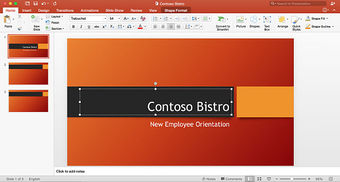
Using PowerPoint
When used correctly, PowerPoint is a helpful program for creating an engaging presentation.
Look over the list below to see where you stand—with or against PowerPoint.
Advantages
Design
- Quick and easy: the basic features are easy to master and can make you appear to be organized, even if you are not.
- Simple bullet points: it can reduce complicated messages to simple bullet points. Bullet points are a good basis for a presentation and remind the speaker of main points and the organization of the message.
- Easy to create a colorful, attractive design: using the standard templates and themes, you can create something visually appealing,even if you do not have much knowledge of basic graphic design principles .
- Easy to modify: when compared to other visual aids such as charts, posters, or objects, it is easy to modify.
- Easily re-order presentation: with a simple drag and drop or using key strokes, you can move slides to re-order the presentation.
Finally, PowerPoint is integrated with other products that allow you to include parts of documents, spread sheets, and graphics.
Delivery
- Audience Size: PowerPoint slides are generally easier to see by a large audience when projected than other visual aids.
- Easy to present: you can easily advance the slides in the presentation one after another with a simple key stroke while still maintaining eye contact with the audience.
- No need for Handouts: they look good visually and can be easily read if you have a projector and screen that is large enough for the entire room.
Disadvantages
Design
- Design power pointless: gives the illusion of content and coherence, when in fact there is really not much substance or connection between the different points on the slides.
- PowerPoint excess: some speakers create presentations so they have slides to present rather than outlining, organizing, and focusing on the message.
- Replaces planning and preparation: PowerPoint is a convenient prop for poor speakers, as it can reduce complicated messages to simple bullet points and elevates style over substance.
- Oversimplification of topic: the linear nature of PowerPoint forces the presenter to reduce complex subjects to a set of bullet items that are too weak to support decision-making or show the complexity of an issue.
- Feature abundance: while the basic features are easy to use and apply, a speaker can get carried away and try to use all the features at once rather than simply supporting a message. Too many flying letters, animations, and sound effects without seeing much original thought or analysis can be a real issue. In many cases, the medium shoves the message aside.
Delivery
- Basic equipment required: you will need to have a computer and projection equipment in place to display the slides to the audience.
- Focus on medium, not message: Too many people forget that they are making a presentation first and that PowerPoint is just a tool.
16.5.2: An Overview of PowerPoint
Microsoft PowerPoint is a computer software package that displays information in the form of a slide show.
Learning Objective
State the arguments for and against using PowerPoint as a visual aid
Key Points
- PowerPoint presentations consist of a number of individual pages or “slides,” with individual slides containing text, graphics, sound, video, or other objects that can be arranged by the presenter.
- A PowerPoint presentation can be automatically controlled by pre-programming transitions from one slide to another, or manually controlled by a user.
- Supporters of PowerPoint say the presentation software is easy to use and can save a lot of time for by replacing the need for a variety of different visual aids.
- Some opponents of PowerPoint argue that the program encourages the reduction of complex ideas into simplified points, while others contend that the program encourages overstuffing presentations with too much information, both of which negatively effect the audience’s experience.
Key Term
- PowerPoint
-
(noun) an electronic slide presentation created and presented using the program (verb) to communicate to (an audience) by electronic slides
An Overview of PowerPoint
PowerPoint is a presentation software program . A presentation program (also called a presentation graphics program) is a computer software package used to display information, normally in the form of a slide show. It typically includes three major functions: an editor that allows text to be inserted and formatted, a method for inserting and manipulating graphic images, and a slide-show system to display the content.

PowerPoint
PowerPoint software runs on Microsoft and Mac operating systems. It allows users to
create visual presentations comprised of individual slides.
Microsoft PowerPoint 9 is easy-to-use presentation software that runs on Microsoft Windows and Mac OS operating systems. PowerPoint is commonly used by business people and students to create slide show presentations. The ease of use is demonstrated by the fact that the program can be used by junior high and high school students. PowerPoint can accommodate a range of uses, with intermediate to more technical options. Microsoft estimates that thirty million presentations are made each day using the PowerPoint program. As of 2012, various versions of PowerPoint claim approximately 95% of the presentation software market share, having been installed on at least 1 billion computers.

PowerPoint Logo
With 95% market share, PowerPoint presentation software is one of the most widely used programs for developing visual presentations.
PowerPoint has almost become a generic term similar to Xerox or Coke or Google and is often used when one is referring to any computer supported presentation, thus demonstrating how ubiquitous the program has become.
The Use of Slides in PowerPoint Presentations
PowerPoint presentations are comprised of a number of individual pages, or “slides. ” The “slide” analogy is a reference to slide projectors. Unlike slide projectors however, which only projected static images, slides in PowerPoint are more dynamic. They can include text, graphics, sound, movies, and other objects, which can be arranged by the presenter. The PowerPoint presentation can be printed, displayed live on a computer, or navigated through at the command of the presenter. For larger audiences the computer display is often projected using projection equipment. The slides can also be used as the basis for a webcast.
After designing the individual slides for your presentation, you can control the presentation by pre-programming the transitions from one slide to another with the exact timing you want. Or, you can advance the slides manually as you speak about each.
Supporters and Critics
Supporters of the software say the PowerPoint can save people time by circumventing the need for other types of visual aids, such as hand-drawn or mechanically typeset slides, blackboards, whiteboards, or overhead projections. Because the software is easy to use, it encourages people to give presentations that contain visual aids who otherwise may not have even given a presentation.
PowerPoint does have its critics, and the benefits of the software are continually debated. Some critics of PowerPoint argue that condensing complex issues into simplified bullet points is detrimental, and compromises the quality of information provided to the audience. This view finds that audience do not receive enough detailed information to make informed decisions about presentation topics. Additionally, there are also some critics who say that rather than providing too little information, PowerPoint allows users to put too much information into presentations. This can lead to “death by PowerPoint,” which is a state of bordem or fatigue as a result of sitting through a presentation that contains too much information.
As is clear from the debate about its merits, PowerPoint can present many benefits and challenges to a user who develops a slideshow to accompany a speech or presentation.
16.5.3: The Elements of a Slide
PowerPoint is a multi-media platform that incorporates elements of written, audio, video, and graphical communication.
Learning Objective
Break down the elements that comprise a PowerPoint slide
Key Points
- The most basic element of a PowerPoint presentation is the slide.
- Slides are comprised of a combination of textual and visual elements.
- Text may be organized as captions, paragraphs, or bulleted points.
- Add graphics such as shapes, pictures stored on your computer, pictures retrieved online, and charts or tables from other programs such as Excel.
- To add video clips, search for them from within the PowerPoint platform using Bing, Flickr, and Youtube, and import them directly into a slide.
Key Term
- slide
-
A single page of a presentation, developed using a presentation program such as Microsoft PowerPoint. Collectively, a group of slides may be known as a slide deck or slide show.
Elements of a Slide
The basic element of the presentation is the slide. The new default aspect ratio of the slide is 16:9 for wide screens, but the previous aspect of 4:3 is still available. Some basic example elements used to compose a slide are as follows:
Titles and sub-titles: After first opening PowerPoint to start a new presentation using the Blank Presentation Template, the user can select a title and sub-title for the presentation, using one of a variety of fonts and colors.
Text: Users can enter the content as bullets on the slide along with a title for the slide. They can also select the font style, size, and content to support their message.
Shapes: PowerPoint can merge two shapes together to create a custom shape.
Pictures: Users can search for and insert their own photographs. Remember to re-size the photo to fit the slide.
Charts/Graphs: Create custom charts or move relevant charts from Excel spreadsheets.
Audio/Video Clips: Download videos, images, and audio files directly into a slide for a presentation without first downloading to the computer. Search for audio and video from within PowerPoint to find images using Bing or Flickr and videos on You Tube. After locating the desired supporting media, incorporate it into the slide. By default, the results show images that are licensed under Creative Common, so the images can be used in presentations without violating an owner’s copyright, but users can also view all results.
Transitions: Transitions move the presentation gracefully from one slide to the next or build the side dynamically. There are many standard transitions available, or users can program their own special effects to animate the movement of the sides.

PowerPoint Slide
PowerPoint allows users to create slides and add animation, transitions, and video and audio clips.
16.5.4: Formatting Tips
Formatting choices, including layout, font selection, transitions and use of space and color, are important components of a presentation.
Learning Objective
Give examples of how to best format a PowerPoint presentation
Key Points
- The blank template provides an initial format that allows a user to clearly distinguish main points from subpoints and supporting material.
- In the body of a slide, use keywords and phrases instead of sentences as listed bullet items to help the audience skim the slide and see relationships between main and sub-points.
- Insert and re-size visuals such as WordArt, shapes, charts, graphs, images, or pictures from your own computer or from the internet, into a slide to provide support for claims.
- Audio and video clips of a high quality not only clarify or provide support an idea, but also improve the quality of a presentation. Avoid videos with low resolution or poor quality audio clips, as they may affect audience perception.
- When using effects to transition from one slide to another, avoid slow moving or fancy effects such as crawl in, swivel and spiral. Don’t overuse special effects and keep transition choices consistent.
- After the Presentation – you can format and export your slides to a Word Document for handouts or share by email, pdf, or internet.
Key Term
- Placeholder
-
dotted or hatch-marked borders for entering text, charts, tables, or images on a slide.
PowerPoint Features
PowerPoint incorporates elements of written, oral, and visual communication. By focusing on decisions regarding blank space or color, contrast, and font, you can design a presentation that is not only aesthetically appealing, but also enhances and underscores key content and objectives. The following tips will help you and your audience get the most from your presentation.
Formatting the Slide
Templates: You may either select an existing template or design your own. The blank template allows you to modify colors, themes, and the style of different elements to best suit your needs.
Normal view – Blank Presentation template: The blank presentation template provides placeholders for title and sub-title on the first slide, and additional placeholders for the title on each blank slide. This allows you to distinguish your main points from sub-points. Follow basic design rules:
- Use blank space to group or separate items.
- Use visual balance to please the eye.
- Create contrast to make objects stand out. Contrast occurs when any two elements are different.
Colors: Choose colors so that text is clearly legible. In addition, consider how the colors will look in the space where the slideshow will be presented. For example:
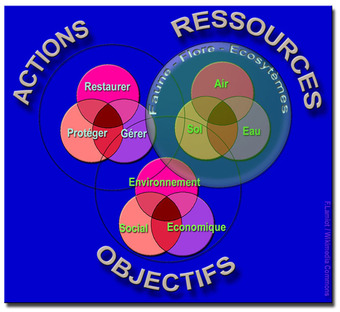
Picking Colors
In a presentation, there can be different colors and fonts, but all of the text must be easy to read for the audience.
- Strong light reduces contrast on dark background.
- In a well-lit room, use light background with dark text and visuals.
- In a dimly-lit room, use dark background with light text and visuals.
- Avoid vibrating colors. Bright complementary colors that are close to each other in intensity “vibrate” or reduce legibility.
Adding Content
Text: Use text properly.
- Use keywords and phrases instead of sentences.
- Be consistent in your use of capitalization.
- Put similar ideas in the same formatting by using the same parts of speech, same clauses, phrases, or all complete sentences.

Organization
On a slide, information can be organized using bullet points or lists.
- Use bullet points. Bullets help the audience skim the slide and see relationships between main and sub-points. Here is how to use bullets:
- Select the “bulleted list” or “two-column list” slide (from the pre-designed slide formats).
- Type a phrase then hit “return.”
- Type a second phrase, hit “return” then hit “tab” to indent.
- OR use “promote” or “demote” arrows at top to create a bulleted hierarchy, in order to distinguish main claims from subclaims.

Creating a Contrast
A speaker can create contrast in a presentation changing the font, color, or size.
Fonts: Choose easy-to-read fonts.
- Select fonts that are good for projecting, not ones that are just good for printing.
- Pay attention to the legibility of the font you choose, such as the contrast between background and text, size of the font, and any type treatment such as shadowing that may reduce legibility.
Graphics: Insert needed visuals such as WordArt, shapes, or images. Make sure to re-size the images to best fit the slide. Here is how to re-size images:
- Click on the visual you wish to resize.
- Go to “format” and then “object” or “autoshape.”
- Select “size.”
- Change size and scale.
- OR, simply click and drag the corners of the image.
- You can also combine two different shapes by selecting one and then selecting and dragging another into it for a custom image.
Video and Audio: You can search and select video in different media formats. Just click to select the video/audio and insert where you want them to play on the slide. You can also record your own audio to add to a slide. When choosing video or audio to add to your presentation, make sure that it is of a high quality. This enhances the authority of the presenter as well as improves audience receptivity.
Moving Between Slides
Effects and transitions: PowerPoint comes with a preset collection of transitions. You can choose different types of transitions to move between slides. Newer versions of PowerPoint even have some 3D transitions. In addition, there are many free transition templates available from Microsoft and open sources.
Effects between slides: Effects should have a point and support the overall concept of the presentation. Avoid slow moving or fancy effects such as crawl in, swivel, and spiral. Don’t overuse special effects as they can distract your audience from your main points. To avoid this from happening, keep effects and transitions consistent.
After the Presentation
Handouts: You can export your PowerPoint presentation to a Word Document. When you do this, there are different choices available for how slides and notes are positioned. In the latest version of PowerPoint you can go to File—-> Export and then click on the {Create Handouts} button. Your presentation will then be exported to a Word document for formatting.
Share: You can also share your PowerPoint presentation by email, through web access. or publish your slides so that others can access them electronically rather than having to distribute handouts.
16.5.5: Delivery Tips
PowerPoint presentation software is your assistant and should help you by supporting your presentation, not taking over the show.
Learning Objective
Illustrate how PowerPoint features can be used to communicate to audiences
Key Points
- Rehearse the show to see what it will really look like when it is presented to an audience; try controlling the movement from one slide to next or preprogramming the amount of time for each slide to appear on the screen.
- The content of the slides serves as a guide or outline for you and the audience, so you want to make sure you talk about each slide, not read the content to the audience who can read what is projected.
- Presenter View allows you to see your notes on your monitor while the audience only sees the slide. While you move from one slide to the next you can also zoom in on a particular part of the slide or use a pen or laser pointer to call attention to specific details.
- Relational presentation practitioners structure small message units that are rather self-contained and can be pulled together as the speaker interacts with the audience.
Key Terms
- Relational
-
A type of interactive presentation using presentation software that is structured to allow dynamic customization of the message while presenting.
- linear
-
Pertaining to or resembling a line; step-by-step in order.
PowerPoint Software Is Your Assistant
PowerPoint presentation software is your assistant and should help you, not take over the show. Nothing can substitute for a carefully prepared message, whether that message is a standard linear message or a relational interactive message. The delivery of the message is guided by the best practices that you have been using throughout your speeches; however, there are some special considerations when working with PowerPoint.
Practice and Rehearsal
After putting together a PowerPoint slide show, you will want to get a “reality check” by actually running the show to see what it will look like when you present it. You may control the movement from one slide to the next as you speak, or you may preprogram the amount of time that each slide appears on the screen and speak only for that amount of time.
If at all possible, rehearse with the same display equipment in a similar space. If you are speaking to a colocated audience, make sure that your projected slides are large enough for all members of the audience to see (usually about 1 inch high for each 10 feet that separates the audience from the projected slide). Additionally, if you are speaking to a remote audience, check your display so that you can see the presentation in the same way that the audience will see it on their screens.
Basic Delivery
One critical aspect of delivery is avoiding the temptation to read the content to the audience; the audience can read what is projected themselves. The content of the slides serves as a guide or outline for you and the audience. Stand to the left of the screen . For the English speaker who reads from left to right, the audience will see you as their eyes move across the screen in one continuous left to right eye movement. And remember to speak WITH the audience, not AT them .

Delivering a Speech
The speaker delivers the speech with assistance from PowerPoint slides in the background.
Using Views
Using PowerPoint Views allows you to follow a linear path or relational interactive paths for delivery.
Slide Show View
You can use the Slide Show view to deliver your presentation. The slide occupies the full screen and displays the way your presentation will look when you project it. You can use the Slide Show view to see the slide show on your computer screen one slide at a time. You can move to the next slide by clicking the mouse or using the up and down arrow keys.
Presenter View
You can see your notes on your monitor while the audience only sees the slide. You can also zoom in on a particular part of the slide or use a pen or laser pointer to call attention to details. In Presenter view, you can display the current slide on the left side, the next slide on the right, and the notes at the bottom right of the screen.
Interactive Relational Delivery
Relational presentation (also known as visually interactive presentation) uses standard presentation software such as PowerPoint in a way that allows for dynamic customization of messages while presenting.
Relational presentation practitioners structure their material using a combination of strategies to develop and access small message units. Each small message unit is rather self-contained and can be pulled together as the speaker interacts with the audience. While presenting, you interact with the audience rather than “talk at” them. You can use the Presenter view to quickly select and navigate to each message unit spontaneously within and between collections of interconnected shows. Some of these navigation devices use text links and others incorporate picture thumbnails or miniature screenshots as link sources.
Navigation in a Presentation
Whether you are delivering a traditional, linear message or an interactive, relational presentation, it is helpful to gain control of the basic movements for the slide show.
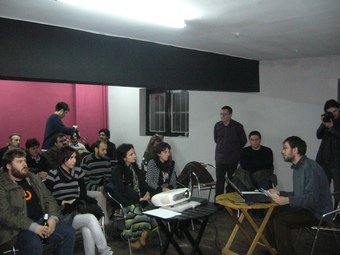
Interact with the Audience
It’s important that the speaker maintains eye contact with the audience while projecting the slides.
Move to the last slide: Drag the scroll box to the bottom of the scroll bar or press [Ctrl] and [End]
Move to the first slide: Drag the scroll box to the top of the scroll bar or press [Ctrl] and [Home]
Move to the next slide: Click in the scroll bar below the scroll box or press [Page Down]
Move to the previous slide: Click in the scroll bar above the scroll box or press [Page Up]
Move to a specific slide: Drag the scroll box up or down until you displays the slide you want
Delivery Wrap-Up
So to wrap it up, you should prepare your lecture before firing up your software. Remember that the technology is your assistant and should help you, not take over the show. You may creatively deliver a linear presentation, but you can also use PowerPoint to craft a highly interactive relationship experience with the audience.
16.5.6: Other Presentation Software Options
Microsoft PowerPoint dominates the presentation software market, but other options include Mind Maps, SlideRocket, and Prezi.
Learning Objective
Describe the different software programs available as an alternative to PowerPoint
Key Points
- Presentation software’s three major functions: an editor allowing text to be inserted and formatted; a method for inserting and manipulating graphic images; and a slide-show system to display the content.
- Mind Maps break away from the linear format by using graphic symbols to show connections between different ideas.
- SlideRocket is an online presentation platform that lets users create, manage, share and measure presentations.
- Prezi is a free, web- based application allowing users to create visual presentations by zooming in, out and around a visual work space.
- Google Docs is a free SaaS part of Google Drive, and includes its own presentation software.
- There is a move at present away from traditional presentation software towards mobile-friendly solutions developed for tablets and smartphones such as Haiku Deck or Explain Everywhere.
Key Term
- Presentation Software
-
A computer software package used to display information; typically includes text editor, method for inserting and manipulating graphic images and a slide show system to display content
Alternatives to PowerPoint Presentation Software
Presentation software is a computer software package used to display information, normally in the form of a slide show. The software typically includes three major functions:
- an editor that allows text to be inserted and formatted;
- a method for inserting and manipulating graphic images, and;
- a slide-show system to display the content.
Microsoft PowerPoint dominates the market with 95% of the presentation software market share. However, there are other presentation graphic programs with different features and approaches. Some of the alternatives to PowerPoint include:
Mind Maps You can use mind maps to plan and modify your presentation. Mind Maps break away from the linear format of PowerPoint by using graphic symbols to show connections between different ideas, allowing the presenter to show a top level map and then drill down to show details for different connecting ideas. For presentation slides, you can start with a general, top level map and then create additional slides to drill down to the subtopics. You can summarize the sub points and then go back to the main, top-level mind map to show the connection to the whole.
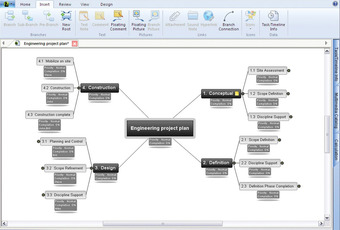
Mind Map Software
A graphic and conceptual layout that can be used for non-linear presentation.
SlideRocket is an online presentation platform that lets users create, manage, share and measure presentations. SlideRocket is provided via a monthly SaaS model or an annual subscription plan. You can also import your PowerPoint presentations or Google Presenter presentations into SlideRocket.
Users initially sign up for a free 14-day trial then decide which plan to subscribe to. Users can also use a free, basic version of the software. In addition, SlideRocket premiered the presentation resume with a variety of templates for users to promote themselves to different companies.
Prezi is a free application which allows you to create visual presentations by zooming in, out and around your visual workspace.Instead of individual slides, these ZUI’s (zoom user interface) are based on one infinite canvas on which all content is presented. This allows for non-linear presentations, richer detail of content, and a better overview of complex visual messages. Prezi also has a mobile app for tablet users.

Prezi
Prezi is web-based presentation software that uses zoom interface rather than individual slides.
Google Docs is now a part of Google Drive’s “software as a service” office suite. The free service includes it own presentation software that can be exported in open office format as well as Microsoft Office. Google Docs are automatically saved to a Google server, which prevents loss while also offering”anytime, anywhere” access.
Internet based collaboration
Another option with all these different packages is internet based collaboration. Using this method, several people revise content or review the changes as they are made by others.
Chapter 15: Methods of Persuasive Speaking
15.1: Getting the Most Out of a Persuasive Speech
15.1.1: Expect Selective Exposure
In theory, people tend to select specific aspects of exposed information based on their pre-existing perspective, beliefs, attitudes, and decisions.
Learning Objective
Define selective exposure and explain its relation to persuasive speaking
Key Points
- The selective exposure theory is a concept that refers to individuals’ tendency to favor information that reinforces pre-existing views while avoiding contradictory information.
- Selective exposure operates by reinforcing beliefs rather than exposing individuals to a diverse array of viewpoints.
- Perceived usefulness of information, perceived norm of fairness, and curiosity regarding valuable information are three factors that can counteract selective exposure.
Key Terms
- selective exposure
-
The selective exposure theory is a concept in media and communication research that refers to individuals’ tendency to favor information that reinforces pre-existing views while avoiding contradictory information.
- audience
-
A group of people within hearing; specifically a group of people listening to a performance, speech etc.; the crowd seeing a stage performance.
Introduction

Does It Conform?
Similar to an audience enjoying a concert, the success of a persuasive speech can depend on people’s pre-existing views.
The selective exposure theory is a concept in media and communication research that refers to individuals’ tendency to favor information that reinforces preexisting views while avoiding contradictory information. This theory suggests that people tend to select specific aspects of exposed information based on their perspective, beliefs, attitudes, and decisions. People can determine the information exposed to them and select favorable evidence, while ignoring the unfavorable.
This theory has been explored using the cognitive dissonance theory, which suggests information consumers strive for results of cognitive equilibrium. In order to attain this equilibrium, individuals may either reinterpret the information they are exposed to or select information that is consonant with their view.
The premise of selective exposure relies on the assumption that information-seeking behavior continues even after an individual has taken a stance on an issue. Previous information-seeking behavior will be colored by various factors of the issue that is activated during the decision-making process. Thus, selective exposure operates by reinforcing beliefs rather than exposing individuals to a diverse array of viewpoints, which is considered an important aspect of a functioning democracy.
There are several factors that persuade one when making decisions. Physical characteristics, age, and more hold power to sway perception, luring people into habits of selective exposure. People often stray away from new information because it conflicts with their own beliefs; because information and resources are critical to learning this habit cripples the ability to learn new concepts and skills.
Selective exposure influences and family, friends, co-workers, even skilled professionals like doctors. Media forms such as the internet, television, and paper sources are also inclined to selective bias.
Selective exposure has been demonstrated in various contexts such as self-serving situations and situations where people hold prejudices regarding out-groups, particular opinions, and personal and group-related issues. The perceived usefulness of information, perceived norms of fairness, and curiosity regarding valuable information are three factors that can counteract selective exposure. Remember this as your prepare your persuasive speech.
How does selective exposure theory affect decision-making?
Selective exposure can affect the decisions people make because people may not be willing to change their views and beliefs. Changing beliefs about one’s self, other people, and the world are all challenges that cause people to fear new information.
A variety of studies have shown that selective exposure effects can occur in context of both individual and group decision making.
Selective exposure can interfere or prevent the gathering of new information. Selective exposure is prevalent in both groups of people and individually. In Jonas et al. (2001) empirical studies were done on four different experiments investigating individuals’ and groups’ decision making. This article suggests that confirmation bias is prevalent in decision making.
Those who find new information often draw their attention to areas where they hold some personal attachment. Thus, information that supports the expectations or beliefs held by the person draw greater attention, in keeping with selective exposure theory. Throughout the four experiments, generalization was reliably considered valid and confirmation bias was always present when test subjects sought new information and made decisions.
Tips for the Speaker
Be prepared. Like it or not, you are going to face selective exposure from your audience as you try to persuade them to accept your stance. When preparing your speech, remember that perceived usefulness of information, perceived norm of fairness, and curiosity regarding valuable information can counteract selective exposure.
15.1.2: Don’t Expect Too Much
The expectations for both the speaker and the effectiveness of the speech should be tailored for each speech.
Learning Objective
Modify your expectations for your speech and your performance
Key Points
- The expected effectiveness of each speech depends on a number of factors, such as the audience, venue, time allotted, and the speaker’s experience.
- The expected quality of the delivery depends on the speaker’s experience and comfort. Even the most gifted speakers make mistakes, so expecting perfection from a novice is unreasonable.
- Anxiety of public speaking sometimes is derived from the idea that the audience expects perfection. In reality, most audiences are sympathetic and want the speaker to succeed.
Key Term
- persuasion
-
the process aimed at changing a person’s (or a group’s) attitude or behavior
Persuasion is the influence of beliefs, attitudes, intentions, motivations, or behaviors to convince an audience of something. A persuasive speech should move the audience further along the pathway to believing that the espoused point of view is correct, but not all views can be explained in one speech and not every audience can be swayed at once.
The expectations of each persuasive speech should be tailored to the context of the speech. Factors such as the speech itself, the audience, the venue, the time allotted, and the speaker’s experience all need to be considered. For example, if you are not a doctor but are asked to give a five minute speech to the American Heart Association about why fast food is the best food for heart health, your chances of persuading everyone is pretty low. Even if you are the expert in the room, not everyone will be persuaded because each person requires different processes to be convinced. The purpose of the persuasive speech is to get the audience to think about your point of view and to accept some of the vital points, not necessarily to make them buy everything you’re selling.

Setting Expectations
Martin Luther King’s “I Have a Dream” speech is one of the most historic and powerful speeches in history.
Similarly, the expectations for the delivery of the speech should not be set too high. For a novice speaker to expect that he/she will never mispronounce a word, get nervous, or skip a paragraph is unreasonable. Every speaker goes through the process of making mistakes, and few, if any, speakers ever deliver a perfect speech. The expected quality of the delivery of the speech depends on each individual speaker’s experience and comfort level, though even the most gifted orators make mistakes.
Some of the anxiousness that often accompanies preparing for a speech is derived from the idea that the audience expects perfection. However, the surprising truth is that, in most cases, the audience is a sympathetic friend. Whether or not the audience knows who you are, human nature dictates that they are very sympathetic to you and what you have to say. Most people appreciate the difficulty of your role, understand that you have something to say, and want the time they spend listening to you to be worthwhile. In other words, before you start speaking, most audiences have a vested interest in wanting you to succeed, and that translates into an attentive, supportive group.
15.1.3: Employ Empathy and Sensitivity
Appeals to empathy and sensitivity can be exceedingly effective, but only if used correctly.
Learning Objective
List the benefits and drawbacks of using an emotional appeal in your speech
Key Points
- Appeals to empathy and sensitivity are called emotional appeals. Emotional appeals seek to impart certain feelings in the audience so that they will act a certain way. They can be much more powerful than logical arguments in some situations.
- To deploy an emotional appeal you need to share carefully selected information that naturally makes your audience feel a certain way.
- Audiences can sense inauthentic emotional appeals and react negatively because they feel that they are being negatively. Poorly used emotional appeals can have the exact opposite effect than intended.
Key Term
- emotional appeal
-
An an attempt to make the audience feel certain emotions so that they will be more likely to be engaged by the speech. Also known as pathos.
Appealing to the empathy and sensitivity of the audience is broadly termed an emotional appeal. Emotional appeals can be a powerful rhetorical element of a persuasive speech. They are an attempt to make the audience feel something, and in the process, be persuaded by the speech . A crowd that is feeling something is much more likely to be engaged, give consideration to your arguments, and remember the speech.

Tapping into Emotions
A speaker can use emotional appeals in an attempt to get audience members to feel a certain way.
Appeals to empathy and sensitivity can create a sense of connection and trust between you and the audience. Since trust and connection are vital elements of being able to persuade an audience, emotional appeals can be incredibly useful.
However, emotional appeals can also backfire if used incorrectly. If taken too far, an appeal to emotion can seem to be forced. Audiences can tell the difference between an honest emotional appeal and an attempt is to manipulate how they feel. Audiences loathe feeling manipulated, so an audience that senses inauthentic motives will strongly reject both the appeal and the speaker.
When the emotional appeal is both authentic and appropriately used, you can develop a much stronger connection to your audience than by using logic alone. However, to misuse an emotional appeal is to completely alienate your audience, and even foster negative feelings.
15.1.4: Using Different Kinds of Appeals
The two primary kinds of appeals are evidential and emotional appeals.
Learning Objective
Identify the two most prevalent kinds of appeals
Key Points
- Aristotle defined 3 types of appeals: logos (evidential), pathos (emotional), and ethos (based on moral standing). Logos and pathos are the two most common contemporary categories.
- Evidential appeals (logical appeals, logos) are based entirely on evidence that is then shown to cause a certain outcome based on rationality alone. This is the type of appeal allowed in scientific research and in courts of law.
- Emotional appeals (pathos) attempt to cause the audience to feel certain emotions in order to persuade them. Stories and metaphors are examples of emotional appeals.
Key Terms
- evidential appeal
-
An attempt to show the logical connection between a set of evidence and a consequence. Also known as logical appeal or logos.
- emotional appeal
-
An an attempt to make the audience feel certain emotions so that they will be more likely to be engaged by the speech. Also known as pathos.
Use Different Kinds of Appeals
According to Aristotle, there are three primary types of appeals:
- Logos: A logical appeal. Also known as an evidential appeal.
- Pathos: An appeal to the audience’s emotions.
- Ethos: Moral expertise and knowledge.
For the purposes of this section, we will explore the two broadest and prevalent appeals, logos and pathos.
Logos (Evidential or Logical Appeal)
From a rationalist’s point of view, evidential appeals are the only type of appeal that truly matter. Evidential appeals are formed by defining the evidence and then explaining how the evidence must logically prove that a certain conclusion must be true. Evidential appeals are the only type of persuasive speech allowed in a court of law; the evidence must prove that the defendant has committed the crime in order for that person to be found guilty .
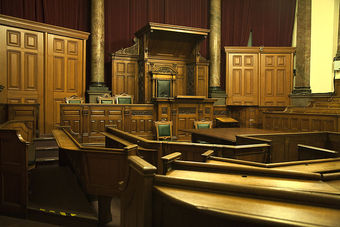
Evidential Appeal
The only type of rhetorical appeal accepted in a courtroom in an evidential appeal.
Evidential appeals are also the basis for scientific research. A scientist must be able to show the connection between evidence and a conclusion in order for his/her work to be accepted. In persuasive speaking, the speaker must first explain the evidence in a way that is comprehensible to the audience, yet complete. Then the scientist must explain how that evidence logically leads to a consequence that supports his/her proposal.
Pathos (Emotional Appeal)
An emotional appeal is intended to cause the audience to feel a certain way so that they will be convinced by the speaker. Emotional appeals can manifest in a number of ways. Metaphors, stories, and passionate delivery are all emotional appeals because their effectiveness lies not only in the words, but in the emotions they evoke in the audience. Ultimately, the effectiveness of an emotional appeal is determined only by the audience. If the audience does not feel the intended emotions, by definition, the appeal has failed.
15.2: Credibility Appeals
15.2.1: Defining Credibility
Credibility is defined as the objective and subjective components of the believability of a source or message.
Learning Objective
Give examples of how to boost subjective and objective credibility
Key Points
- Credibility is a composite of subjective and objective factors, so it relates to feelings and opinions, as well as facts and evidence.
- The subjective component of a public speaker’s credibility centers on the speaker’s self-presentation.
- The objective aspect of a public speaker’s credibility is based on the speaker’s expertise.
Key Terms
- Objective
-
not influenced by irrational emotions or prejudices; based on facts or evidence.
- subjective
-
formed, as in opinions, based upon a person’s feelings or intuition, not upon observation or reasoning; coming more from within the observer than from observations of the external environment.
- credibility
-
The objective and subjective components of the believability of a source or message.
Defining Credibility

Unmasking Credibility
Credibility is personal. In order to establish credibility, unmask yourself and show the audience who you really are.
What is credibility? Credibility is defined as the objective and subjective components of the believability of a source or message. Credibility is both objective, or based on facts and evidence, and subjective, based on opinions and feelings. This quality encompasses everything from your college degree or professional certification to the immediate “gut feeling” people get when they walk into the room.
Subjective Credibility: Self-Presentation
The subjective aspect of a public speaker’s credibility is based on the speaker’s self-presentation. Here are some tips for earning credibility on a subjective level:
- Dress the part. Show the audience that you take the speaking engagement seriously, and that you hope to earn their respect. If you’re not sure how to dress, professional attire is always a safe bet.
- Look at the audience. Establishing eye contact will make you seem open and trustworthy.
- Speak loudly, clearly, and confidently. If you have confidence in yourself, the audience will too.
Objective Credibility: Expertise
Mark Twain once said that an expert is just “an ordinary fellow from another town. ” If only it were that easy! In reality, if you want to convince the audience that you are an expert, you will have to show some credentials. Here are three ways to establish objective credibility:
- State your credentials. Audiences will trust you more readily if you can prove that other people value your expertise. Credentials include relevant degrees, certifications, testimonials, recommendations, work experience, volunteer experience, and informally, other types of personal experience.
- Reveal a personal connection to your topic. Your input will have more weight if you can demonstrate that the topic means something to you.
- Establish common ground with your audience. If you can explain that, ultimately, you all want the same thing, the audience will be much more likely to trust you and accept your message.
15.2.2: Types and Elements of Credibility
Experience, training, and associations and connections are all important factors that can boost credibility.
Learning Objective
Identify types of credibility and describe their use
Key Points
- Personal experience in the workplace, at home, in a hobby, or volunteering situations can bolster your credibility. You can support the validity of your experience with testimonials and personal recommendations.
- Formal or informal training that relates to your topic can also support your credibility.
- If you connect yourself and your message to credible people, your own credibility will benefit from the association.
Key Term
- credibility
-
The objective and subjective components of the believability of a source or message.
Types and Elements of Credibility
Credibility from Experience

Experience Is Important
These mountain climbers are scaling a sheer cliff in the Rhone-Alps of France. They have credibility due to their experience.
Imagine this scenario: you, a veteran mountain climber, are slated to give a speech about climbing safety to a group of mountaineers that is about to set off on a dangerous expedition. What would be the best source of credibility in that situation? Experience! The mountaineers would probably not be very impressed to hear that you read a book about climbing safety once, or that some of your best friends are mountaineers. However, if you bring in stories, photographs, and examples from your own climbing experience, you will assure them that you really know what you’re talking about. Drawing from your work experience, volunteering experience, hobbies, and informally, other types of personal experience can do a lot to boost your credibility as a speaker.
Credibility from Training
Do you have any formal or informal training that relates to your topic? If so, mention it during your speech to build your credibility. Relevant training programs and credentials include academic degrees, professional certifications, classes, conferences, and personal research. Even if your training isn’t directly related to your topic, there may be an indirect connection. Don’t feel obligated to stretch your story if it really doesn’t fit, but also don’t rule out training experiences that are out of your current field.
Credibility by Association
The first method for estimating the intelligence of a ruler is to look at the men he has around him.
-Niccolo Machiavelli
Machiavelli’s maxim teaches a valuable lesson: people will not only judge you on your own merits alone, but also on the merits of your associates. This rule isn’t only for rulers, it applies to public speakers too. If you want to be seen as a credible person, align yourself with other credible people. You can do this by citing testimonials from respected figures or mentioning personal recommendations that validate your expertise. Another approach is to quote prominent figures in your field, demonstrating an awareness of the issues and conversations that are current trends in that field.
15.2.3: Building Credibility
If you want to build credibility with your audience, you must demonstrate that you are a person of character.
Learning Objective
List ways to display personal character in order to build credibility with an audience
Key Points
- Establishing your good character is a crucial part of winning the audience’s trust.
- For a public speaker, character is not only about being a good person or a law-abiding citizen; speakers should also be looking out for the needs of their listeners.
- To show your listeners that you care about their needs and interests, find common ground with the audience, appeal to shared beliefs and goals, and entertain potential objections.
Key Term
- character
-
Moral strength; consistency of values and principles.
Character may almost be called the most effective means of persuasion. –Aristotle
You can not dream yourself into a character; you must hammer and forge yourself one. –James A. Froude
Greek philosopher Heraclitus’s famous maxim, “Character is destiny,” has echoed through the ages: if you want to win the audience’s trust, you must demonstrate that you are a person of character. Aristotle argues that establishing good character is one of the most important means of persuasion. Roman orator Quintillian defines persuasive rhetoric as essentially “the good man speaking well. ” British historian James A. Froude takes the colloquial idea of “building character” one step further, leading us to imagine a laborious undertaking in a blacksmith’s forge, shaping “character” with a hammer. The literature surrounding public speaking emphasizes the importance of establishing good character, but also admits that it is not easy.
Credibility, Character, and Caring
Personal character is an important addition to the elements of credibility we discussed in the last segment . However, it is important to note that, for a public speaker, character is not as simple as being a nice person or a law-abiding citizen. Public speakers are responsible for communicating something of value to a large group of people. A public speaker of character should listen to the needs of the audience, entertain potential objections, walk the audience through opposing viewpoints, and respond to questions. Show your listeners that you’re looking out for them. After all, why should they trust you if you don’t care about them? To bring the audience’s needs and interests to the forefront of your speech, follow these steps:

Building Credibility
Credibility is built through character, trustworthiness, experience, expertise, and associations/connections.
- Find common ground with your audience.
- Appeal to shared beliefs and values.
- Identify a shared goal.
- Return to this shared goal throughout the speech.
- Demonstrate that you have considered other perspectives on the issue.
- Show that you understand the appeal of opposing positions.
- Make a case for your own position.
15.2.4: Ethical Usage
Credibility appeals, while an effective form of persuasive speaking, carry a unique set of ethical challenges and considerations.
Learning Objective
Explain the ethical challenges of using credibility appeals in persuasive speaking
Key Points
- There are three types of appeal techniques in persuasive speaking: logos, pathos and ethos. Ethos is focused on the credibility appeal, that is, a rhetorical appeal to an audience based on the speaker’s credibility.
- It is unethical to lie to your audience about who you are and what you bring to the table in terms of experience, credibility and authority.
- When it comes to ethical usage of credibility appeals, stick to authenticity and speaking honestly about who you are.
Key Term
- ethos
-
A rhetorical appeal to an audience based on the speaker/writer’s credibility.
Example
- A job interview represents a persuasive speaking opportunity on a much smaller scale, one that relies heavily on the use of ethos. You are, in essence, persuading a potential employer to hire you on the merits of your abilities, skills and experience. An ethical job candidate will deliver a résumé and interview responses that are truthful, honest and complete about who they are and what they would bring to the job. An unethical use of ethos by a job candidate would be when one “pads” their résumé with experiences and honors that may not actually have happened or been achieved.
Ethical Usage of Credibility Appeals

Appeal Techniques
The three types of appeal techniques in persuasive speaking are logos, ethos, and pathos.
Speeches grounded in the principles of rhetoric focus on three types of rhetorical appeals: logos, pathos, and ethos. While logos and pathos appeal to reason and emotion, respectively, ethos takes on a decidedly different approach entirely. Speakers using ethos seek to persuade their audience by demonstrating their own credibility and authority.
To elaborate, the construction of authority is reflected in how a speaker presents themselves, what diction they use, how they phrases their ideas, what other authorities to which they refer, how they composes themselves under stress, their experience within the context of their message, as well as their personal or academic background.
Ethical Considerations
Obviously, if you elucidate a persuasive portrait of your personal credibility and authority, you make a more persuasive case on the credibility and authority of your words. However, when building a persuasive case using ethos, it may be tempting to stray into territory that borders on the unethical. Consider the following example:
You might not realize it at first, but interviewing for a job is an abbreviated form of persuasive speaking. You’re trying to persuade an employer to offer you a job. This method of persuasion relies heavily on the use of ethos, as you’re trying to make your case as to why you’re the best person for the job.
When you submit your résumé and cover letter, you provide your potential employer with an overview of your skills, experiences and background and how they best fit with the position and company with whom you seek employment.
While many employers complete extensive background reviews and reference checks, they may not follow up with every single bullet point on your résumé. While it might be tempting to beef up your list of achievements by stretching the truth: naming yourself a college club president as opposed to member, listing an award you may have nominated for but not having won (without clarifying that fact) – these are all unethical ways of padding your résumé, and thus, unethically using ethos to persuade your potential employer to hire you for the job.
This same example holds true in more formal scenarios of persuasive public speaking. It is unethical to lie to your audience about who you are and what you bring to the table in terms of experience, credibility and authority. It is equally unethical to even bend the truth on the slightest detail about what makes you a credible or authoratative speaker on your given subject.
Whether it’s a flat-out moment of dishonesty or a simple “little white lie,” disingenuousness, once discovered, will eradicate any credibility or authority you have as a speaker. When it comes to ethical usage of credibility appeals, stick to authenticity and speaking honestly about who you are.
15.3: Evidentiary Appeals
15.3.1: Defining Evidence
Evidence refers to the available body of facts or information indicating whether a belief or proposition is true.
Learning Objective
Explain how accuracy, audience understanding and relevant context assesses the strength of evidence in persuasive speaking
Key Points
- Accurate, contextual, easily understandable evidence builds credibility to your persuasive argument.
- The success or failure of an evidential appeal depends on how well the evidence has been defined and laid out for the audience.
- Any information used as evidence must be complete enough that it strengthens the appeal. Otherwise, weak evidence will only erode the argument.
- Name and define the evidence only as comprehensively as the scope of the speech allows; dense supporting materials can actually confuse your audience by overwhelming them with too much or too deeply defined evidence.
Key Term
- evidence
-
The available body of facts or information indicating whether a belief or proposition is true or valid.

Finding Evidence
Sherlock Holmes (played here by actor Benedict Cumberbatch) always looked for a solid body of evidence to indicate a particular criminal.
Evidence refers to the available body of facts or information indicating whether a belief or proposition is true. The facts and information affirm the validity of the idea. To understand it in the opposite, to lack evidence is to lack the validity of a belief or idea. Evidence builds credibility.
As the name suggests, evidential appeals rely on the use of evidence to persuade the audience. Evidential appeals can be used in both emotional and logical appeals, though the method for delivery differs. The success or failure of the appeal depends on how well the evidence has been defined and laid out for the audience.
In the context of persuasive speaking, evidence can be evaluated for its persuasive ability in the following three ways:
- Accuracy: The evidence must be truthfully constructed and defined. For example, if an argument hinges on the premise that grass is purple, no rhetorical technique will be able to persuade the audience. Evidence must be accurate to be credible, as its credibility rests on its accuracy.
- Audience Understanding:Evidence must be presented completely, but in a manner that the audience can comprehend. For example, an evidential appeal that uses rising carbon dioxide levels as evidence for stricter pollution regulation will not be effective if the audience does not know what carbon dioxide is or why it is bad for the environment. The audience must be able to understand the evidence before it is used in an appeal.
- Relevant Context: The evidence must be defined within the context of the appeal. A textbook definition of the different types of bonds between the atoms of carbon dioxide is not relevant information for why the tax rate should be lowered.
Information used in evidential appeals must serve two purposes at once. First, it must be complete enough that it strengthens the appeal. If the evidence is weak, incomplete, or irrelevant, it does not help the appeal, and may even hurt its persuasiveness. Secondly, the evidence must be defined only as comprehensively as necessary. The purpose of an evidential appeal is to persuade the audience; overwhelming the audience with too much information or evidence may only confuse them.
15.3.2: Deploying Evidence
Deploy accurate, relevant, and thorough evidence strategically in order to most effectively argue your point.
Learning Objective
Explain why speakers must consider accuracy, relevancy, and thoroughness when deploying evidence in public speaking
Key Points
- When crafting your speech, consider the following three areas: accuracy, relevance, and thoroughness.
- Make sure that your evidence, be it facts, statistics, personal testimony, or other pieces of information, comes from credible sources.
- Make sure your evidence is directly related to the points you are trying to make while also anticipating competing evidence that may contradict your line of reasoning.
- By thorough by fully explaining and defining your evidence to your audience, but don’t overwhelm them in the process.
Key Terms
- thorough
-
painstaking and careful not to miss or omit any detail
- evidence
-
The available body of facts or information indicating whether a belief or proposition is true or valid.
- Accuracy
-
Exact conformity to truth, or to a rule or model; degree of conformity of a measure to a true or standard value.
When using evidential appeals in your persuasive speech, make sure to deploy evidence strategically in order to most effectively argue your point.

Gathering Evidence
In persuasive speaking, the speaker must gather and deploy evidence strategically.
Strategies for Deploying Evidence Effectively
As you craft your persuasive speech, ask yourself the following questions:
Is My Evidence Accurate?
It can’t hurt to double check. Make sure that your evidence, be it facts, statistics, personal testimony, or other pieces of information, comes from credible sources. How do you know if it’s a credible source? If they are well-known, respected leaders or sources of information in a given field, you can be fairly confident in their credibility. As for web sources, make sure the site you’re accessing is impartial and unbiased. It’s also helpful to anticipate any questions your audience may have about your evidence, including any challenges they may make to its credibility or accuracy.
Is My Evidence
Relevant
?
Just how well does your evidence actually back up your argument? Just because it might be believable to you does not mean it will be as compelling to another. That disconnect might occur when your evidence is not actually relevant to your argument. Make sure your evidence is directly related to the points you are trying to make. Likewise, your audience may have evidence of their own to contradict your line of reasoning; anticipate these contradictions and argue your point with evidence to counter their disagreements. In short, keep your evidence relevant, but make sure to have more up your sleeve if needed to further prove your point.
Is My Evidence Thorough?
Sometimes your case may not be compelling simply because you haven’t fully supported your thesis. Your evidence may only skim the surface. It’s a fine balance between thoroughly explaining and defining your evidence to your audience and overwhelming them in the process. In this regard, it’s important to have a comprehensive understanding about the knowledge base of your audience. Let the lowest level of understanding in your audience dictate how thorough you need to be; at the same time, don’t over-explain or get into so much depth that you lose more of your audience than you win over.
15.3.3: Ethical Usage: Considering Other Viewpoints
Persuasive speakers have an ethical duty to consider opposing viewpoints and evidence before being sure that theirs are correct.
Learning Objective
Explain why considering other viewpoints is considered ethical in public speaking
Key Points
- The same evidence can be interpreted differently by different people.
- Falsified evidence (intentionally or unintentionally) is unethical to use. Finding false evidence that is due to statistical fallacy can only be found after deep critique.
- If an argument can withstand the honest critique of an opponent and is based on true and complete evidence, then the appeal is on sound ethical ground.
Key Term
- fallacy
-
An error in reasoning often due to a misconception or a presumption; used in informal discourse to mean an argument which is problematic for any reason
The honest consideration of other viewpoints is an ethical duty if you are a persuasive speaker seeking to convince the audience of something you believe to be true. You may be making the wrong conclusion based on the evidence or your evidence may be flawed, both of which can be shown by examining other views. Perhaps you and your opponent are using the same evidence but come to different conclusions. If you are able to consider other viewpoints and still believe in your original view, then you are ethically able to attempt to persuade others.
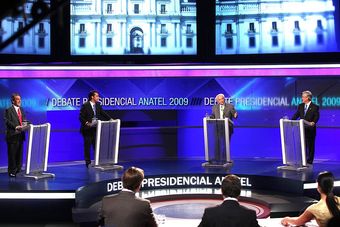
Different Viewpoints
Political debates highlight how people can interpret the same evidence different ways and come to opposing views.
As a persuasive speaker, there is always an incentive to invent, or even just fudge evidence so as to strengthen your appeal and weaken opposing viewpoints. However, this is akin to lying, and clearly unethical.
Furthermore, evidence must generally be accepted only after intense scrutiny. Statistics, and many types of evidence, do not fall neatly into the category of “true” or “false.” While there are some undeniable truths, such as the fact that the earth is round, there are many more that fall into a gray area. This is due to the fact that evidence comes from a process which may be flawed. When the process is flawed, there may be a statistical fallacy. For example, if a survey asks skewed questions, the results may not reflect the truth. Though many researches, scientists, pollsters, and investigators do their best to avoid fallacies, the possibility always exists that one may be proven.
Since it is very easy to unintentionally lie by not explaining all the nuances of the evidence and it is very easy to use evidence that may contain fallacies, it is the duty of every speaker to consider the viability of opposing viewpoints before rejecting them. It is your ethical duty to allow others to criticize your viewpoints because if your argument is truly sound and you are truly making the appeal to convince the audience of something that you believe to be true based on all the evidence, then your evidence should be able to withstand the scrutiny.
15.4: Logical Appeals
15.4.1: Different Lines of Reasoning
Apply two different lines of reasoning—inductive and deductive—to consciously make sense of observations and reason with the audience.
Learning Objective
Demonstrate the use of inductive and deductive reasoning
Key Points
- Inductive reasoning, also known as induction, is a kind of reasoning that constructs general propositions that are derived from specific examples.
- Inductive reasoning is probabilistic; it only states that, given the premises, the conclusion is probable.
- One important aspect of inductive reasoning is associative reasoning: seeing or noticing similarity among the different events or objects that you observe.
- Deductive reasoning is the process of reasoning from one or more general statements, laws, or principles regarding what is known, in order to reach a logically certain conclusion.
Key Terms
- inductive reasoning
-
A kind of reasoning that constructs or evaluates general propositions that are derived from specific examples. Inductive reasoning contrasts with deductive reasoning, in which specific examples are derived from general propositions.
- syllogism
-
An inference in which one proposition (the conclusion) follows necessarily from two other propositions, known as the premises.
- deductive reasoning
-
The process of reasoning that uses given true premises to reach a conclusion that is also true. Deductive reasoning contrasts with inductive reasoning.
Reason is the capacity for consciously making sense of things. Reason, or “reasoning,” is associated with thinking, cognition, and intelligence. It is the means by which rational beings understand cause and effect, truth and falsehood, validity, and what is good or bad. The result is a reason that could then be used to explain or justify some event, phenomenon, or behavior.
As you develop arguments for your persuasive speech, you are likely to engage in two different lines of reasoning: inductive, which uses associations, and deductive.
Inductive Reasoning and Associative Reasoning
Inductive reasoning, also known as induction, is a kind of reasoning that constructs general propositions that are derived from specific examples based on previous observations. One important aspect of inductive reasoning is associative reasoning: seeing or noticing similarity among the different events or objects that you observe. For example, if you throw a ball in the air and it comes back down, again and again, you observe the same event happening and are likely to conclude that when you kick a ball in the air, it will come back down.
Inductive reasoning is probabilistic; it only states that, given the premises, the conclusion is probable. Consider these simple logical statements, known as syllogisms. Here is a statistical syllogism to illustrate inductive reasoning:
- 90% of humans are right-handed.
- Joe is a human.
- Therefore, the probability that Joe is right-handed is 90%. If you were required to guess, you would choose “right-handed” in the absence of any other evidence.
Here is another stronger example:
100% of life forms that we know of depend on liquid water to exist. Therefore, if you discover a new life form, it will probably depend on liquid water to exist.
This argument could have been made every time a new life form was found, and would have been correct every time. While it is possible that in the future a life form that does not require water will be discovered, in the absence of other factors, the conclusion is probably correct, as it has been in the past.
Inductive reasoning is used to determine properties or relationships based on previous observations or experiences, and then to formulate general statements or laws based on limited observations of recurring phenomenal patterns. The conclusion of an inductive argument follows with some degree of probability.
Inductive reasoning involves association or analogical reasoning. In order to engage in inductive reasoning, we must observe, see similarities, and make associationsbetween conceptual entities. The ability to structure our perceptions relies on the associative network in our brain, which allows us see the likeness and form a concept, about the similarities.
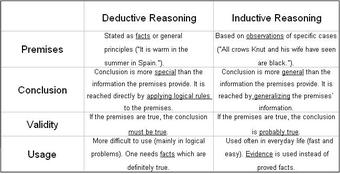
Deductive and Inductive Reasoning
There are key differences between deductive and inductive reasoning.
Deductive Reasoning
Deductive reasoning, also called deductive logic, is the process of reasoning from one or more general statements, laws, or principles regarding what is known, in order to reach a logically certain conclusion. Deductive reasoning involves using given, true premises to reach a conclusion that is also true. If you accept or know the general principle as true, then you can apply it to the specific case to conclude that it is also true.
Consider the general principle of the law a gravity: what goes up must come down. Now, when you throw the ball in the air, you conclude that it will fall down based on your knowledge of the general law of gravity. Deductive reasoning contrasts with inductive reasoning in that a specific conclusion is arrived at from the general principle when reasoning deductively. If the rules and logic of deduction are followed, this procedure ensures an accurate conclusion. Here is a classic example of a deductive argument:
- All men are mortal.
- John is a man.
- Therefore, John is mortal.
The first premise states that all objects classified as “men” have the attribute “mortal. ” The second premise states that “John” is classified as a “man”—a member of the class or group of “men. ” The conclusion then states that “John” must be “mortal” because he inherits this attribute from his classification as a “man. ” If both premises are true, the terms are clear, and the rules of deductive logic are followed, then the conclusion of the argument follows by logical necessity.
Conclusion
In summary, with inductive reasoning, you are making observations of specific or particular events and then drawing a general conclusion; whereas with deductive reasoning, you are starting with a general statement and applying it to particular instances when you draw your final conclusion about a particular instance, person, or object.
15.4.2: Deploying a Rational Appeal
A rational appeal uses logical arguments and factual evidence to persuade individuals.
Learning Objective
Explain how to construct a rational appeal
Key Points
- Deploying rational appeals focuses on reasoning and how you use evidence to reason with your audience and invention, how arguments are formed based on the classical proof of logos–rational appeal and logic.
- The burden of proof is on you the speaker to develop the right appeals for the particular audience.
- When deploying deductive reasoning consider whether or not the audience is likely to accept the general premise as valid and true before you attempt to deduce other ideas or courses of action based on the general premise.
- When deploying inductive reasoning consider if you have observed or collected enough evidence to draw a highly probable conclusion.
- When deploying associative reasoning, you will want to make sure that the ideas are indeed similar and that there are not obvious or outstanding differences which would negate the association you propose.
- As you deploy a rational appeal consider if your reasoning is sound, whether the audience will accept your evidence and reasoning, and what objections the audience might raise so you can address the most significant points of disagreement in your message.
Key Term
- Invention
-
the formulation of arguments based on logos–rational appeal or logic.
Forming a Rational Appeal
A rational appeal uses logical arguments and factual evidence to persuade individuals that whatever thesis you are supporting is viable and likely to result in the obtainment of goals. When you focus on rational appeals you are dealing with the mind and cognition of the audience .
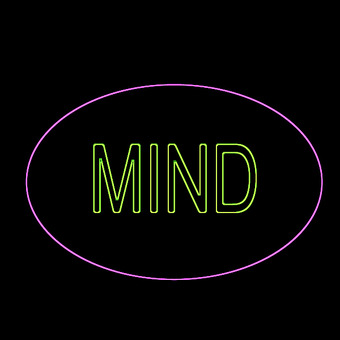
The Mind
When you focus on rational appeals, you are dealing with the audience’s mind and cognition.
The study of rhetoric has historically focused on three types of persuasive appeals–ethos, pathos, and logos. Our focus on reasoning and how you to use evidence to reason with your audience is part of the study of logos. Additionally, you are concerned with invention, which is the first of the five canons of rhetoric identified by Cicero, the classical Roman rhetorician. Invention is how you formulate arguments based on logos–rational appeal or logic.
When you appeal to reason you use logically constructed arguments using your evidence to persuade your audience to agree with you. You might use many different forms of evidence to support your rational appeal. Basically, the burden of proof is on you the speaker as you develop your appeals to the audience. As you deploy a rational appeal consider: Is my reasoning sound, and what will the audience accept as a believable evidence?
Is Your Reasoning Sound?
Prior to your speech, it is important to consider the soundness of your evidence and reasoning.
Deductive reasoning: For example, if you are engaging in deductive reasoning, you will want to consider whether or not the audience is likely to accept the general premise as valid and true before you attempt to deduce other ideas or courses of action based on the general premise.
If you are quoting an authority and drawing conclusions from the authority, it is important to ask if the audience will accept or believe the authority. Remember to quote or use sources that the audience is familiar and will believe; using other authorities or sources will likely not be productive.
Inductive reasoning: If you are engaging in inductive reasoning, you will want to consider whether you have observed or collected enough evidence to draw a highly probable conclusion. Or, did you draw a hasty conclusion based on too few examples or observations?
If you are using statistical evidence as part of your inductive reasoning, it is important to consider how the data was collected and whether it is truly valid. If you do not have valid statistical data, then the inductions will not be valid. Before using any data, ask:
- Is the source biased, or perceived as biased?
- Is the source competent in the field being consulted?
- Is the information current?
Associative reasoning (analogy): When engaging in associative reasoning, you will want to make sure that the ideas are indeed similar and that there are no obvious or outstanding differences which would negate the association in the mind of your audience.
Address Resistance and Concerns of the Audience
Finally, in persuasive situations it is important to anticipate the potential resistance and counterarguments your audience might feel. When you have a sense of what objections the audience might raise, you can and should address the most significant points of disagreement in your message.
Arguments from reason (logical arguments) have some advantages, namely that data are (ostensibly) difficult to manipulate, so it is harder to argue against such an argument; and such arguments make the speaker look prepared and knowledgeable to the audience, enhancing ethos. In addition, if you have built ethos with the audience then it will enhance your appeal with arguments from reason.
15.4.3: Logical Fallacies
A fallacy is an error in reasoning; there are two basic categories of fallacies–formal and informal.
Learning Objective
Give examples of formal and informal logical fallacies
Key Points
- “Formal” refers to the form of the argument. An argument that contains a formal fallacy will always be invalid. However, even if a premise is not accurate, the formal conclusion could still be valid if the rules of logic are followed.
- An informal fallacy is an error in reasoning that occurs due to a problem with the content, rather than mere structure, of the argument and is often due to a misconception or a presumption.
- Common Fallacy–hasty generalization: argues from limited examples or a special case to a create general rule that applies to many cases.
- Common Fallacy–Popular sentiment or bandwagon appeal (argumentum ad populum):—appeal to the majority; appeal to loyalty, “Everyone is doing it”.
- Common Fallacy–If it comes before, it is the cause, post hoc ergo propter hoc: believing that temporal succession implies a causal relation.
- Common Fallacy–Two events co-occurring is not causation, cum hoc ergo propter hoc: believing that correlation implies a causal relation.
Key Terms
- fallacy
-
An error in reasoning often due to a misconception or a presumption; used in informal discourse to mean an argument which is problematic for any reason
- straw man
-
An insubstantial concept, idea, endeavor or argument, particularly one deliberately set up to be weakly supported, so that it can be easily knocked down; especially to impugn the strength of any related thing or idea.
- red herring
-
A clue or information that is or is intended to be misleading, that diverts attention from a question;often thought to relate to using smelly fish to train dogs to recognize the real scent of something they were suppose to be tracking.
Errors in reasoning–formal and informal
A fallacy is an error in reasoning. There are two basic categories of fallacies–formal and informal.
Formal Fallacies
Formal fallacies occur when there is a problem with the form, or structure, of the argument. “Formal” refers to the form of the argument. An argument that contains a formal fallacy will always be invalid.
Consider an example with a visualization of faulty reasoning involving categorical deduction.
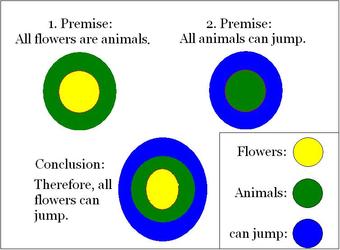
Categorical Deduction
Deductive reasoning can be valid, while the major premise is not valid.
- All flowers are animals.
- All animals can jump.
- Therefore, all flowers can jump.
Even though it is quite obvious that the first premise is not true and further that the conclusion is not true, the whole syllogism is still valid. By applying formal logic to the syllogism in the example, the conclusion is still valid.
Informal Fallacies
An informal fallacy is an error in reasoning that occurs due to a problem with the content, rather than mere structure, of the argument. In informal logic and rhetoric, a fallacy is usually an error in reasoning often due to a misconception or a presumption. Some of the more frequent common logical fallacies are:
- Converse fallacy of accidental or hasty generalization: argues from limited examples or a special case to a general rule. Argument: Every person I’ve met has ten fingers, therefore, all people have ten fingers. Problem: Those, who have been met.are not a representative subset of the entire set.
- Making the argument personal (argumentum ad hominem): attacking or discrediting the opposition’s character. Argument: What do you know about the U.S? You aren’t even a citizen. Problem: personal argument against an opponent, instead of against the opponent’s argument.
- Popular sentiment or bandwagon appeal (argumentum ad populum): an appeal to the majority; appeal to loyalty. Argument: Everyone is doing it. Problem: Concludes a proposition to be true because many or most people believe it.
- Red herring (Ignoratio Elenchi): intentionally or unintentionally misleading or distracting from the actual issue. Argument: I think that we should make the academic requirements stricter for students. I recommend that you support this because we are in a budget crisis and we do not want our salaries affected. Problem: Here the second sentence, though used to support the first, does not address the topic of the first sentence, instead switching the focus to the quite different topic.
- Fallacy of false cause (non sequitur): incorrectly assumes one thing is the cause of another. Non Sequitur is Latin for “It does not follow. ” Argument: I hear the rain falling outside my window; therefore, the sun is not shining. Problem: The conclusion is false because the sun can shine while it is raining.
- If it comes before it is the cause (post hoc ergo propter hoc): believing that temporal succession implies a causal relation. Argument: It rained just before the car died. The rain caused the car to break down. Problem: There may be no connection between the two events.
- Two events co-occurring is not causation (cum hoc ergo propter hoc): believing that correlation implies a causal relation. Argument: More cows die in the summer. More ice cream is consumed in summer months. Therefore, the consumption of ice cream in the summer is killing cows. Problem: No premise suggests the ice cream consumption is causing the deaths. The deaths and consumption could be unrelated, or something else could be causing both, such as summer heat.
- Fallacy of many questions or loaded question (Plurium Interrogationum): groups more than one question in the form of a single question. Argument: Have you stopped beating your wife? Problem: Either a yes or no answer is an admission of guilt to beating your wife.
- Straw man: creates the illusion of having refuted a proposition by replacing it with a superficially similar proposition (the “straw man”), and refuting it, without ever actually refuting the original. Argument: Person A: Sunny days are good Person B: If all days were sunny, we’d never have rain, and without rain, we’d have famine and death. Therefore, you are wrong. Problem: B has misrepresented A’s claim by falsely suggesting that A claimed that only sunny days are good, and then B refuted the misrepresented version of the claim, rather than refuting A’s original assertion.
- The false dilemma or either-or fallacy: the listener is forced to make a choice between two things which are not really related or relevant. Argument: If you are not with us, you are against us. Problem: The presentation of a false choice often reflects a deliberate attempt to eliminate any middle ground.
- Card-stacking, or cherry picking: deliberate action is taken to bias an argument by selective use of facts with opposing evidence being buried or discredited. Argument: Learn new skills, become a leader and see the world. Problem: Only the positive benefits of military service are used to recruit , and not the hazards.
As a speaker you want to carefully consider your reasoning and how you draw your logical conclusions in order to avoid faulty reasoning.
15.5: Emotional Appeals
15.5.1: Defining Emotional Appeal
An emotional appeal is used to sway the emotions of an audience to make them support the speaker’s argument.
Learning Objective
Break down the components that make up an emotional appeal
Key Points
- Pathos represents an appeal to the emotions of an audience.
- An emotional appeal uses the manipulation of the emotions rather than valid logic to win an argument.
- Emotional appeal is a logical fallacy, whereby a debater attempts to win an argument by trying to get an emotional reaction from the opponent and audience.
- In debating terms, emotional appeals are often effective as a rhetorical device, but are generally considered naive or dishonest as a logical argument, since they often appeal to the prejudices of listeners rather than offer a sober assessment of a situation.
Key Term
- logical fallacy
-
A fallacy; a clearly defined error in reasoning used to support or refute an argument, excluding simple unintended mistakes.
Emotional Appeal Defined
Pathos represents an appeal to the audience’s emotions. Pathos is a communication technique used most often in rhetoric (where it is considered one of the three modes of persuasion, alongside ethos and logos), and in literature, film, and other narrative art.
Emotional appeal can be accomplished in a multitude of ways:
- By a metaphor or storytelling, common as a hook
- By a general passion in the delivery
- By an overall emotion
- By the sympathies of the speech or writing as determined by the audience
The pathos of a speech or writing is only ultimately determined by the audience.
The Purpose of an Emotional Appeal
An emotional appeal is directed to sway an audience member’s emotions and uses the manipulation of the recipient’s emotions rather than valid logic to win an argument. An emotional appeal uses emotions as the basis of an argument’s position without factual evidence that logically supports the major ideas endorsed by the presenter. In an emotional appeal, persuasive language is used to develop the foundation of an appeal to emotion-based arguments instead of facts. Therefore, the validity of the premises that establish such an argument does not prove to be verifiable.
Emotional appeal is a logical fallacy, whereby a debater attempts to win an argument by trying to get an emotional reaction from the opponent and audience. It is generally characterized by the use of loaded language and concepts (God, country, and apple pie being good concepts; drugs and crime being bad ones). In debating terms, emotional appeals are often effective as a rhetorical device, but are generally considered naive or dishonest as a logical argument, since they often appeal to the prejudices of listeners rather than offer a sober assessment of a situation.
Examples of Emotional Appeals
Children are more often than not toddled out as an appeal to emotion. From pictures of starving children to motivate people to give to charity to using them as any excuse to ban things that children shouldn’t even be aware of (e.g., guns), they are repeatedly paraded in front of audiences to appeal to their emotional protective instincts, often overriding anyone’s sense of rationality . “For the children” or “think of the children” as emotional appeals have been used with success in passing political motions such as Proposition Hate in California.

Emotional Appeal
A picture like this could be used as an emotional appeal for a charity campaign to increase funding for soldiers’ families.
As with children, cute animals override most people’s logic. Even if the pictures of animal testing put out by PETA are 50 years out of date, they still provoke an emotional response rather than a reasoned one when trying to assess cruelty in animal testing.
15.5.2: Producing an Emotional Appeal
Finding words to match the speech context and audience’s disposition is essential to producing an effective emotional appeal.
Learning Objective
Identify the components that produce an emotional appeal in a speech
Key Points
- Producing an emotional appeal requires an understanding of your audience and what may strike their emotions the most.
- An effective way to create emotional appeal is to use words that have a lot of pathos associated with them. Pathos is an emotional appeal used in rhetoric that depicts certain emotional states.
- An example of a speech that is particularly effective at producing an emotional response with its listeners is Martin Luther King, Jr.’s “I Have a Dream” speech. The speech uses rhetoric to convey the point of equal opportunity for all people.
Key Terms
- pathos
-
An appeal to the audience’s emotions.
- Disposition
-
A habit, a preparation, a state of readiness, or a tendency to act in a specified way.
- rhetoric
-
The art of using language, especially public speaking, as a means to persuade.
Producing an Emotional Appeal
Producing an emotional appeal requires an understanding of your audience and what may strike their emotions the most.
For example, if you are giving a speech at an event to raise money for a children’s hospital, it would be appropriate to use an appeal to emotions relating to children. For instance, the speaker could use an emotionally charged anecdote about a child who was sick and was cured at this hospital. This story stresses the value that the hospital had on improving the child’s health.
In general, an effective way to create emotional appeal is to use words that have a lot of pathos associated with them. Pathos is an emotional appeal used in rhetoric that depicts certain emotional states. Some examples of “pathos” charged words include: strong, powerful, tragic, equality, freedom, and liberty. These words can be used in a speech to intensify an emotional appeal to an audience.
The Emotional Appeals in “I Have a Dream”
An example of a speech that is particularly effective at producing an emotional response with its listeners is Martin Luther King, Jr.’s “I Have a Dream” speech.

Emotional Appeals
Martin Luther King, Jr.’s speech “I Have a Dream” effectively produced an emotional response from the audience.
The speech uses rhetoric to convey the point of equal opportunity for all people. It is considered by many as a prime example of successful rhetoric and emotional appeal.
In the speech, Martin Luther King Jr. weaves current events into the fabric of American history, underscoring the tragedy with biblical rhetoric. King hinges his call for change on three refrains, or repeated phrases. He frames his vision for the future with the famous phrase, “I have a dream.”
As his speech draws to a close, he wills his vision to become reality across the country, moving on to the refrain, “Let freedom ring!” He closes his speech with the repeated line, “Free at last!” King articulates cruel injustices, leads us in imagining a world without those injustices, and then appeals to his audiences emotions through these phrases and the idea of a world with equal opportunity.
15.5.3: Ethical Usage
When you make emotional appeals avoid unethical tactics, such as exploitative manipulation.
Learning Objective
List the types of manipulative techniques used to emotionally appeal to audiences
Key Points
- Ethos (plural: ethe) is an appeal to the authority or honesty of the presenter.
- Emotional appeals will encourage the audience to identify with your message on a visceral level, bypassing intellectual filters, such as skepticism and logic.
- It may be appealing to take a shortcut to making the audience sympathize with your point of view. However, emotional appeals don’t always hold up well after the fact–so fortify your emotional appeal by engaging the intellect, too.
Key Terms
- ethos
-
A rhetorical appeal to an audience based on the speaker/writer’s credibility.
- manipulation
-
The usage of psychological influence over a person or situation to gain a positive outcome.
- ethics
-
The study of principles relating to right and wrong conduct.
Ethical Usage
Emotional appeals are very powerful. When you stir sympathy in your listeners, you encourage them to identify with your message on a visceral level, bypassing intellectual filters, such as skepticism and logic.
However, this may be unethical because you are not allowing your listeners to logically consider your argument and rationally determine how they would react to your argument in absence of an emotional appeal.
It may be appealing to take a shortcut toward making the audience sympathize with your point of view. An emotional appeal may save you the trouble of working out a good argument. However, emotional appeals don’t always hold up well after the fact when your audience has had a chance to process your message.
Therefore, be sure to substantiate your emotional appeal with both logic and facts.
Emotional Manipulation
Since emotional appeals are very strong, they can sometimes be used inappropriately in order to gain something from the audience members.

Manipulation
Adolf Hitler is an example of a political figure who used emotional manipulation.
For example, an emotional appeal could be used in a political rally to persuade people to vote for the candidate, especially if the vote will happen in the next few days. This emotional appeal may persuade audience members to vote for you or your candidate, but it may also be unethical or considered manipulative if the audience members do not have a chance to rationally process the message before the vote takes place.
This is especially critical for situations, such as politics, which people generally have emotionally charged opinions about.
Some inappropriate uses of manipulative techniques of emotional appeals include:
- Lying or lying by omission: telling outright falsehoods or misleading by leaving out crucial pieces of information.
- Denial: refusing to admit that you or your affiliates have done anything wrong.
- Covert intimidation: using subtle, indirect or implied threats.
- Guilt tripping: suggesting that the audience does not care enough, is too selfish, or has it easy. Guilt tripping encourages self-doubt and submissive behavior.
- Shaming: using tactics, such as direct criticism, a fierce look or glance, an unpleasant tone of voice, rhetorical comments, and subtle sarcasm to undermine audience members.
- Playing the victim: putting on the role of a victim of circumstances or the bad behavior of others in order to evoke sympathy.
- Vilifying the victim: acting as though the victim of the bad behavior of your (or your associates) did something to deserve negative consequences.
- Seduction: using charm, praise, and flattery to manipulate others.
In order to ethically portray an emotional appeal, be sure to avoid these inappropriate uses and manipulative techniques for emotional appeals. Emotional appeals can be effective if they are not manipulative and are used to further an honest message.
How to Prove that You are Ethical
Ethos (plural: ethe) is an appeal to the authority or honesty of the presenter. It is how well the presenter convinces the audience that he or she is qualified to present (speak) on the particular subject. It can be done in many ways:
- By being a notable figure in the field in question, such as a college professor or an executive of a company whose business is that of the subject.
- By having a vested interest in a matter, such as the person being related to the subject in question.
- By using impressive logos that show the audience that the speaker is knowledgeable on the topic.
- By appealing to a person’s ethics or character.
15.6: Motivational Appeals
15.6.1: Motivating Listeners
Motivational appeals arouse the audience to take action toward a desired goal to satisfy unmet needs or desires.
Learning Objective
Explain the steps that make up Alan Monroe’s motivated sequence for organizing persuasive speeches, and how Maslow’s Hierarchy of Needs serves as a method for motivating listeners
Key Points
- We can divide our motives into two basic types: internal, intrinsic and external or extrinsic motives. Some are more intrinsic than others, but basically a motive or motivator is external if someone controls the means for you to satisfy the need or desire.
- It is important to understand the current state of unfulfilled desires or need states that exist in your audience in order to select the appropriate motives for your appeal.
- You can use Maslow’s Hierarchy of Needs to select an unsatisfied need for your motivational appeals. The lower level needs such as Physiological and Safety needs will have to be satisfied before higher level needs, such as achievement or self-actualization can be addressed.
- Monroe’s Motivated Sequence is one method to organize your appeal to the listeners. The five steps in order are: Get Attention, Explain Need, Satisfaction (how your solution will met the need), Visualization (picture audience living with solution in place), and Action (what audience can do now).
Key Terms
- Motivated sequence
-
a technique for organizing persuasive speeches that inspires people to take action, developed by Alan Monroe. Includes five steps—attention, need, satisfaction, visualization, and action.
- motive
-
An incentive to act; a reason for doing something; anything that prompted a choice of action.
- motivation
-
Willingness of action especially in behavior
Motivating Listeners
Motivation arouses us to action toward a desired goal
Motivation is the psychological feature that arouses us to action toward a desired goal and prompts us to want to continue behaviors toward the goal. If you have not eaten, then you are motivated by your hunger and you respond by seeking out food and eating. Motivation may be rooted in a basic need to minimize physical pain and maximize pleasure and it may also include specific physical, cognitive, and emotional needs or desires, too.
Internal, Intrinsic, and External Motives vs. Extrinsic Motives
We can divide our motives into two basic types: internal, intrinsic and external or extrinsic motives. There is no a clear cut distinction between intrinsic and extrinsic motives. Some are more intrinsic than others, but basically, a motive or motivator is extrinsic if someone controls the means or directs you to satisfy the need or desire. For example, if you are motivated to study because a professor says you will fail the class if you do not, then you are extrinsically motivated and passing the class is the desired reward.

Motivation
External motivation (the stick) directs one’s action to get the reward (the carrot).
Sixteen Basic Motivators
Here are sixteen basic desires that motivate our actions and define our personalities:
- Acceptance: the need for approval;
- Curiosity: the need to learn;
- Eating: the need for food;
- Family: the need to raise children;
- Honor: the need to be loyal to the traditional values of one’s clan/ethnic group;
- Idealism: the need for social justice;
- Independence: the need for individuality;
- Order: the need for organized, stable, predictable environments;
- Physical activity: the need for exercise;
- Power: the need for influence of will;
- Romance: the need for sex;
- Saving: the need to collect;
- Social contact: the need for friends (peer relationships);
- Social status: the need for social standing/importance;
- Tranquility: the need to be safe;
- Vengeance: the need to strike back.
Unsatisfied Needs or Desires Can Motivate the Listener
It is important to remember that only an unsatisfied need or desire can be used to motivate the listener. You need to understand the current state of the audience to select the appropriate motives for your appeal.
Abraham H. Maslow developed a Hierarchy of Needs, consisting of five hierarchic classes that can be a useful method to selecting needs for motivational appeals. The lower level physiological and safety needs must be satisfied before higher level needs can be addressed. According to Maslow, if you are trying to motivate your listeners to satisfy a particular need, you want to make sure the lower level needs are being met before you can motivate them to address an upper level need. The basic requirements build on the first step in his pyramid. If there is any deficit on this level, the whole behavior of a human will be oriented to satisfy this deficit. The second level awakens a need for security; it is oriented on a future need for security. After securing those two levels, the motives shift to the social sphere, which form the third stage. Psychological requirements comprise the fourth level, while the top of the hierarchy is the need for self-realization. The needs, listed from basic (lowest-earliest) to most complex (highest-latest) are as follows :

Hierarchy of Needs
Employees are often motivated by their needs.
- Physiology (hunger, thirst, sleep, etc.)
- Safety/Security/Shelter/Health
- Belongingness/Love/Friendship
- Self-esteem/Recognition/Achievement
- Self actualization—realizing one’s full potential
Monroe’s Motivated Sequence
Now we can apply this knowledge to motivate our listeners. This is a strategy for organizing a speech using motives. Alan Monroe’s motivated sequence is a method for organizing persuasive speeches. It consists of these steps on how to organize a motivational appeal to the audience:
- Attention: get the attention of your audience using a detailed story, shocking example, dramatic statistic, quotations, etc.
- Need: show how the topic applies to the psychological need of the audience members; audience needs are what motivates action. Go beyond establishing that there is a significant problem. Show the need will not go away by itself. Use statistics, examples, etc. Convince your audience that they each have a personal need to take action.
- Satisfaction: you need to solve the issue. Provide specific and viable solutions that the government or communities can implement to solve the problem.
- Visualization: tell the audience what will happen if the solution is implemented or does not take place. Picture the audience in the new world with the solution in place. Be visual and detailed.
- Action: tell the audience what action they can take personally to solve the problem.
The advantage of Monroe’s Motivated Sequence is that it emphasizes what the audience can do. Too often the audience feels like a situation is hopeless; Monroe’s motivated sequence emphasizes the action the audience can take.
